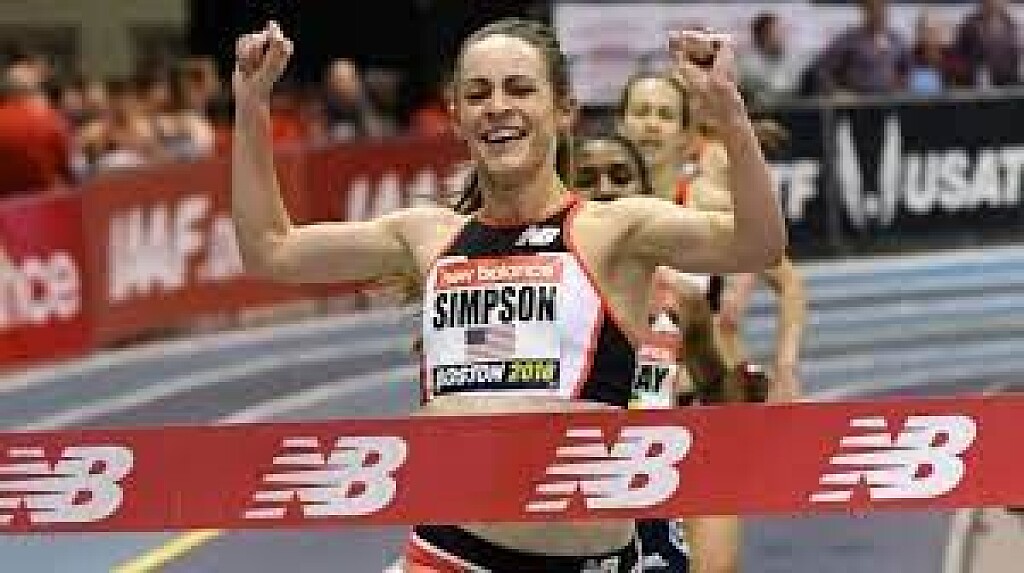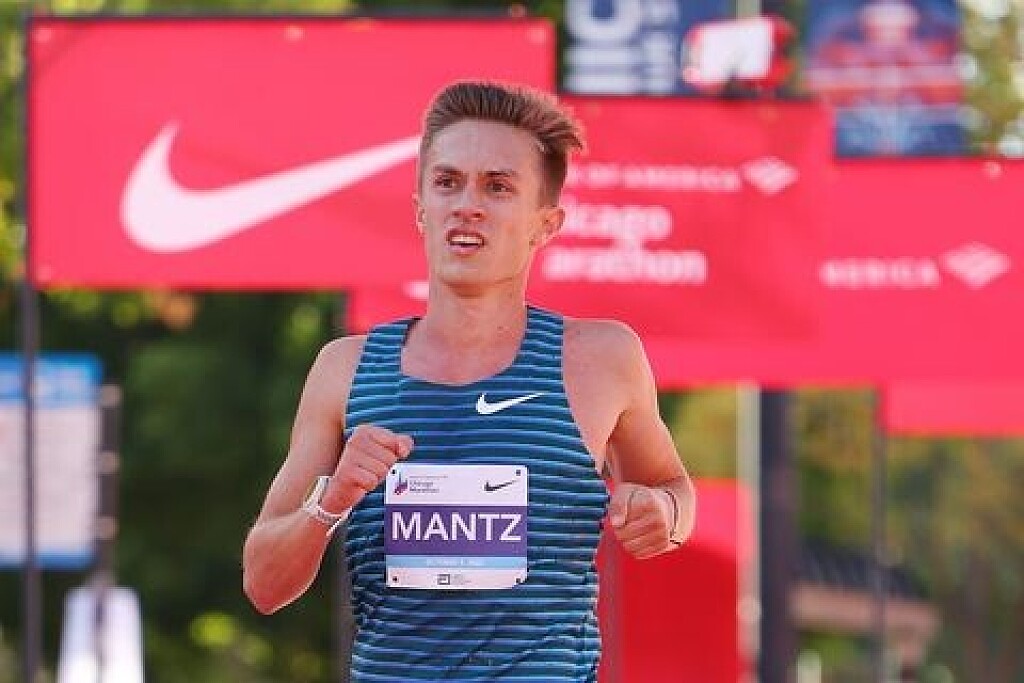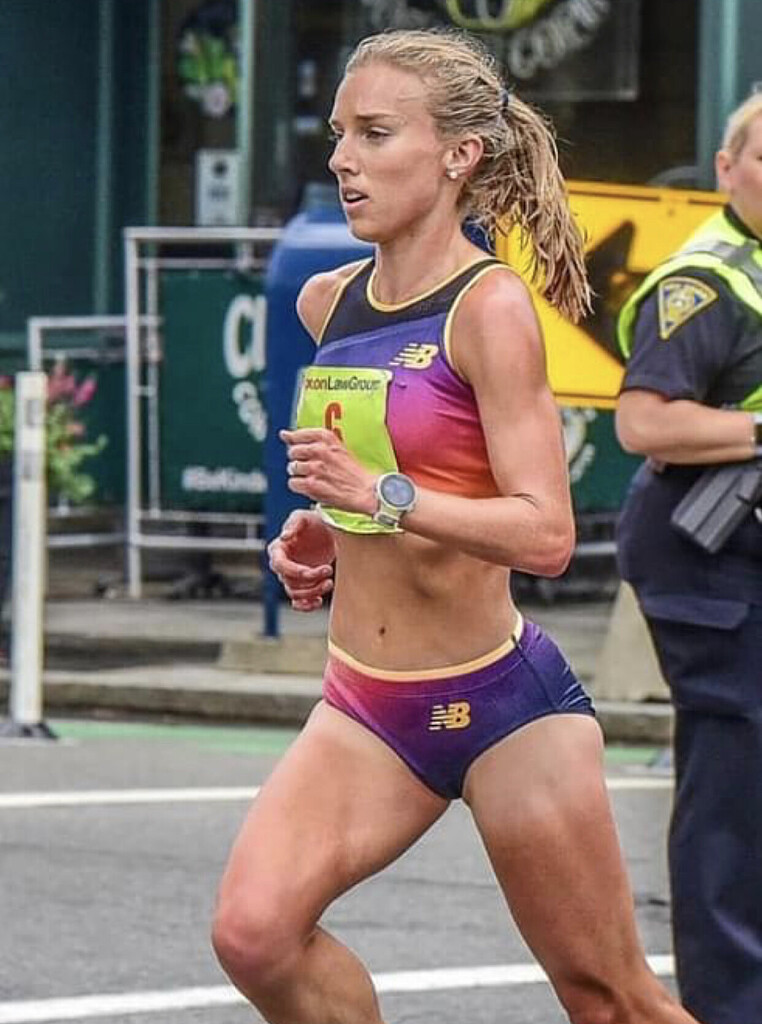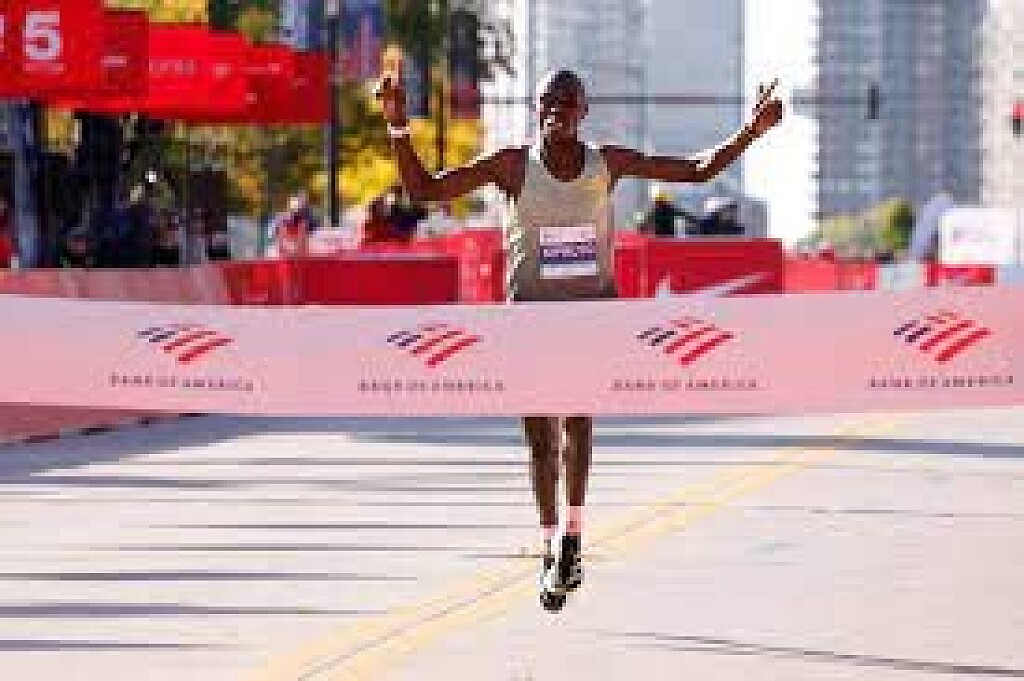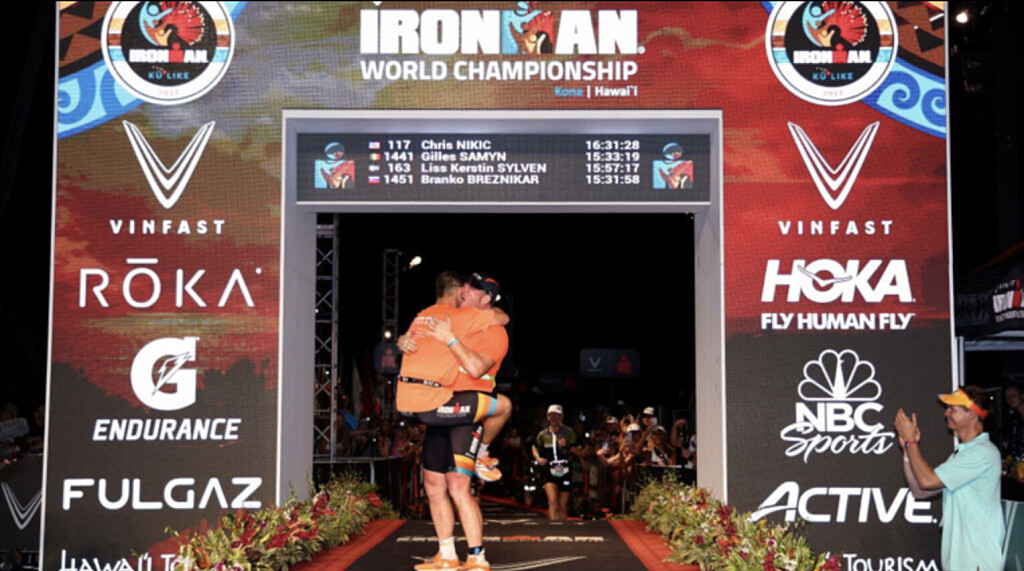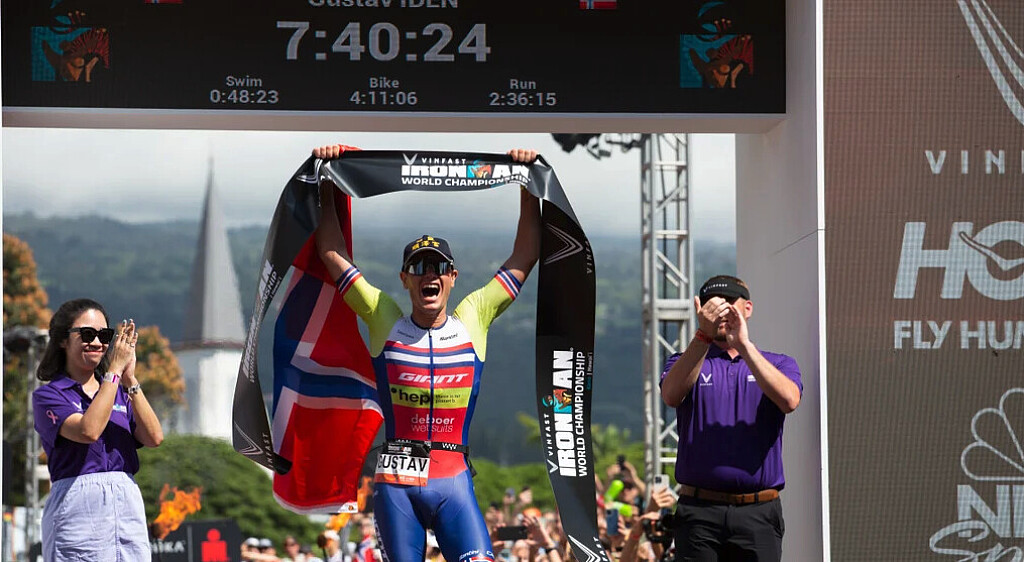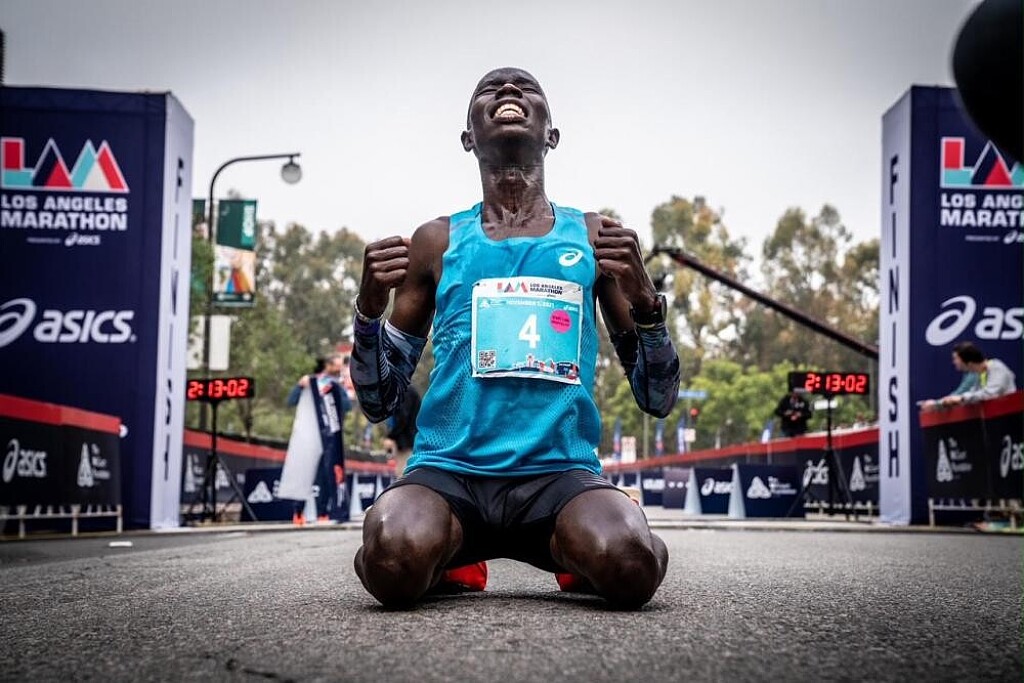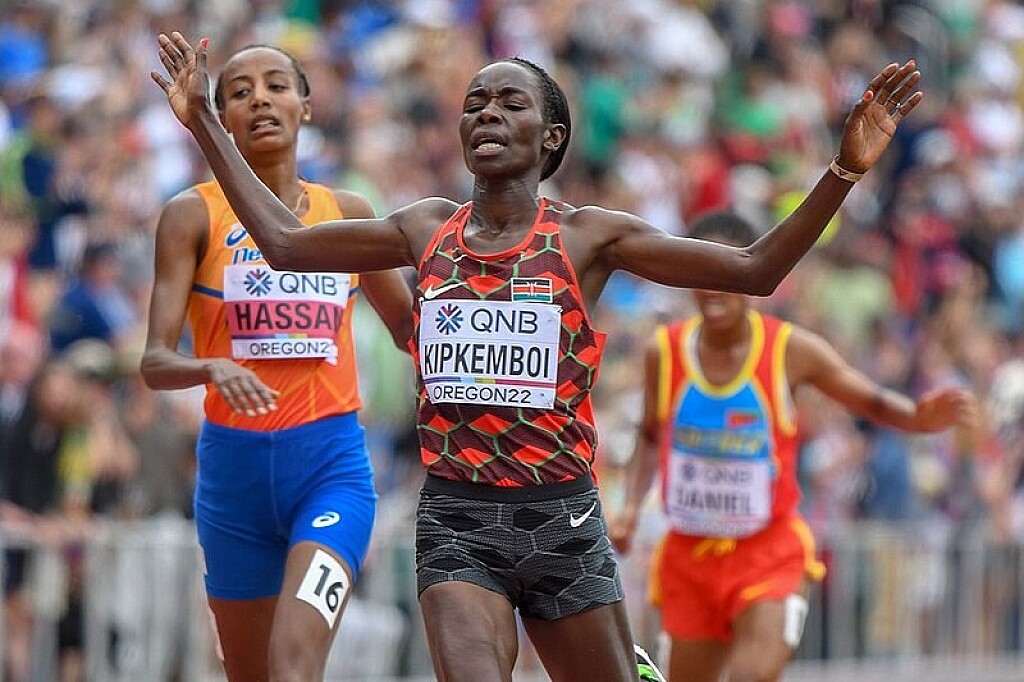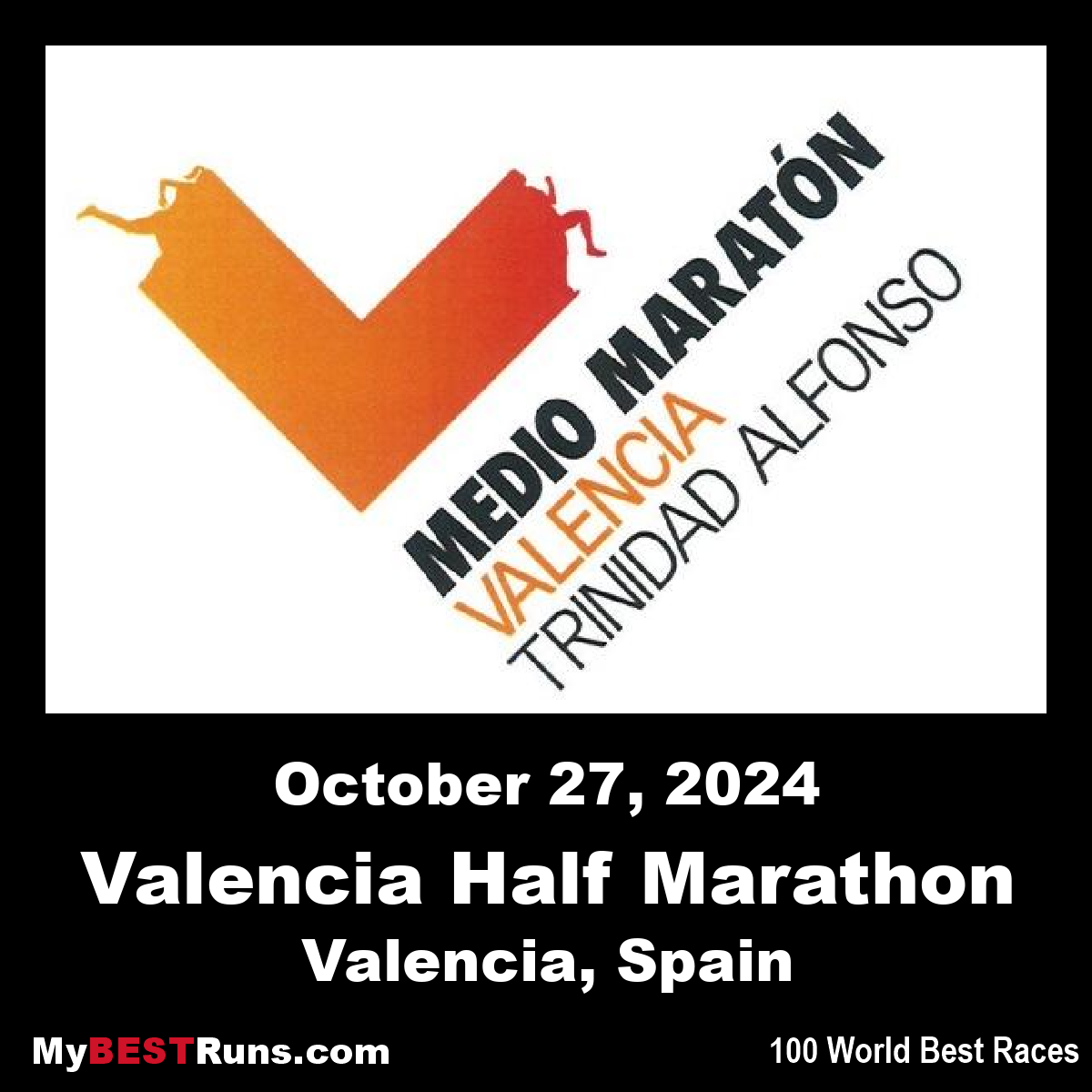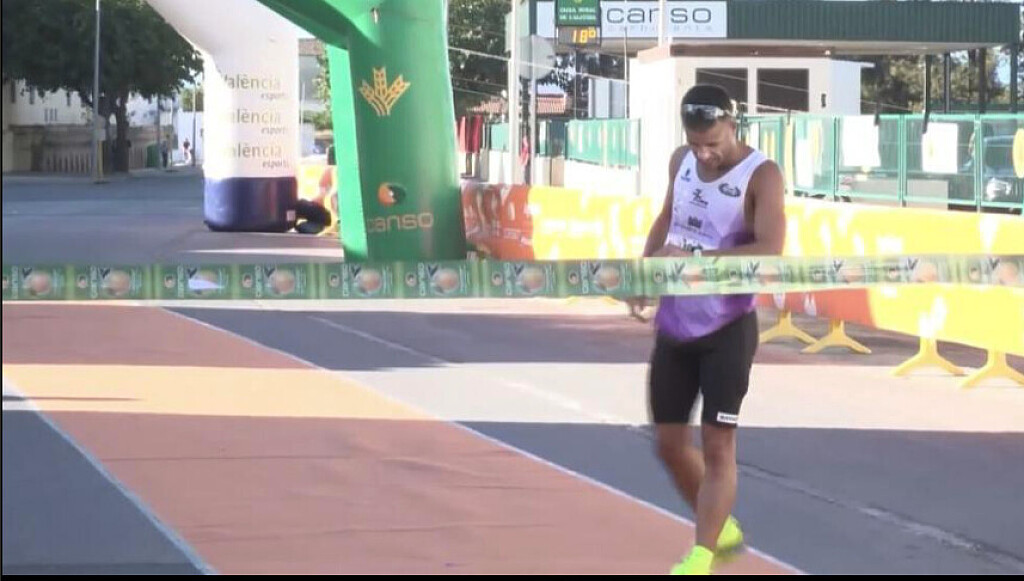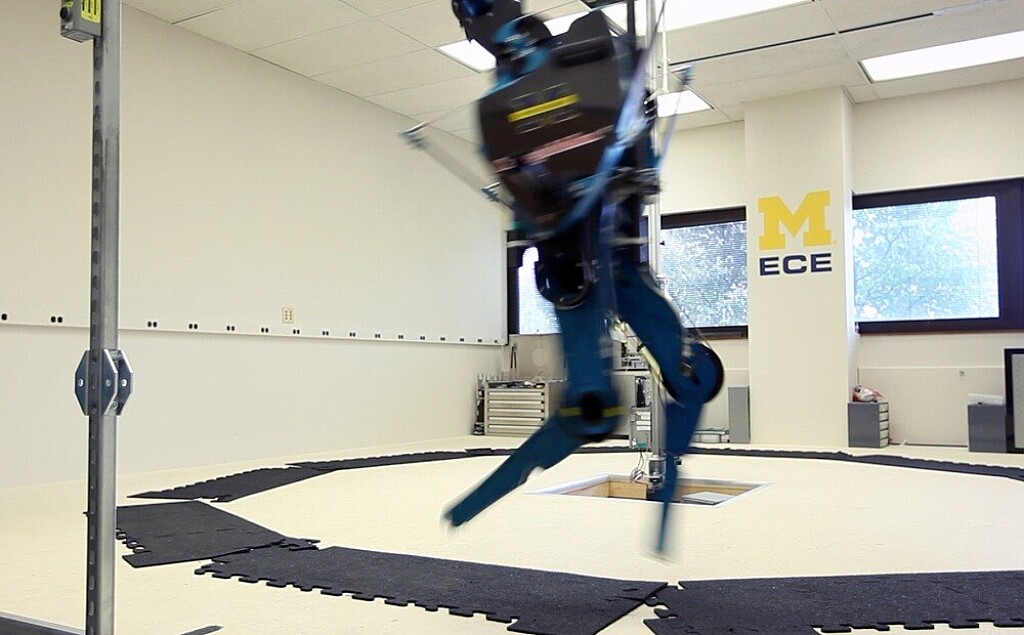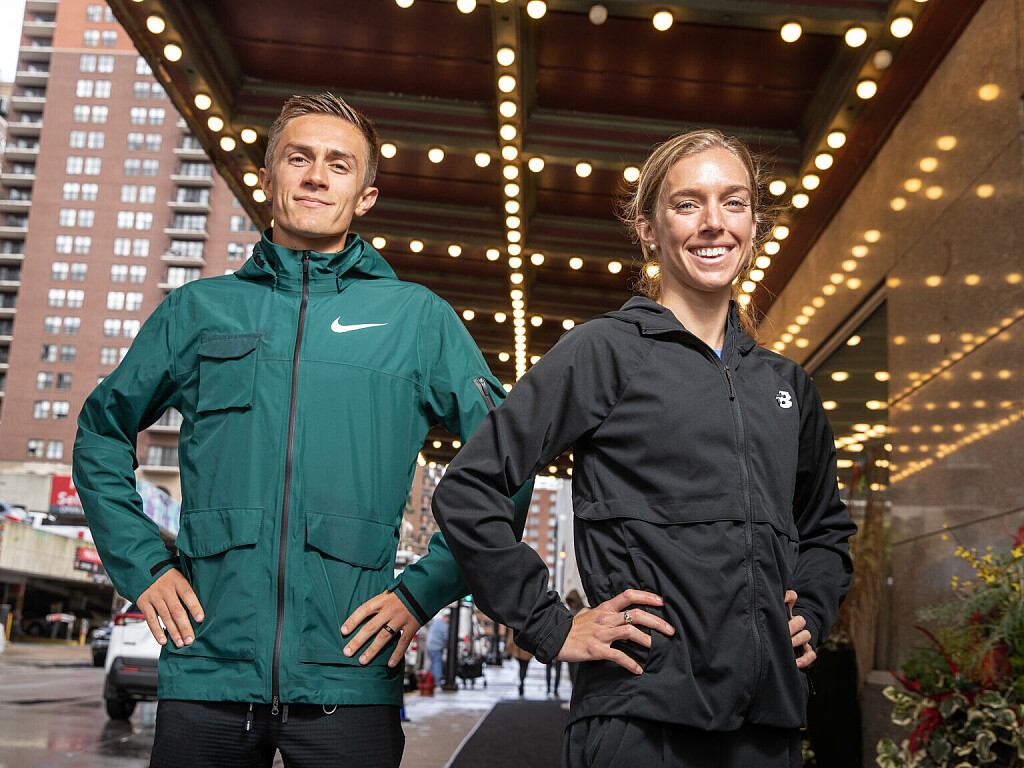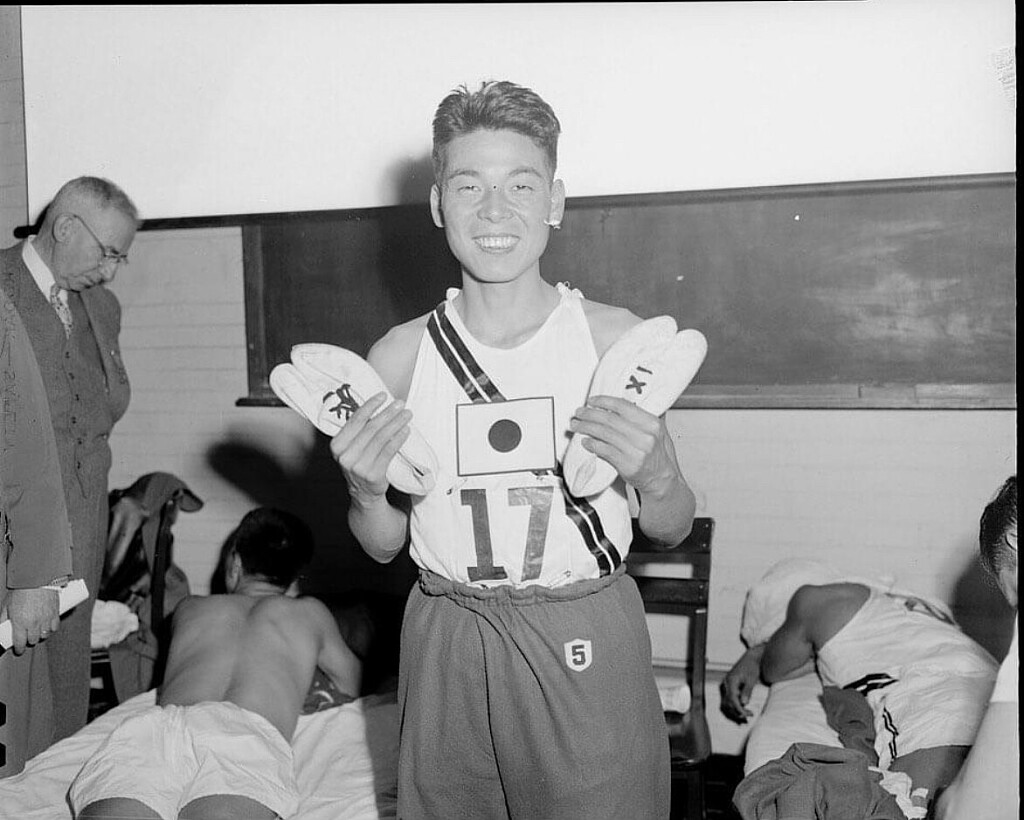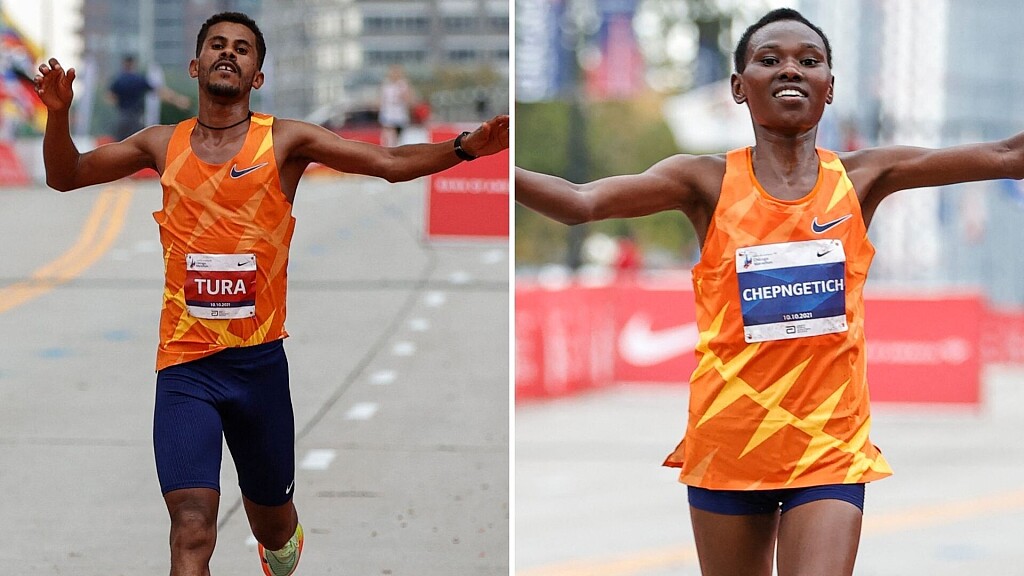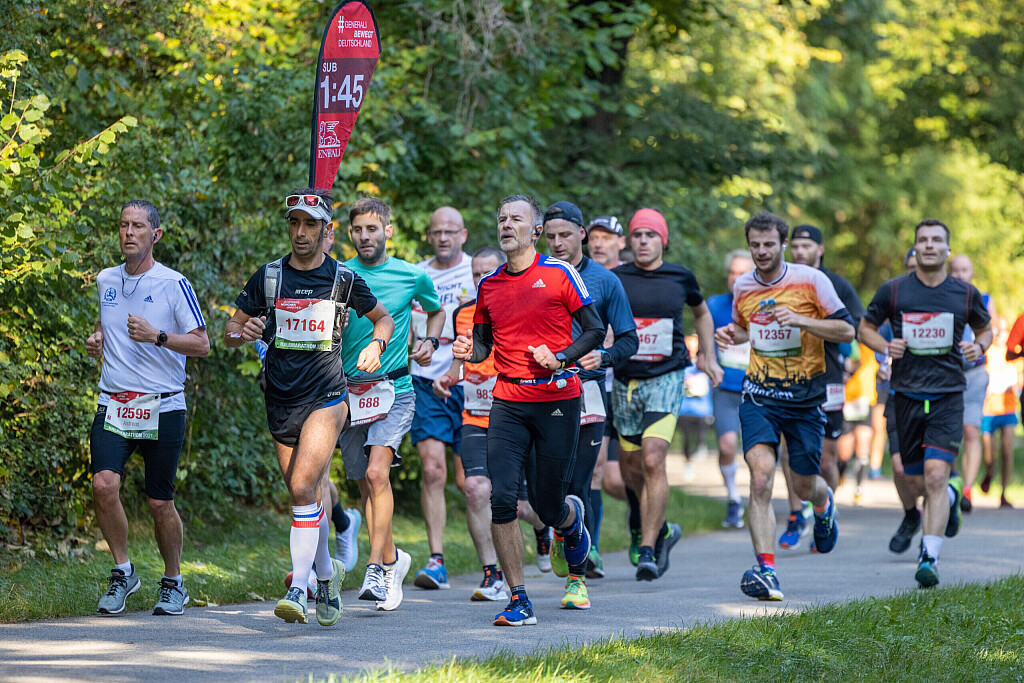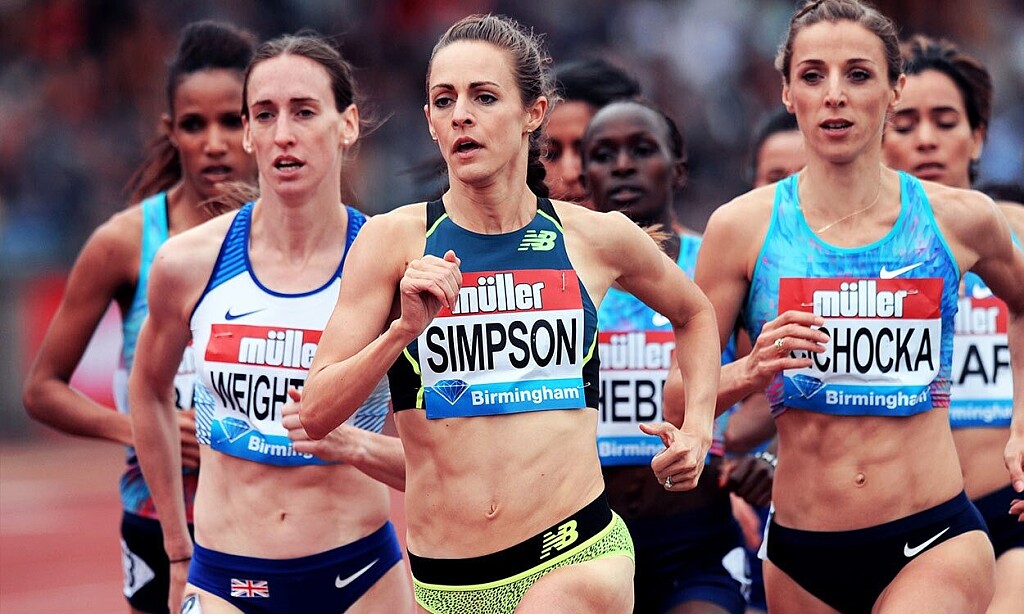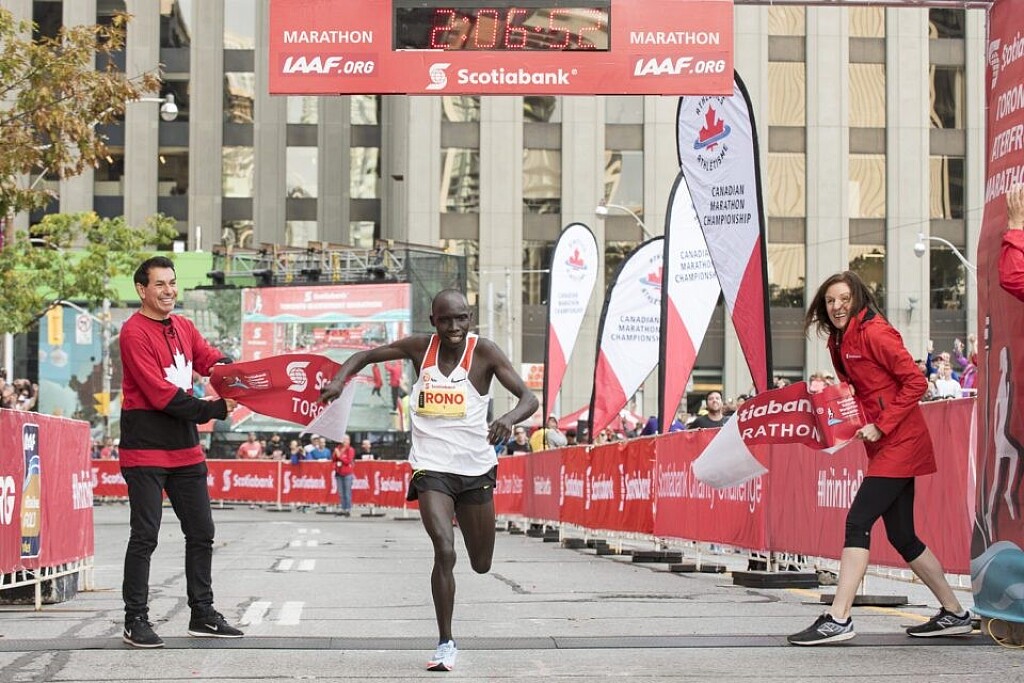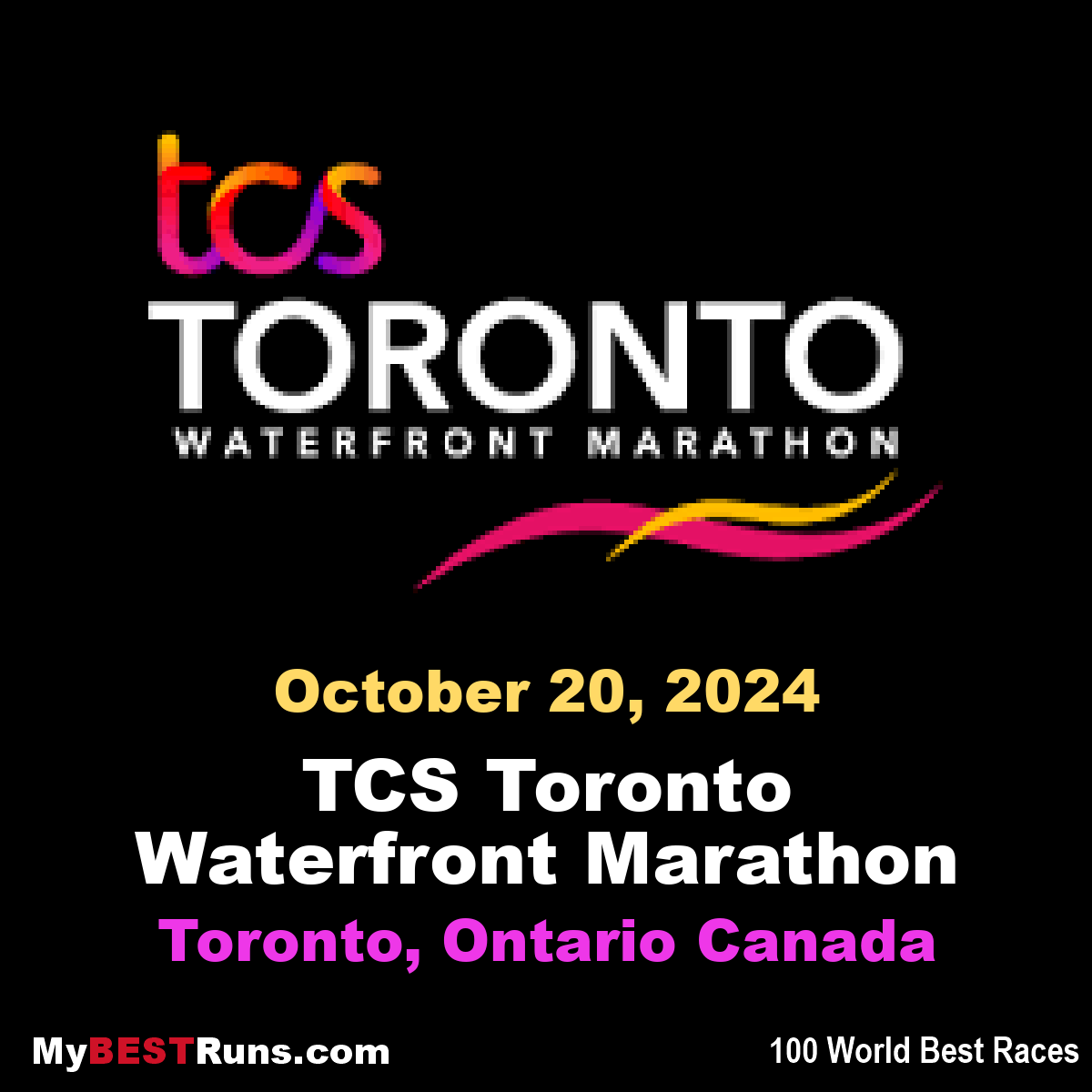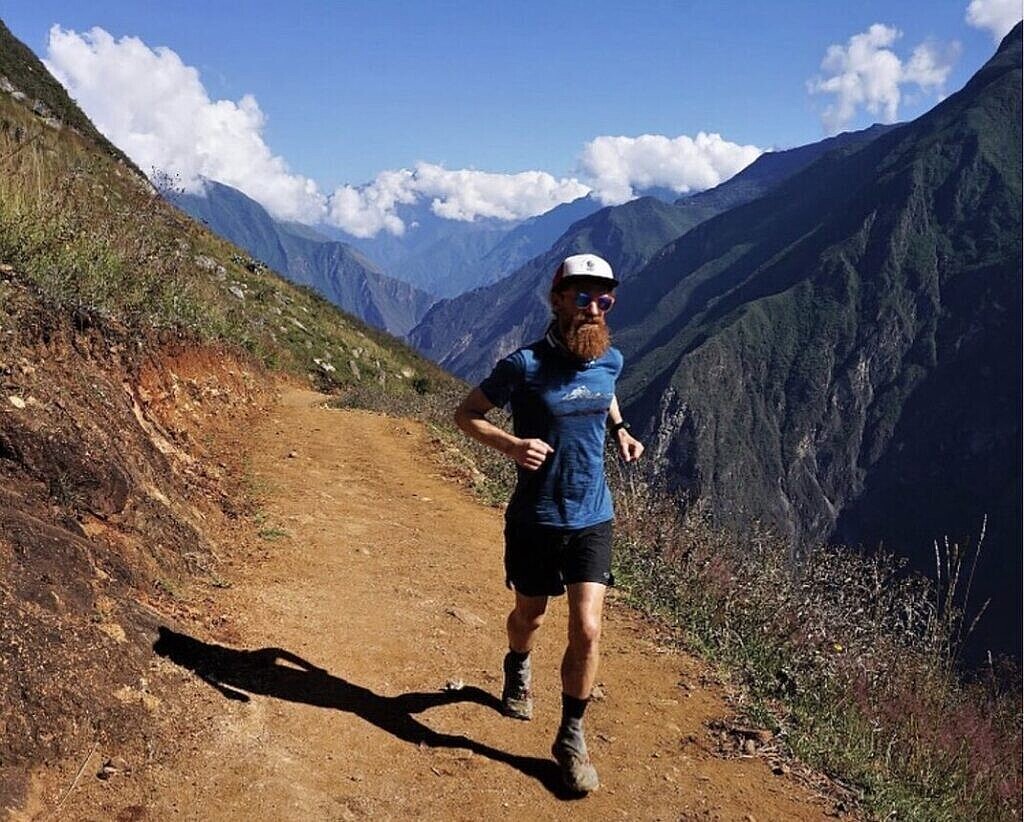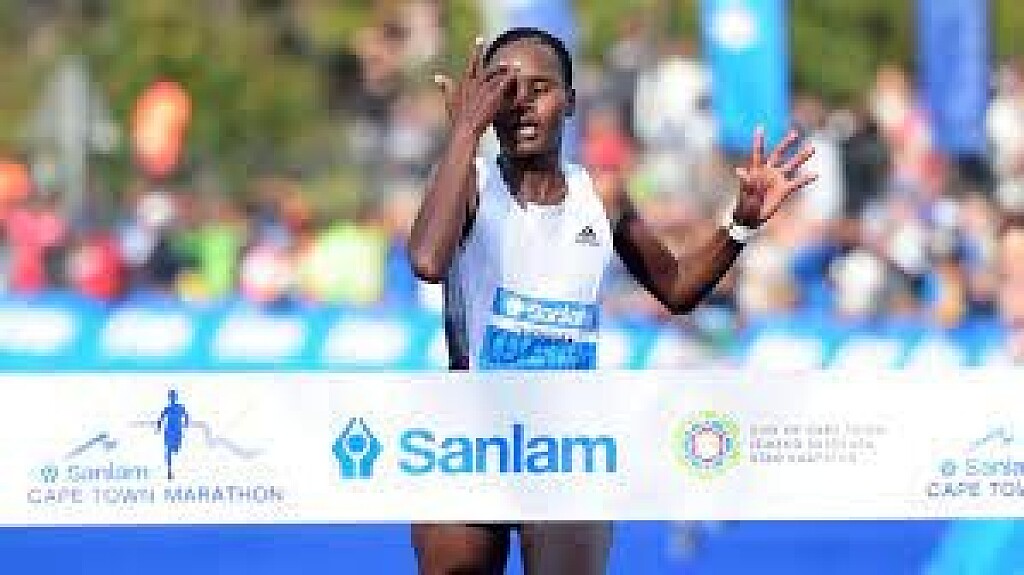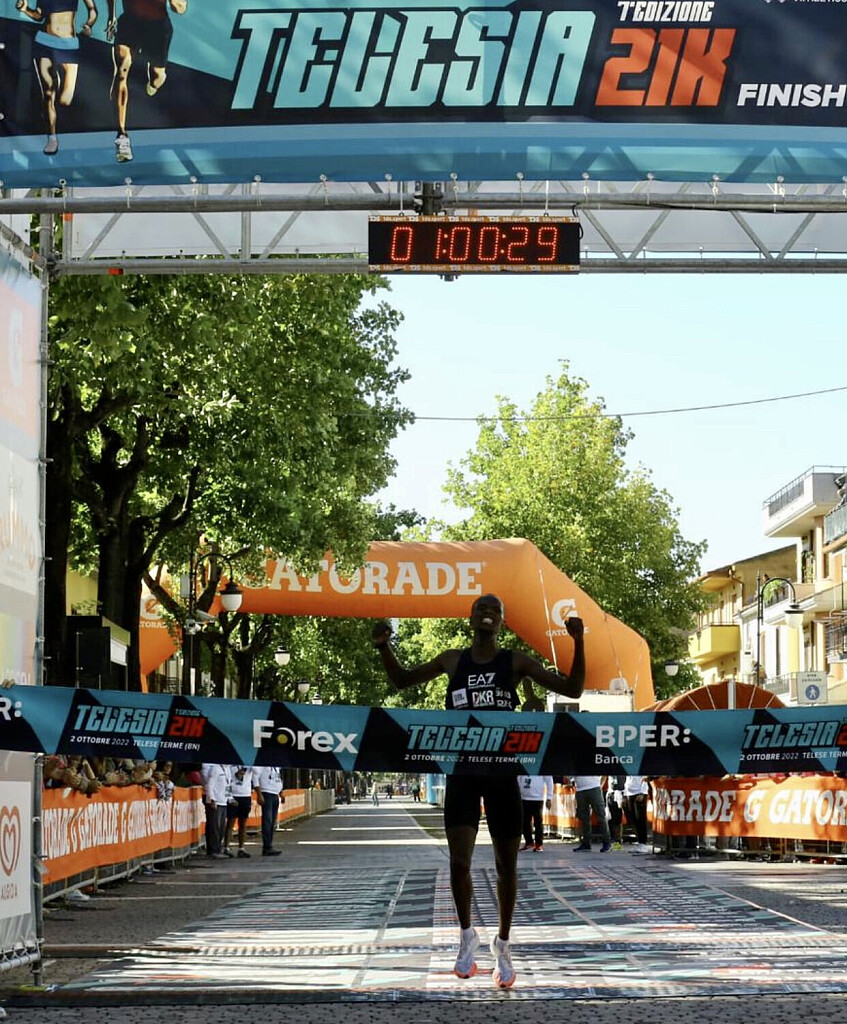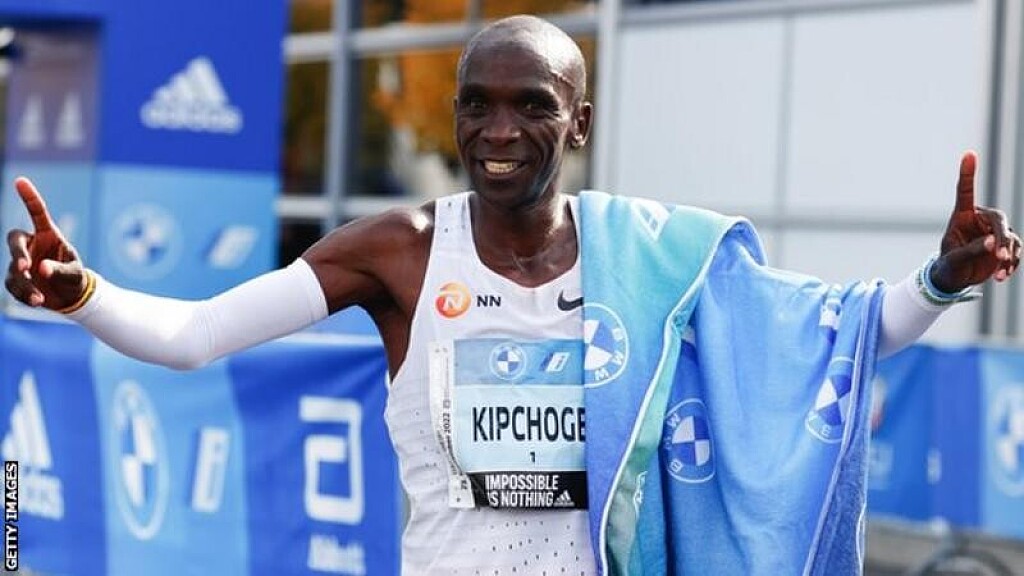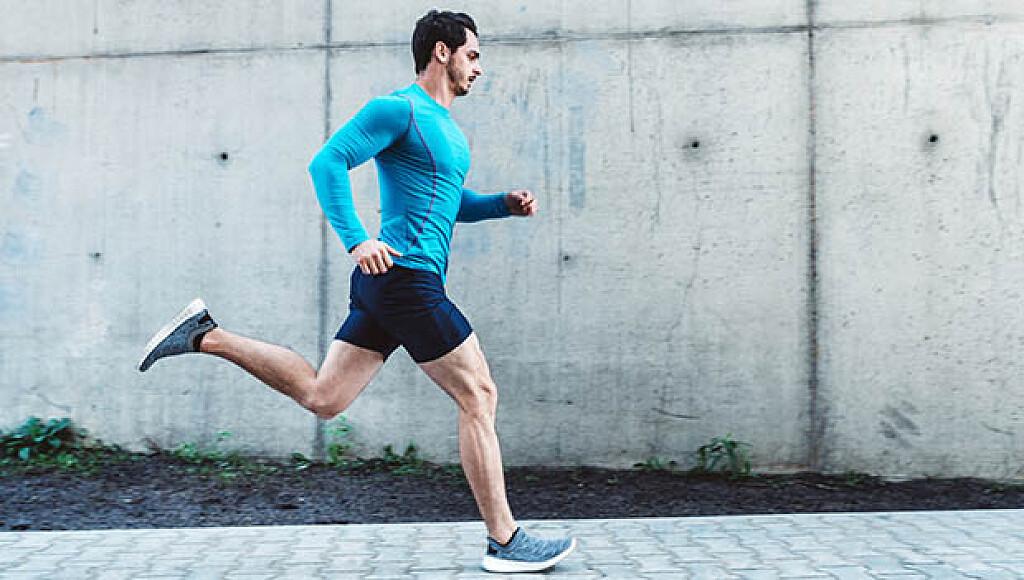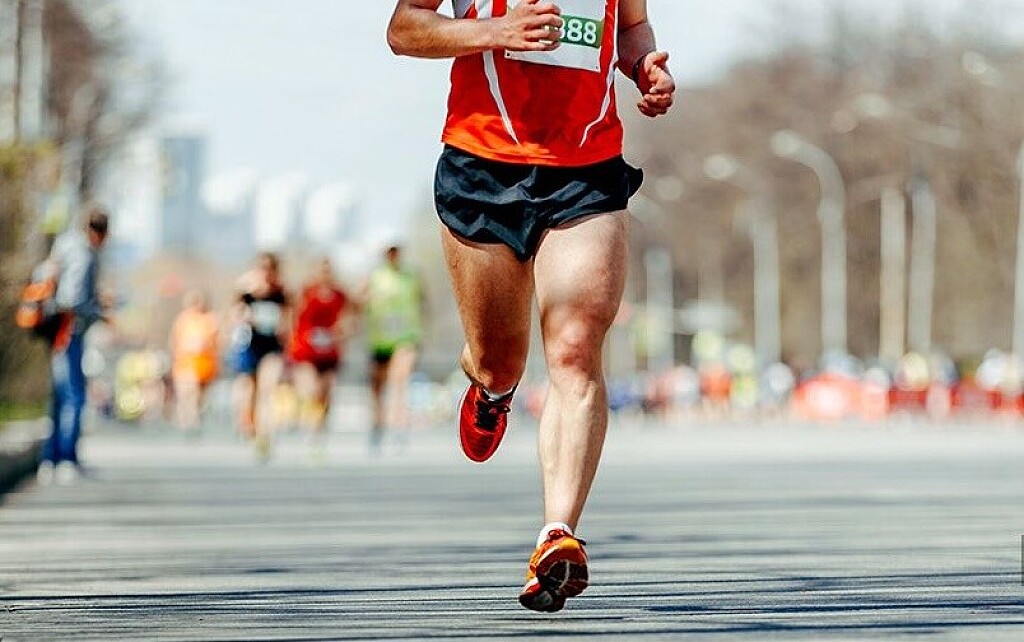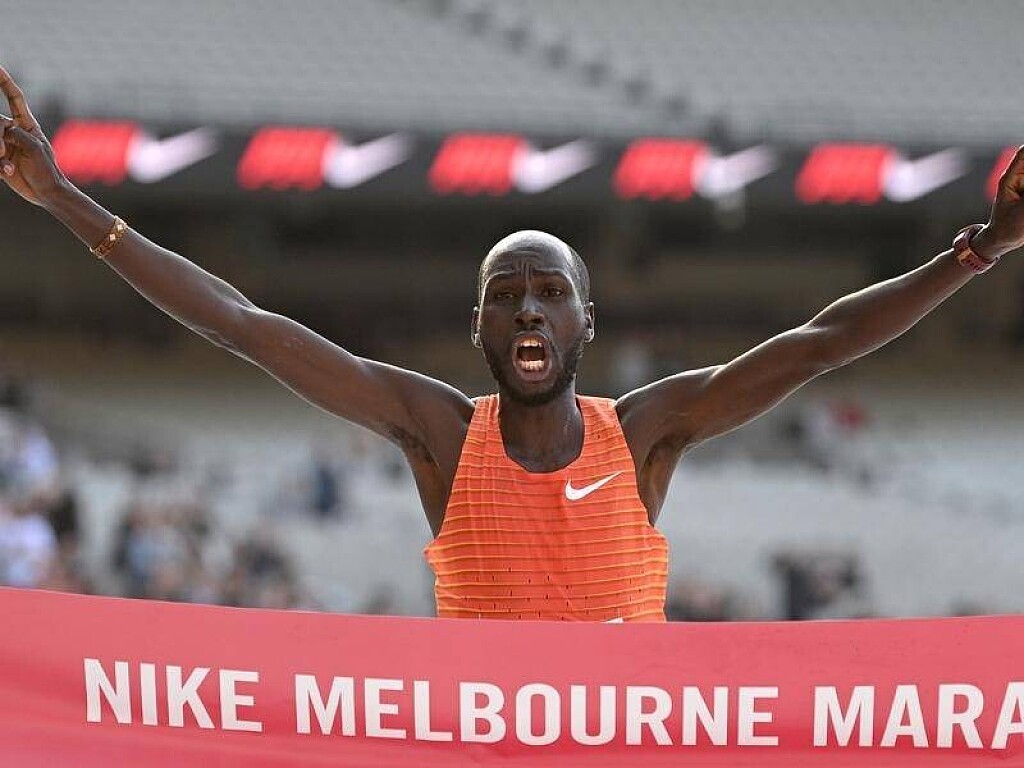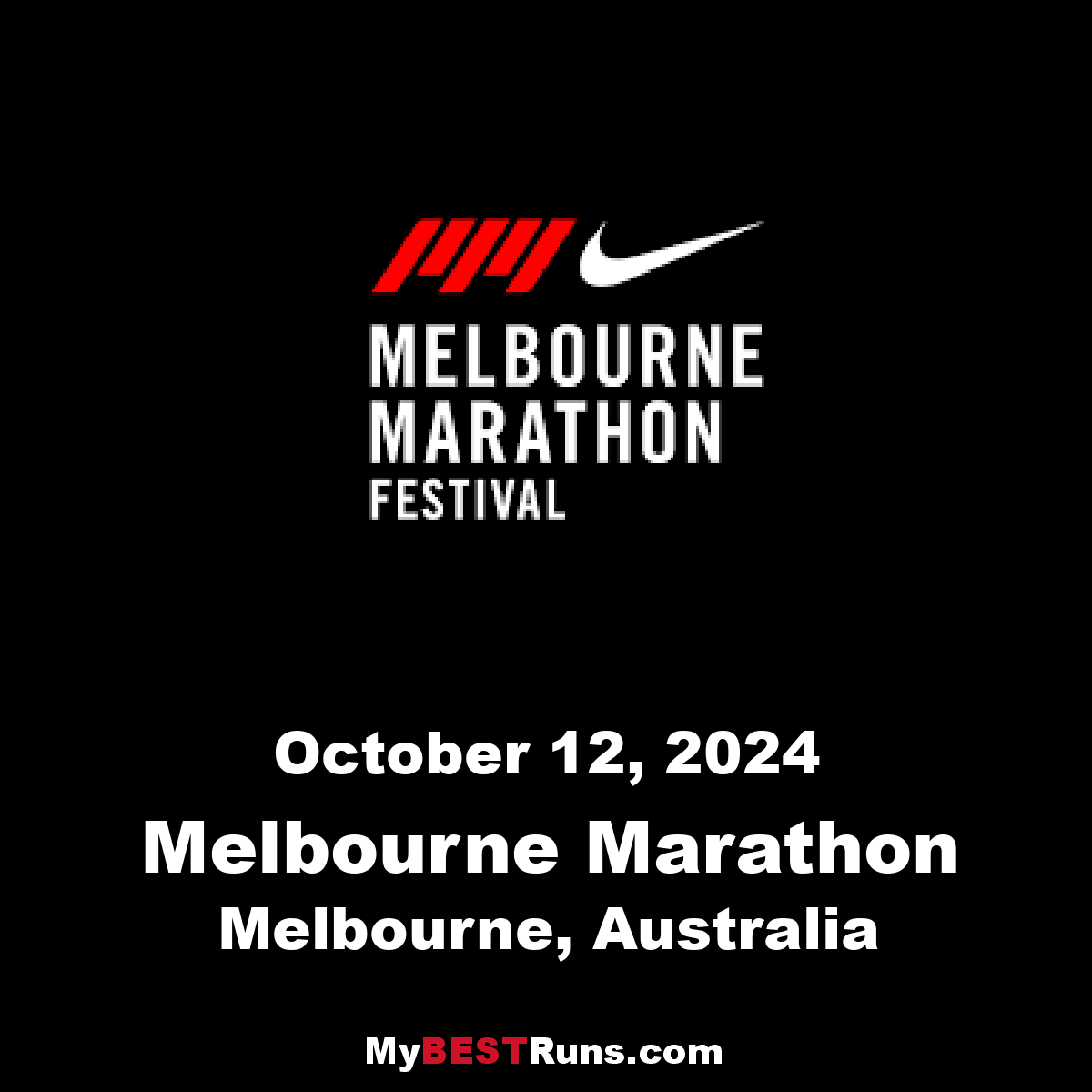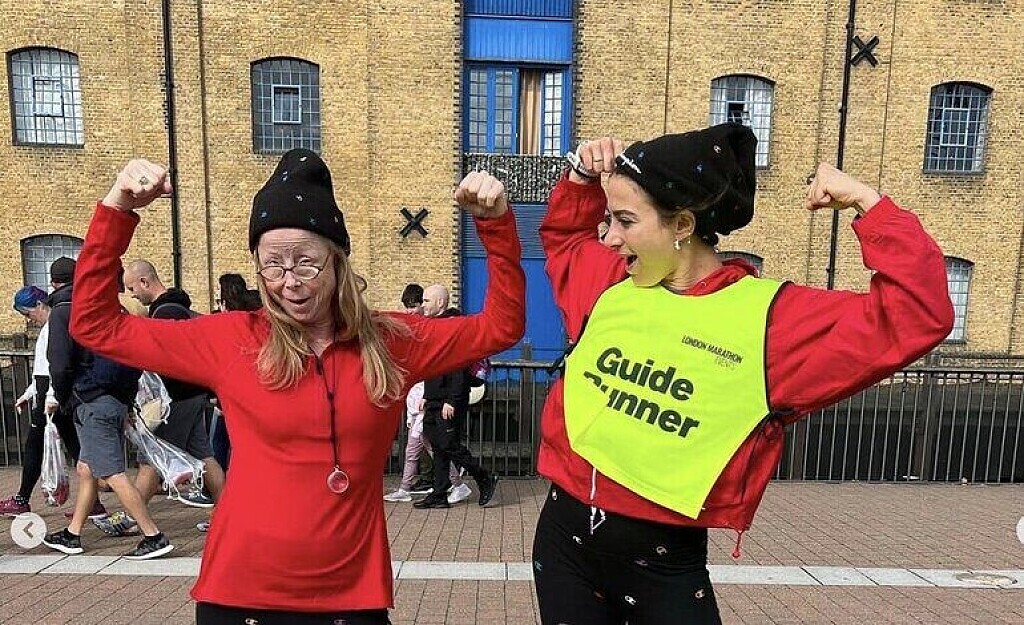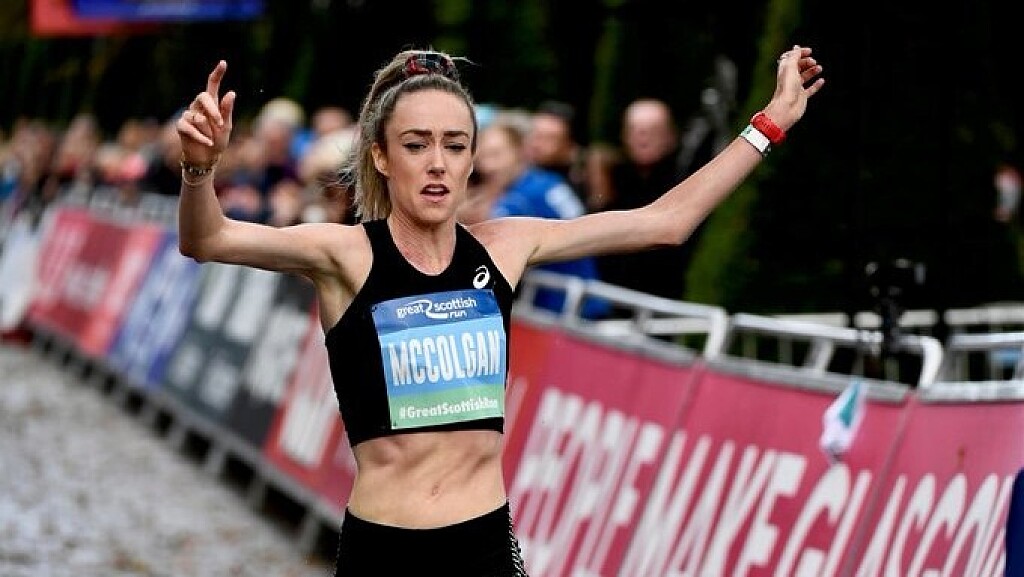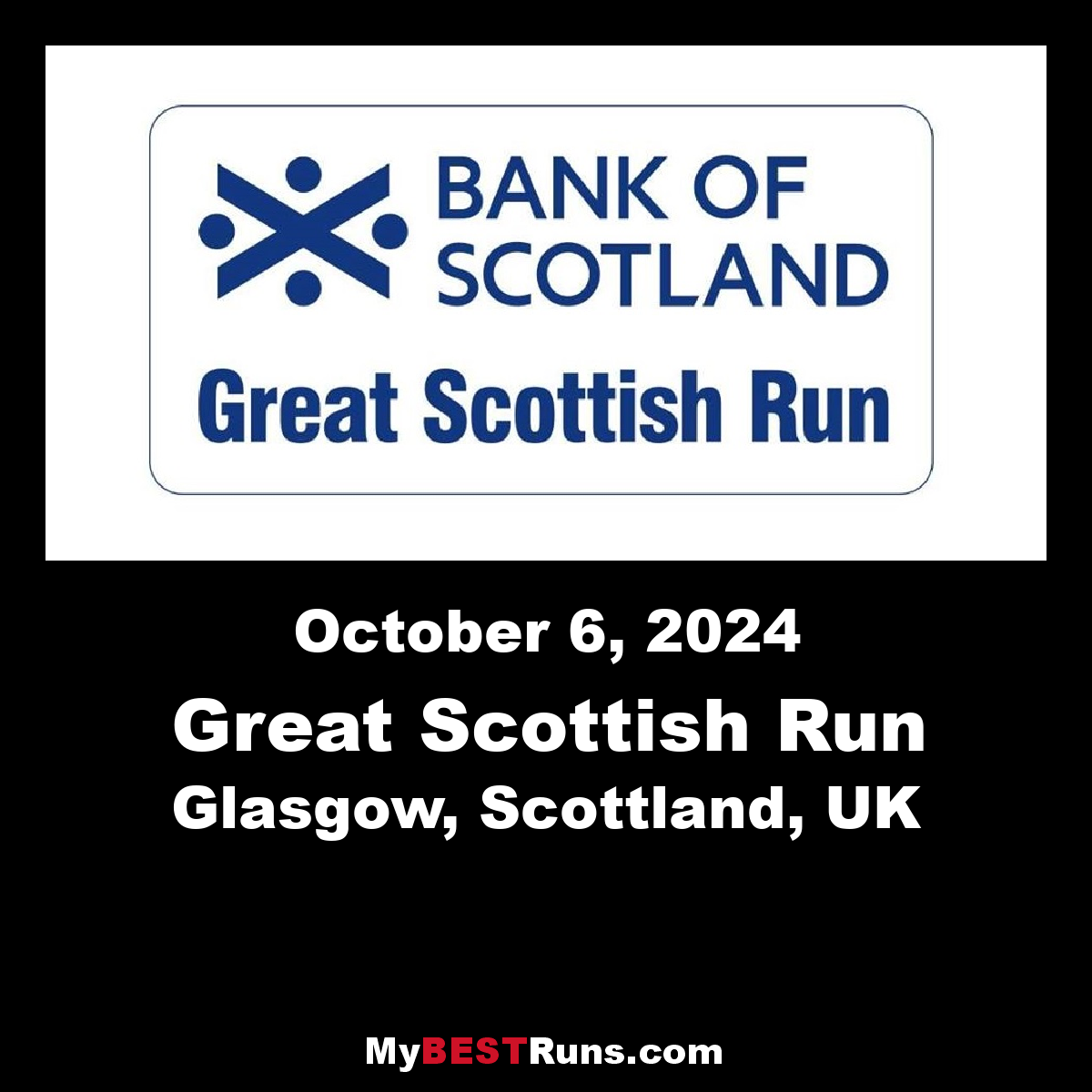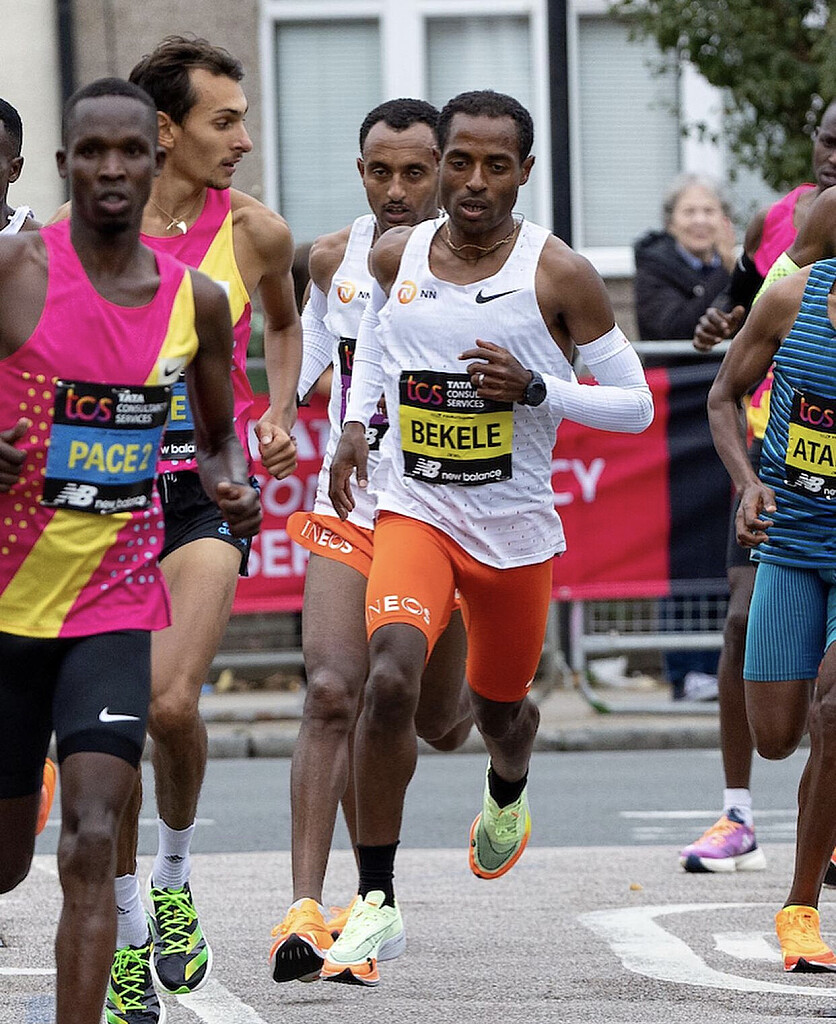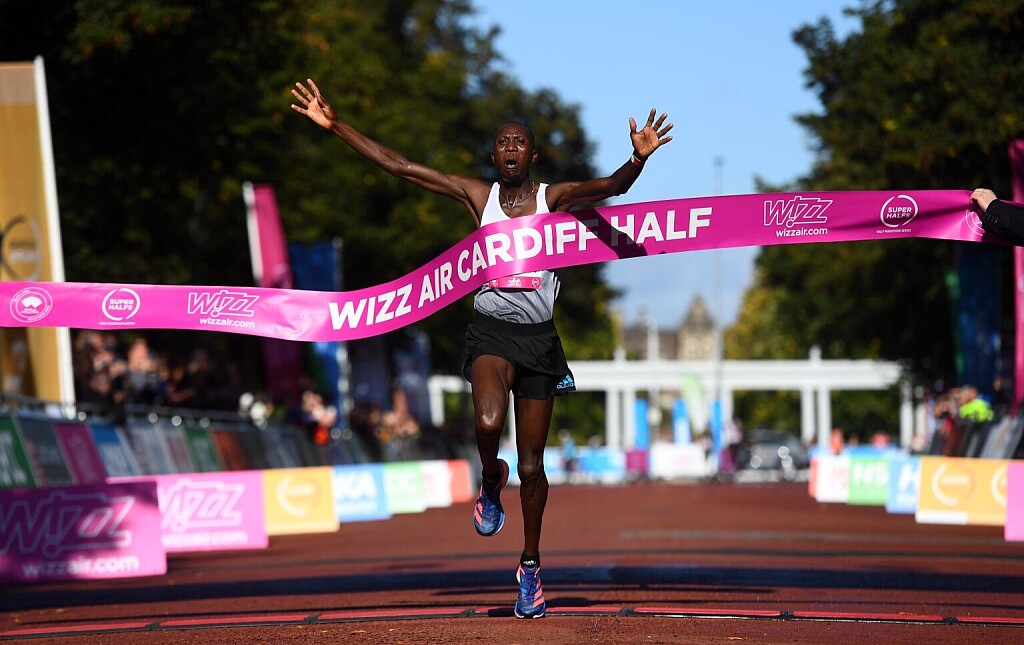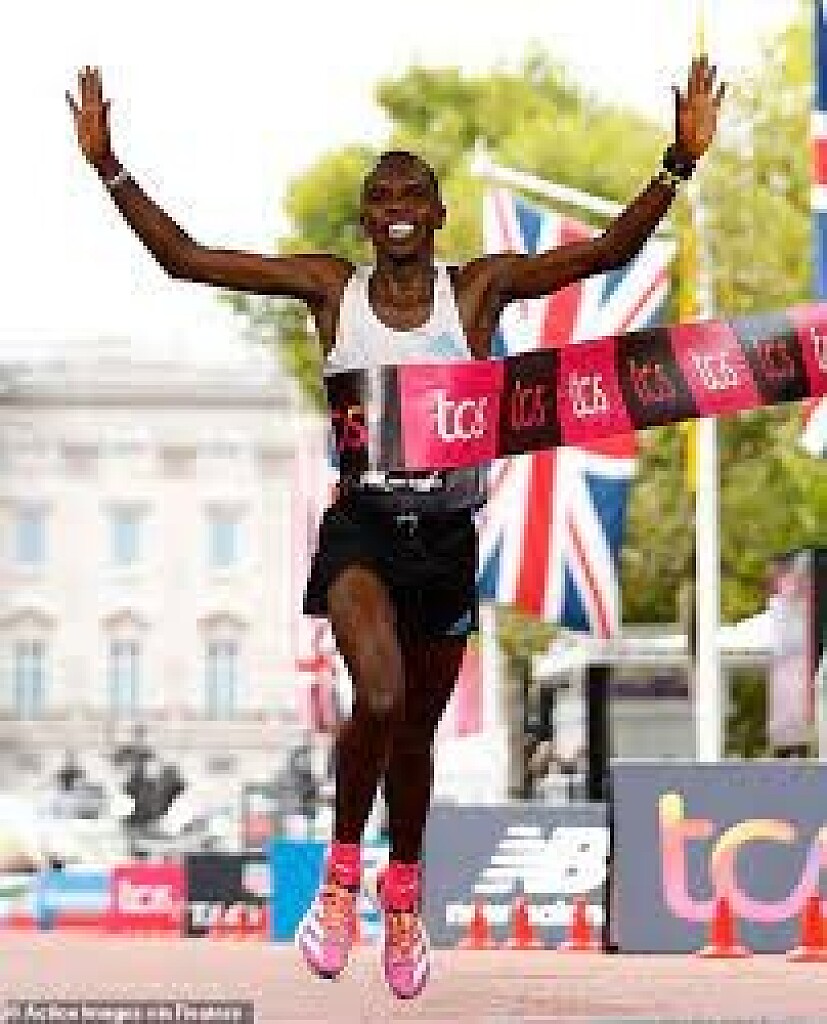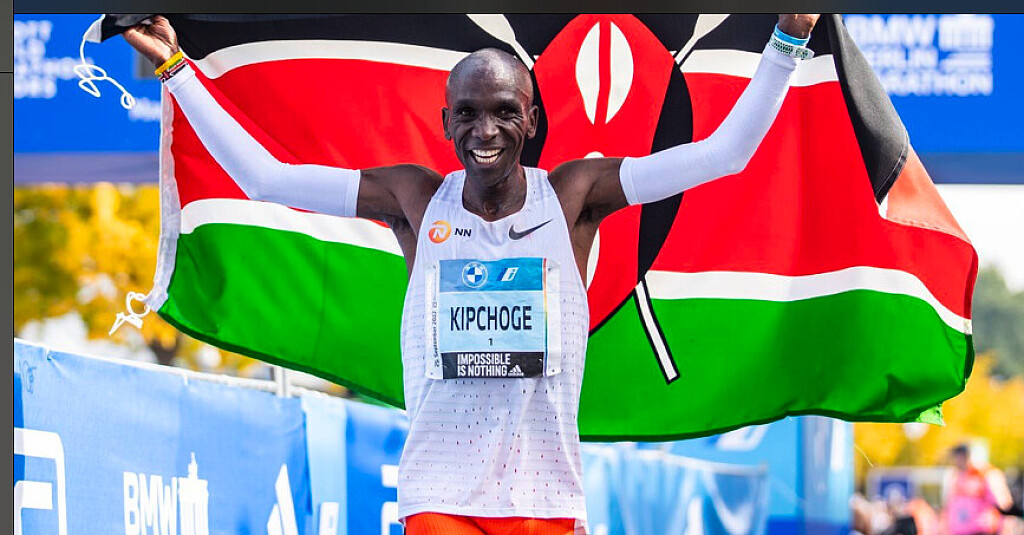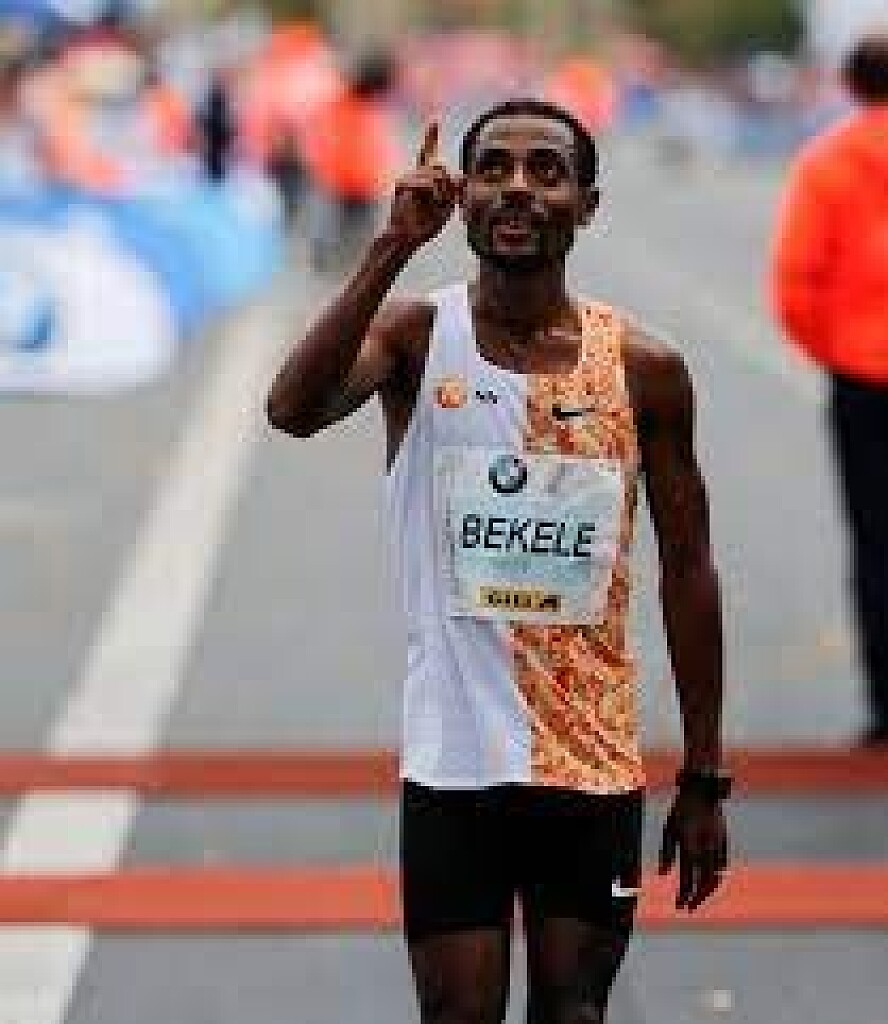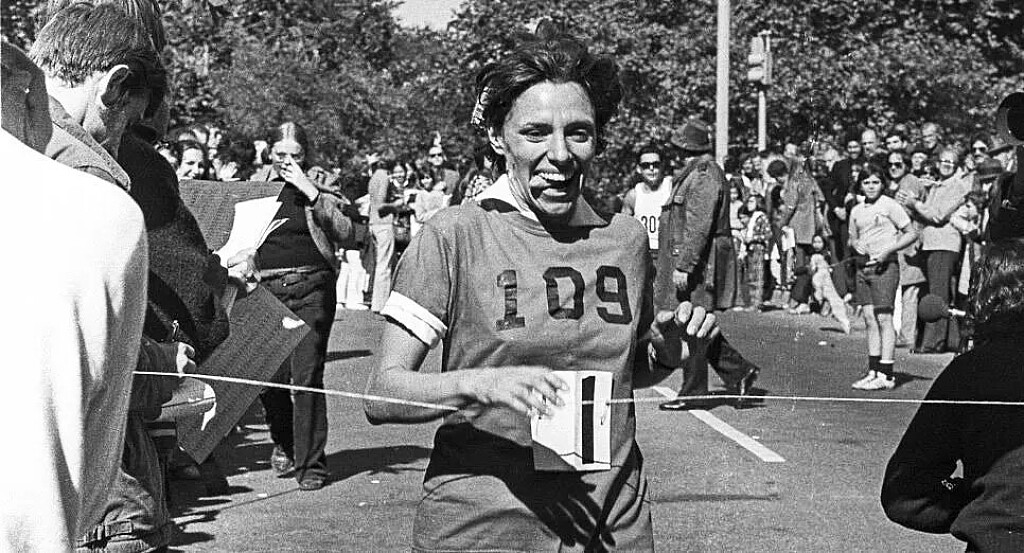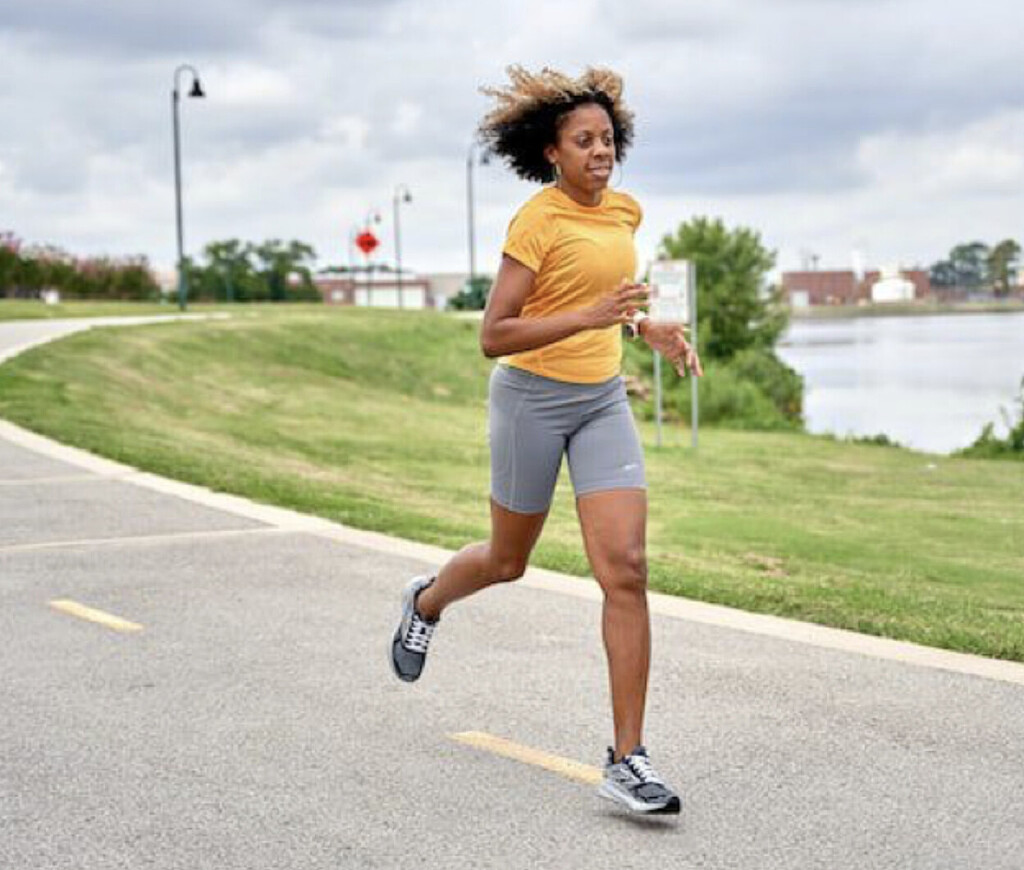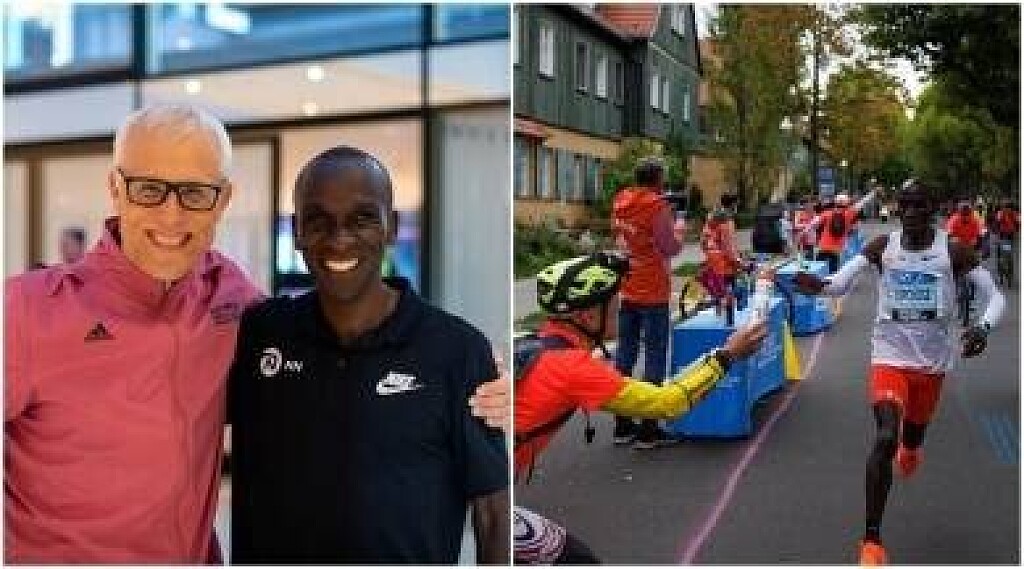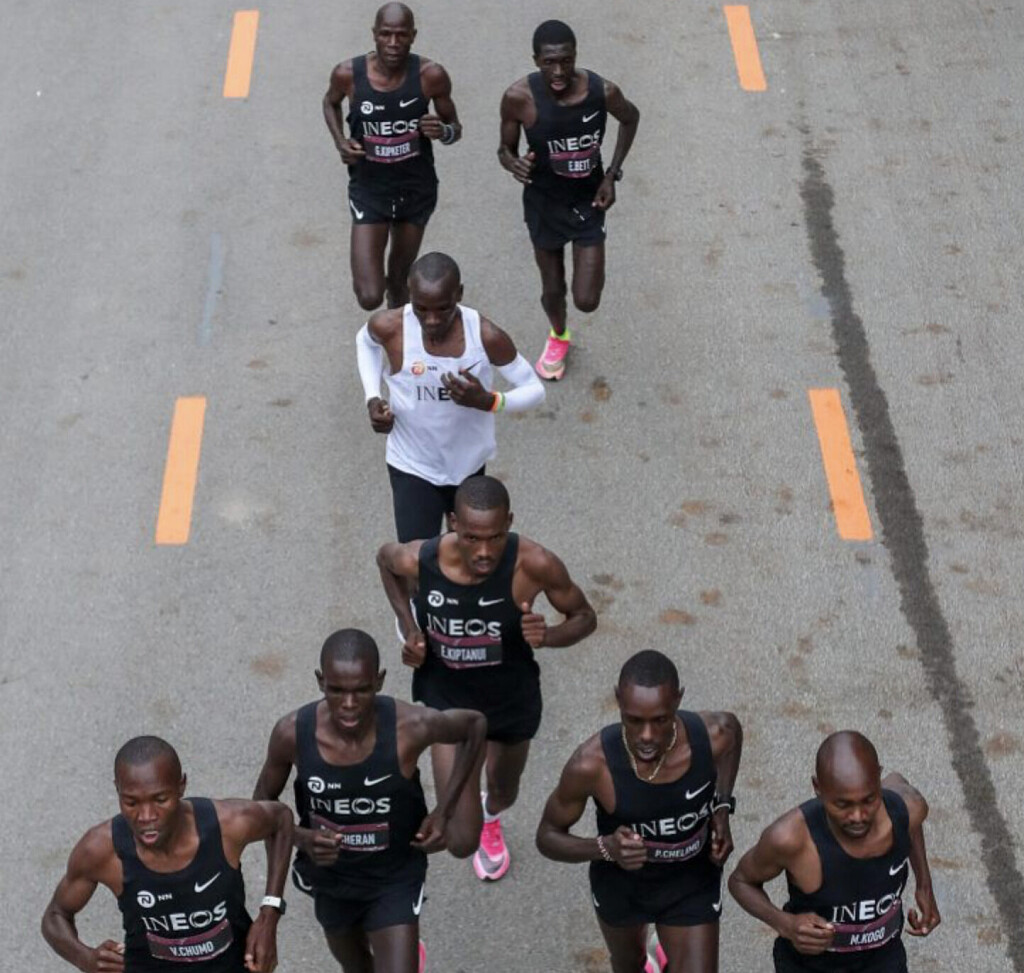Running News Daily
Running News Daily is edited by Bob Anderson in Los Altos California USA and team in Thika Kenya, La Piedad Mexico, Bend Oregon, Chandler Arizona and Monforte da Beira Portugal. Send your news items to bob@mybestruns.com Advertising opportunities available. Train the Kenyan Way at KATA Kenya. (Kenyan Athletics Training Academy) in Thika Kenya. KATA Portugal at Anderson Manor Retreat in central portugal. Learn more about Bob Anderson, MBR publisher and KATA director/owner, take a look at A Long Run the movie covering Bob's 50 race challenge.
Index to Daily Posts · Sign Up For Updates · Run The World Feed
Is Top Miler Jenny Simpson About to Become a Marathoner?
The Olympic medalist signs with Puma and moves to the roads—although she still hits the track in spikes.
Jenny Simpson refuses to come out and say she’s training for a marathon. But all signs point to her training for a marathon.

She’s consistently running the highest mileage of her life (85 miles per week). And she has a new sponsor, Puma.
“It’s correct that my emphasis is on the roads,” she said on an October 6 call with Runner’s World. “These next few years is an exploration in the distances and some of the challenges in running that I haven’t tried yet. That’s what I’m most excited about.”
Simpson, 36, has been a stalwart on the track since she was in college at the University of Colorado, going to Europe every summer and building her training around Olympics and World Championships cycles. Between 2011 and 2017, she won four global medals: a gold and two silvers in the World Championships 1500 meters, and Olympic bronze in the same event.
Through 2019, she made every U.S. team going back to 2007. But the pandemic put a sudden halt to that streak. In 2021, she made the finals of the 1500 meters at the Olympic Trials for the postponed Games in Tokyo, but she finished 10th.
“I had such an incredible run on the track,” Simpson said. “And then, just like a lot of people starting in 2020, the vision that I had for those next few years of my career got derailed.”

That fall, she began her transition to the roads, racing the Cherry Blossom 10-miler and finishing second in a sprint finish to Nell Rojas. But at the end of the year, Simpson’s life was upended.
Simpson suffered a stress reaction in her right hip, which took a long time to heal. She was diagnosed with a sports hernia in one of her adductor muscles, which pulled tissue away from one of the pubic bones. “A lovely place to be injured and have people poking and prodding,” Simpson said.
It was by far the most serious injury of her career, but she was able to avoid surgery with hours of physical therapy, working on her adductors, hamstrings, core, and glutes—anything near the hips. When she returned to running, she had several months of stopping and starting until she was finally pain-free.
At the same time, she learned that her future with New Balance—the company that had sponsored her since the beginning of 2010—was not secure.
And then on December 30, 2021, a wildfire broke out close to Simpson’s home, an old schoolhouse in South Boulder, Colorado, that she shares with her husband, Jason, and their dog. They had to flee with little warning. Most of the Simpsons’ immediate neighbors lost their homes, and entire neighborhoods in the bordering towns of Louisville and Superior were destroyed. The couple was displaced for three months while damage was repaired.
“So many things in my life were disrupted at the same time,” she said. “Between the fire and no longer having a sponsor and an injury, all those things swallowed up the first half of my 2022.”
By late spring, things were starting to come around. The Simpsons were back in their home. Her injury was healing. And sponsors were still interested. Simpson, who had represented herself for years, enlisted an agent, Hawi Keflezighi, to help her with a new shoe deal.
“Parting ways with New Balance will be one of the great heartbreaks of my life,” she said. “It was really hard. I didn’t want to make a change. But life is full of surprises. The change to doing a different event felt like this is going to give me some new energy and a new scene. Now that I’m on the other side of a contract with a new brand, I feel very much the same way. Puma believed in what I want to do. That’s really invigorating.”
Puma has made a substantial investment in American women’s distance running over the past two years. The company has added marathoners Molly Seidel, Annie Frisbie, and Dakotah Lindwurm to its roster, and funds a Puma training group with Fiona O’Keeffe and others in North Carolina. But it’s not just 20-somethings. They’ve also signed track runner turned marathoner Sara Vaughn, and now Simpson.
To be clear, Simpson doesn’t intend to just dabble in the roads. She wants to be excellent. And that’s the only thing that’s keeping her from saying “yes,” she’s doing a marathon.
“I will do one if I believe I can be competitive at it,” she said. “We don’t have enough information yet to know if I’ll be really good at it. I have the desire to do it, if my body and mind can handle it.”
Simpson is relishing the chance to reimagine what the end of her career might look like. For a long time, she said, she laser focused on the 1500 meters (and yes, she still spikes up for track workouts). “I’ve been one thing, a very good one thing, for a long time,” she said.
But now it’s time to try something different. She sees American marathoners running well into their late 30s, and doing it after having children, and she realizes she has to adjust her own thinking about what’s possible.
“This new wave of women racing later and having families and racing competitively at the same time, I feel like people just don’t remember how much of a zero option that was when I was younger,” she said. “And it’s not just the world is progressing. I have to progress. I don’t have to just pack it in.”
Simpson said she wants to show that she can try to be good at something else.
“I don’t know if I’m going to be great at the marathon,” she said, “but I really want to try.”
MORE FROM RUNNER'S WORLD ON APPLE NEWS
(10/10/2022) ⚡AMPby Runner’s World
Big day for American marathons in Chicago with first timer Conner Mantz leading the pack
All eyes were on marathon first-timer Mantz, who many believed would take down the American marathon debut record of 2:07:56 set by Leonard Korir in 2019. Mantz, who owns a half marathon personal best of 1:00:55, crossed the midpoint on pace, 1:03:45. But he wasn’t the lone American at that point—Frank Lara was running stride-for-stride with the former Brigham Young University athlete.
“Frank’s a tough runner. He’s one of my favorite competitors. He’s somebody who’s willing to get out there and grind,” Mantz said. “I was expecting him to finish with me because we’ve had a lot of races together where we’ve been within a few seconds of one another.”
Unfortunately, Lara faded hard, covering 35K to 40K in a difficult 19:53, but Mantz kept close to record pace. He ultimately fell 20 seconds short, clocking 2:08:16. While disappointed, the 25-year-old said he was grateful for the experience.
Four American men ran sub-2:10, and while their performance didn’t quite replicate 2019 success, the foursome of Mantz, Zachery Panning, Matt McDonald, and Nicolas Montanez all recorded new personal bests.

Mantz earned $15,000 for being the top American finisher—an early nuptial gift, as he gets married next weekend.
(10/09/2022) ⚡AMPBank of America Chicago
Running the Bank of America Chicago Marathon is the pinnacle of achievement for elite athletes and everyday runners alike. On race day, runners from all 50 states and more than 100 countries will set out to accomplish a personal dream by reaching the finish line in Grant Park. The Bank of America Chicago Marathon is known for its flat and...
more...Emily Sisson sets a new American record in the marathon today in Chicago. clocking 2:18:29!
Three days shy of her 31st birthday and with only one previous marathon on her resume, Emily Sisson took to the streets of Chicago and lowered the American women’s marathon record by 43 seconds, becoming the first American woman to run a marathon in less than 2 hours 19 minutes.
Conditions on the Chicago Marathon’s relatively flat course were ideal, with Sisson — who won the 10,000 at the U.S. Olympic Track and Field Trials last summer — finishing second to Ruth Chepng’etich. The Kenyan repeated as the Chicago champion with a time of 2:14:18, fractions of a second off the world record of 2:14:04 set by Kenya’s Brigid Kosgei in the 2019 Chicago Marathon.
Sisson finished in 2:18:29, taking 43 seconds off the American record set by Keira D’Amatoin January in Houston. Before D’Amato, the record had stood for 16 years; now it has been lowered twice in 10 months, something D’Amato expected.

“There’s a number of American women that are also gunning for that record, so I think if I don’t lower it myself, it’s not going to be mine for very much longer,” she said before the Berlin Marathon two weeks ago. D’Amato, who did not run in Chicago, joined Sisson at the finish line, along with Deena Kastor and Joan Benoit Samuelson — women who held the American record before her.
“It’s amazing,” Sisson said, according to NBC Chicago. “I mean, the women standing here today, they’ve all accomplished so much, so just to be amongst them is an incredible honor.”

Sisson said she wasn’t aware that the record was in reach until very close to the finish line.
Emily Sisson (born October 12, 1991) is a professional runner for New Balance in Phoenix, Arizona. Emily Sisson was 9th at the 2017 London IAAF World Outdoor Track and Field Championships for 10,000 meters, and won the USATF road 10k Championships in 2016 and 5k in 2018. In the 2019 London Marathon, her first try at the distance, she placed 6th in a time of 2:23:08.
In December 2020, she ran the Valencia Half-Marathon in 1:07:26, narrowly missing the American record set by Molly Huddle in Houston on January 14, 2018. Sisson subsequently qualified to compete at the 2020 Olympics in the 10,000 m run, by coming in 1st place at the US Olympic Trials; she finished 10th at the event. On May 7, 2022, clocking in at 1:07:11 she broke the USA woman's half marathon record at the 500Festival Mini-Marathon in Indianapolis, Indiana.
On October 9, 2022, she broke the American women's marathon record at the 2022 Chicago Marathon, running 2:18:29 to finish 2nd
(10/09/2022) ⚡AMPBank of America Chicago
Running the Bank of America Chicago Marathon is the pinnacle of achievement for elite athletes and everyday runners alike. On race day, runners from all 50 states and more than 100 countries will set out to accomplish a personal dream by reaching the finish line in Grant Park. The Bank of America Chicago Marathon is known for its flat and...
more...Results and Highlights From the 2022 Chicago Marathon
Ruth Chepngetich narrowly missed the world record on the women’s side, while Benson Kipruto It was a terrific day for racing at the 2022 Chicago Marathon and the performances proved that. Over 40,000 runners took to the streets of the Windy City on Sunday morning on what turned out to be a fast day all around.
There was an American record and nearly a world record on the women’s side, while the men’s race saw a good battle between a number of the the world’s top marathoners.Chepngetich Narrowly Misses World Record, Repeats as Champion


Ruth Chepngetich of Kenya went out guns blazing and clocked an incredible 2:14:18 to win the Chicago Marathon in the second-fastest time in world history, just 14 seconds off Brigid Kosgei’s world record which was also set in Chicago.
She went out super hot in 65:44 at the halfway mark—on pace for a 2:11!—and though she slowed after that, she was still on world record pace through 40K before missing the time.Benson Kipruto Breaks Away for the Win
With a late surge in the 25th mile, Benson Kipruto of Kenya won the 2022 Chicago Marathon in 2:04:24, a personal best and the fastest winning time in Chicago since 2014. He also won the 2021 Boston Marathon.
His older brother, Dickson Chumba, won the Chicago Marathon in 2015 and twice won the Tokyo Marathon in 2014 and 2018.
Defending champion Seifu Tura was second in 2:04:49.
Emily Sisson Breaks the American Record
Emily Sisson ran 2:18:29 to place second at the Chicago Marathon and smash the American record, which was set earlier this year in 2:19:12 by Keira D’Amato in Houston after being held by Deena Kastor for 16 years.
Sisson also set the American record in the half marathon this year in 1:07:11. The U.S. Olympic Trials champion in the 10K, who turns 31 this week, suffered an injury during her buildup to the Olympic Games in Tokyo and had to withdraw from a planned marathon last fall.
(10/09/2022) ⚡AMP
Chris Nikic Becomes the First Athlete with Down Syndrome to Finish the Ironman World Championship
With his mantra of 1% better every day, Chris Nikic continues to change the perception of what is possible. Crossing the finish line at the Ironman World Championships adds his name to the history books and cements his legacy as a pioneer in the sport.
Like every other competitor in Thursday’s Ironman World Championship in Kailua-Kona, Hawaii, Chris Nikic had moments when he struggled mightily.


Completing a triathlon that includes a 2.4-mile swim, a 112-mile bike ride, and a 26.2-mile run is no easy task for anyone. It’s especially difficult when mid-afternoon temperatures top 90 degrees, the humidity is a muggy 85 percent, and it feels like you’re breathing through a straw. But Nikic is a unique kind of athlete, fueled by an enormous amount of determination, purpose, and the belief that anything is possible.
Late last night, after battling fatigue, dehydration, heat, wind, and moments of self-doubt, the special needs athlete from Florida became the first individual with Down syndrome to finish the 140.6-mile world championship race in Hawaii.
With help of his volunteer guide, Dan Grieb, Nikic completed the race in 16 hours, 31 minutes and 27 seconds, finishing to a cascade of cheering fans, many of whom returned to the finish line long after Chelsea Sodaro won the women’s professional race in 8:33:46. Sodaro made sure to be there, too, alongside Ironman legend Mark Allen, a six-time winner of the race, to experience the heart-warming, tear-inducing moment.
When Nikic crossed the finish line, he jumped into the arms of Grieb, who was at his side the entire way. They were tethered together on the open-water swim, in the choppy water of the Pacific Ocean. They rode side-by-side on the hot and windy bike course from Kona out to the remote town of Hawi and back along the Queen Ka’ahumanu Highway. They jogged and walked stride-for-stride on the 26.2-mile out-and-back course, to the Natural Energy Laboratory and back, to the seaside finish, a stone’s throw from where it all began.
Amid the crowd’s roar and Led Zeppelin’s “Whole Lotta Love” blaring on the sound system, Nikic marveled in the moment as he saw his finish time posed on a digital display board and then was greeted by his girlfriend Adrienne Bunn, his dad, Nik, and numerous other family members and supporters. All of this was an incredible way to celebrate his 23rd birthday, which Nikic did by not only finishing the grueling race, but by stunning the already weepy fans by presenting Bunn, a Special Olympics triathlete, with a promise ring.
It was an amazing finish to a challenging day that began at 6:27 a.m. local time and finished at 10:58 p.m. Given the harsh conditions, Nikic’s splits were impressive — 1:42 for the swim, 8:05 for the bike, and 6:29 for the run. He finished 2,265th place out of 2,314 competitors on the day, but at the finish line late Thursday night, he was No. 1 in everyone’s heart.
“This is something that changes perceptions for every parent worldwide with children with Down syndrome,” said longtime Ironman finish-line announcer, Mike Reilly. “Now they all know one thing for sure – anything is possible.”
Nikic’s resounding effort was one of the biggest highlights for the first Ironman World Championship, as it returned to Kona for the first time since 2019. The championship race was postponed in 2020 and again in 2021 because of COVID-19, and eventually the 2021 race was moved to St. George, Utah, last spring.
Other age-group highlights included 78-year-old Cherie Gruenfeld of Cathedral City, California, winning her 14th Ironman age-group world title in 16:20:07, and the 17:58 finish of Team James — 57-year-old Beth James, of Crested Butte, Colorado — who towed and pushed her 26-year-old daughter, Liza James, who suffered a traumatic brain injury in a 2004 car accident that rendered her nonverbal and unable to walk.
Because of so many backlogged qualifiers, the race was split into two days this year, with professional women and age-group women racing on Thursday, along with physically challenged athletes, hand-cycle competitors, and competitors from several men’s age-group divisions. The men’s pro race and the remainder of the men’s age-group divisions will compete on October 8.
Although he had been involved in a lot of sports growing up, Nikic’s triathlon journey started four years ago with a much shorter triathlon at the Special Olympics event in Florida. When that went well, he and his dad focused on something bigger, something they knew could change his life. He knew that if he could do big things, maybe one day he would be able to fulfill his ultimate dream of living independently, getting married, and having a family of his own.
Nikic has parlayed his triathlon success into his 1% Better Foundation as a platform to show what is truly possible, a foray into motivational speaking as a means to help others with Down syndrome. He and Grieb both competed in the race wearing bright orange 1% Better shirts.
“I want to be an example for other people with Down syndrome. I want to open doors,” Nikic said previously. “And I want to raise awareness. Anyone who sees people with Down syndrome: don’t look away or walk away.
In 2020, at age 21, he became the first person with Down syndrome to finish an Ironman triathlon. For this accomplishment, Nikic was awarded the Jimmy V Award for Perseverance as part of the 2021 ESPY Awards.
After that race, he was invited to participate in the 45th Ironman World Championship in Hawaii. To prepare, Nikic had been training three to four hours a day, six days a week, including strength training and yoga. It’s not an easy thing to do for anyone, but especially for Nikic, who suffers from reduced muscle tension (muscular hypotonia).
But Nikic has been overcoming obstacles his entire life. Nikic was born with several birth defects that affected his heart function, hearing, and balance, requiring several serious surgeries. According to the Centers for Disease Control, Down syndrome is a condition in which a baby is born with an extra copy of a chromosome. That changes how an infant’s body and brain develop, which can cause both chronic mental and physical challenges for the individual.
At 5 months old, Nikic endured open-heart surgery. He was so weak and had such poor balance that he did not walk on his own until he was 4. To keep him from choking, his family fed him baby food until he was 6. When he finally learned to run, it took him months to discover how to swing his arms at his side, instead of holding them straight above his head. It was a long journey from a challenging boyhood to the Ironman World Championship, but Nikic has always been up to the challenge.
“The second Nikic gets in the water for the start of the race, people all over the world with intellectual disabilities have won and become part of the larger endurance community,” Grieb said before the race.
(10/09/2022) ⚡AMPThe Marathon Course For Paris 2024 Is Announced And It’s A Beauty
ThParis, France, is getting ready to welcome the 2024 Olympic Games from July 9 through August 11. Given the late edition of Tokyo 2022 (in 2023), this is a short cycle for both athletes and fans alike.
In the last week, the marathon route for Paris 2024 has been revealed, and it’s going to be a beauty. The route has been described by the organizers as “spectaculaire, exigeant, inspirant” – breathtaking, demanding, inspiring. The marathon course is all of these things, and more. It’s a 26.2 mile (42km) tour around one of the most iconic cities in the world, with a side-serving view of the history and forests lying just outside of its boundaries.

One of the key goals of the Paris 2024 committee is opening up the Olympic and Paralympic experience to the general public. Before the elites take to the streets, Paris will host the Paris 2024 Mass Participation Marathon, allowing a total of 20,024 (get it?) amateur athletes to experience first hand the same course as the Olympic athletes. Another shorter race will take place within the same city limits, taking in all the sites, but packed into a more accessible 10K distance. In line with the Paris 2024 organizers committing to gender equity, entries to both citizen’s races will be spread equally between female and male athletes.
Runners and spectators during the Olympic Games will be treated to some of the classic Parisian landmarks, plus the wooded parks and forests lying between the bustle of the capital and the village of Versailles, home to the eye-opening chateau of the same name.
The course will pass through 9 districts: Paris – Boulogne-Billancourt, Sèvres, Ville d’Avray, Versailles, Viroflay, Chaville, Meudon, and Issy-les-Moulineaux.
Sit back and take an armchair meander through the course before you start planning your trip.Miles 0 – 1.6 / Kilometer: 0 – 3
Starting off at a Parisian classic, the local town hall, the athletes head west. They run parallel to the River Seine, before trotting off to the first landmark of the route at mile 1.6. The Opéra Garnier, at the end of one the classic boulevards in the city, is opulence at its finest. It’s a space for theatrical plays and ballet performances, but think of any print advertisement featuring a Parisian backdrop, and you’ve probably seen it. The exterior is as impressive as the interior, with its famous copper roof, turned green with age, guarded by two enormous gold gargoyles that could be the nightmare of pre-race dreams.

Tourist Tip: While the cafés around the Opéra Garnier might add a “scenery tax” to their beverages, it’s worth the extra euro or two to spend an hour contemplating every detail of this iconic building streetside.Miles 2.5 – 3 / Kilometers 4-5
Housing some of the most important and historical art in Europe, the Louvre is the next stop for marathon runners. They pass by the modern glass pyramid built in front of the imposing building that eases visitors into the museum. It’s a bold juxtaposition of the modern and the historic. As controversial as it was at the time of being built, the French have embraced la pyramide as part of their modern history.
Tourist Tip: Located right next to the Louvre are the urban Jardins du Luxembourg, a formal park to escape the sidewalks and take a stroll à la parisien.Miles 3 – 10 / Kilometers 5-17
Passing along the banks of the River Seine, runners will pass next to the Grand Palais and get a glimpse across the river to the finish line at Les Invalides. They score their first uninterrupted view of La Tour Eiffel on the other side of the bank around kilometer 8. Athletes then follow the classic boulevards and head out on the long, straight journey out of the city.Approx Miles 12.5 – 14 / Kilometers 20 – 23
Just over halfway in the race, the athletes get to experience the playground of Louis XIV and the town and palace of Versailles. The only word to describe this chateau is regal. Its architecture and interior are a showcase of royal opulence, before the French Revolution put an end to the monarchy. With manicured gardens complete with lakes and views of the palace, both runners and spectators will take an extra breath as the marathon route passes by.
Tourist Tip: With an easy train journey from the city on the RER line, you can easily spend a full day taking in the grandeur of the palace and enjoying the street cafés of the town.Approx Miles 15 – 18.5 / Kilometers 24 – 30
Heading out of Versailles on one of the main boulevards, runners get a respite from the urban and enter the Fôret de Meudon, a wooded escape from the city. They should take the time to enjoy the peace and sound of their feet to get ready for the last 7.5 miles of the race.
Tourist Tip: For a breath of fresh air after navigating the bustling city, the Forêt de Meudon is made for a pair of gravel running shoes. There are plenty of running routes you can pre-plan using Gaia GPS.The runners start to head back to Paris, running again parallel to the River Seine, making a turn to its banks at kilometer 34. After a few miles along the river, they turn to run past La Tour Eiffel. Built to celebrate the centenary of the French Revolution (see aforementioned visit to the Château de Versailles), it’s one of the most recognizable national monuments in the world.
Tourist Tip: No visit to Paris is complete without a selfie or group photo at La Tour Eiffel. For word nerds, despite its somewhat phallic presence, ‘La’ Tour Eiffel is actually a feminine word, and not to be confused with masculine ‘Le’ Tour (de France). Visit our partner publication Velo News for all you need to know on that subject.Mile 26.2 / Kilometer 42
After the whirlwind tour of Paris, runners will come into the final few miles and the finish line awaits them at the wide and open esplanade housing a collection of buildings referred to as Les Invalides. The gold-domed enclave welcomes athletes to the finish line. Only one of them will take home gold on race day, but ending the marathon under the golden dome will help shine up the memories the athletes will take back home.
Tourist Tip: Les Invalides is the hub of all things military history in France. The golden dome itself is part of a chapel in the series of buildings, and houses the remains of Napoleon Bonaparte. A final pilgrimage to visit one of the icons of French history is a solid way to end the day.e marathon elites at Paris 2024 will be treated to a slice of history along this iconic course. And 20,024 other lucky athletes will get to experience it too.
(10/09/2022) ⚡AMPParis 2024 Olympic Games
For this historic event, the City of Light is thinking big! Visitors will be able to watch events at top sporting venues in Paris and the Paris region, as well as at emblematic monuments in the capital visited by several millions of tourists each year. The promise of exceptional moments to experience in an exceptional setting! A great way to...
more...Hawaii Ironman World Championships 2022 Results: Gustav Iden Victorious With A New Course Record
Norway's Gustav Iden took the win at the 2022 Hawaii Ironman World Championships in his first try on the Big Island and second Ironman ever in a time of 7:40:24.It was calculated gutsiness that helped Norway’s Gustav Iden claim the 2022 Hawaii Ironman World Championship on his first try with a result that surprised no one – and everyone.
Much like women’s race winner, Chelsea Sodaro, this was Iden’s second Ironman event ever, but he raced it like a veteran, making decisive moves on the bike, pacing well on the run, and seizing the moment to take it all. His time of 7:40:24 is also a new course record and his 2:36 would be a new run course record of 2:36:15.


Read on to see how the 2022 Hawaii Ironman World Championship played out on the Big Island.Hawaii Ironman World Championships 2022: The SwimWith similar conditions to Thursday’s women’s race – slightly choppy with a rolling swell – many assumed the swim would favor the stronger swimmers. But on this day, everyone seemed to be a strong swimmer. Straight from the start cannon, a large pack formed, led by Sam Laidlow and Florian Angert. Despite attempts to pull away in the first half of the swim, neither were successful in building a definitive lead.
Instead, a staggering 19 pros exited the water within 15 seconds of each other, led by Angert in 48:15 and Laidlow in 48:16. This tight pack included some of the most dangerous triathletes in the field, setting up the likes of Kristian Blummenfelt, Gustav Iden, and Braden Currie in perfect position for a tactical race at the front of the field.
One minute and 15 seconds later, another large pack emerged from the water, containing even more strong cyclists capable of quickly bridging the gap. These included Igor Amorelli, Patrick Lange, Rudy Von Berg, and Magnus Ditlev.A third and final large pack, four minutes down from the leaders, contained Matt Hanson, Chris Lieferman, Cam Wurf, Sebastian Kienle, Joe Skipper, and Lionel Sanders.
Hawaii Ironman World Championships 2022: The BikeLaidlow was the one to take charge in the initial miles of the bike, setting an average pace of 27 miles per hour over the first 25 miles. Max Neumann was the only one willing to take the bait, staying just out of Laidlow’s draft to avoid a penalty.
Behind them, big groups stuck together as the crosswinds picked up through the lava fields. Fifty seconds down, the first chase group of 11 included Ditlev, Blummenfelt, Iden, O’Donnell, and Bakkegard; almost two minutes behind was a group of 18 that included contenders like Lange, Currie, Ben Hoffman, and Denis Chevrot.At mile 30 on the bike, the massive groups continued through the rolling hills on the way to Hawi. With 42 men racing within 5 minutes of each other, space was hard to come by – and the referees noticed.
As with the women’s race on Thursday, the penalties began early and often, with Angert, Clement Mignon, Mathias Petersen, and Arnad Gilloux being the first to serve their five-minute punishment for position infractions. Leon Chevalier soon joined them for a one-minute penalty as well.
Soon, more setbacks started to snowball in the men’s field. With each passing mile, Sanders saw the race get away from him as his position slipped from 4:42 down out of the water to 7:13 by mile 30. Colin Chartier, who was in the first large pack out of the swim, found it difficult to recover after an early flat tire. Lange seemed unable to jump on to the train of competitors passing him at full speed, and in a shocking twist, pre-race favorite Currie dropped from the race around mile 35.
Meanwhile, the men’s race began to take shape near the base of Hawi as Ditlev went to the front of the race and took control. Behind him, Laidlow and Neumann could not match the effort, while countrymen and training partners Iden and Blummenfelt sat 30 seconds behind Ditlev, working together near mile 50.
Just after the Hawi turnaround, Laidlow reclaimed his lead, but Ditlev, Neumann, Blummenfelt, and Iden were hot on his tail. Further back, a group including Kyle Smith, Tim O’Donnell, and Jesper Svensson trailed the leaders by 2:30; 3:30 back from the leaders were Kristian Hogenhaug and Daniel Bakkegard. A big group of dangerous bike/runners sat 5 minutes behind the front pack that included Wurf, Chevalier, Skipper, Lange, Kienle, and Andreas Dreitz.
Near mile 90, disorganization plagued the chase group of Iden, Blummenfelt, Ditlev, and Neumann as they lost an additional 1:30 to the race leader, Laidlow. Further back, Wurf, Kienle, and Chevalier led a rally to try to get within striking distance of the front, putting 2:20 into the Norwegian group over a span of over 10 miles.
As the race barreled toward T2, the chaos continued, with Ditlev receiving a five-minute position penalty at a time when most would be making their critical moves in a race.Up front, Laidlow seemed to not know – or care – about what was playing out behind him. Instead, the young gun stayed focused on his own race, surging ahead. By mile 88, Laidlow’s lead grew to 2:37; at mile 94, a 4:11 advantage.
Heading into T2, Laidlow smashed Cam Wurf’s 2018 bike course record with a split of 4:04:36—knocking almost five minutes off the previous time. Behind him, the chase group was six minutes down, and the second chase had 8:30-9:45 to make up.
Laidlow set out on the run with a target on his back. The question then became: Would his bold bike strategy pay off, or would it end in disaster? Could he actually beat the notoriously fast Norwegian runners to the finish line? Could anyone?
Hawaii Ironman World Championships 2022: The RunAs the men’s pro field moved through T2, the field shifted from large packs to a steady trickle. It was soon clear who had paced themselves well on the bike and who had burned their matches. Behind Laidlow, Blummenfelt and Iden led the charge, setting out at a 5:54 minute-per-mile pace to the leader’s 6:13 pace. Behind them, O’Donnell and Kienle were the fastest movers in the second chase pack early in the run, along with Ditlev—finally released from his penalty.
As Laidlow made his way up the Palani climb, his pace slowed to 6:23. Iden and Blummenfelt powered on, checking their watches to ensure they were sticking to their staggeringly consistent 5:58 pace. With every footfall, they seemed to cut into Laidlow’s lead. Neumann, looking to hold his own in his Kona debut, followed suit.
Slightly further back, strong runners like Kienle and Ditlev were working together as well, slowly making their way up through the top ten, through the first half of the marathon—as did Joe Skipper. At the halfway point, they found themselves in fifth and sixth place, with elder statesman Kienle offering words of encouragement to the young Dane as they ran together.Between miles 11 and 16, the Norwegians’ march toward Laidlow started to stall as the Frenchman found a way to staunch the bleeding. As he made his way out the Queen K, it seemed as if he found a pace he could comfortably sustain.
At the turnaround in the infamous Energy Lab, Laidlow could see exactly where he was relative to his competition. He knew he had a lead of just over two minutes, but what he didn’t know was whether or not the Norwegians had another gear. Anticipating a battle, Laidlow gathered all he could from the aid stations – cups of ice, a gallon bottle of water to douse himself on the scalding Kona pavement.Indeed, Iden had just decided to drop his friend and training partner, pulling ahead in the Energy Lab just before mile 19, while Blummenfelt trailed behind. With less than eight miles to go, Iden broke out into 4:38 min/mi pace, laser-focused on the task ahead.
At mile 22, Iden gave Laidlow a pat on the back to let him know his time at the front was up. With a handshake and a smile, Iden made the pass, striding confidently to the finish line.After the pass, it was the Iden show, as the Norwegian extended his lead to set a new course record with a time of 7:40:24 and a new run course record of 2:36:15. Not far behind, Sam Laidlow valiantly hung on for second place with a time that also broke the previous run record, 7:42:24. Kristian Blummenfelt would fade only slightly, but still stand on the podium with another course record time of 7:43:23.
“That was so freaking hard,” Iden said just moments after his record-setting finish. “The last 10K I was worried about the legend of the island killing me. Everything was going pretty smoothly until I caught Sam Laidlow. When I passed him, the island really tried“That was so epic, and I’m so proud of Sam and Kristian making the podium. I’m not sure if I’m coming back here, this was too hard.”
Laidlow was tearful after leading the race for so long.
“I was just loving it, I’ve been dreaming this since I was four or five,” said an emotional Laidlow. “This is my style of racing. I’ve been inspired by Jan Frodeno, and the way he races. If I win, I want to win like he does. I’m just getting started.
“It’s hard to believe as I’ve been watching the Norwegians, and to beat the Olympic champion, I really can’t put words to it.”
(10/09/2022) ⚡AMPTwice LA Marathon champ John Korir aims for a Majors title
Two-time Los Angeles Marathon champion John Korir now wants a bigger title.
Korir will make his Marathon Majors debut at Chicago in the USA on Sunday confident of launching a serious assault on the crown.
He enjoyed an encouraging outing at the Los Angeles Marathon in March where he retained his title in a personal best time of 2:09:08.

In Chicago on Sunday, Korir will come up against compatriots Amsterdam Marathon champion Bernard Koech who has a personal best of 2:04:09 and is the second fastest man in the field, Paris Marathon champion Elisha Rotich (2:04:21), Eric Kiptanui (2:05:47) and the Boston Marathon champion Benson Kipruto (2:05:13).
The Kenyan athletes will be seeking to wrest back the title from Ethiopians after Seifu Tura won last year with USA’s Galen Rupp coming in second while Kenya’s Eric Kiptanui finished third.
Korir told Nation Sport he was ready for the task and he will be eyeing a top-three finish.
“I started with build up at Kamoi in Elgeyo Marakwet which is known for its hilly terrain before shifting to Eldoret. I can say that I’m in good shape,” said Korir.
He added that since his elder brother Wesley Korir, a retired athlete, competed in the race before, he has given him tips about the course and he believes he will perform well.
“I’m lucky because my brother ran the Chicago Marathon when he was an active athlete and he has been guiding me on how to race on this course. He will personally be there to give me support during the race and I just want to run well and make him proud,” he said.

In the women category, three-time Milano Marathon Vivian Kiplagat, who trains at Kapsait Athletics Training Club in Elgeyo-Marakwet County will also be seeking the big prize as he comes face-to-face with defending champion Ruth Chepng’etich.
Incidentally, the two are under Rosa Associati management.
Also in the mix as another Kenyan, Celestine Chepchirchir.
Kiplagat said that after winning Milano Marathon in April in a personal best time of 2:20:18 she was in great shape physically and mentally.
“I’m focused on the race which I know will be fast and if the weather conditions are favorable, I want to run a personal best,” said Kiplagat.
Kiplagat won the 2018 Honolulu Marathon in Hawaii in 2:36:22, and the 2019 Abu Dhabi Marathon with a personal best time of 2:21:11. This was a massive minute inside her winning time in the Milano Marathon that year.
(10/08/2022) ⚡AMPby Bernard Rotich
Bank of America Chicago
Running the Bank of America Chicago Marathon is the pinnacle of achievement for elite athletes and everyday runners alike. On race day, runners from all 50 states and more than 100 countries will set out to accomplish a personal dream by reaching the finish line in Grant Park. The Bank of America Chicago Marathon is known for its flat and...
more...Valencia Half Marathon entry list bristling with talent
Organizers of the Valencia Half Marathon have once again revealed their hand in wanting blistering times, and possibly a world record at this year’s edition that will be held on October 23.
In the official elite entry list announced Friday, Commonwealth Games 10,000 bronze medalist Kibiwott Kandie is the stand-out entry in the men’s race.
Remember Kandie is the culprit who broke the world record over the distance two years ago in a scorching 57 minutes 32 minutes. That record was however lowered by his rival, Uganda’s Jacob Kiplimo to 57:31, in Lisbon last year.

Other star runners of note lined up in the men’s race are Kenyans Sebastian Sawe (58:02), Daniel Mateiko (58:26), Kennedy Kimutai (58:28), Rodgers Kwemoi (58:30), Bernard Ng’eno (59:07) and Alfred Barkach (59:36).
“I’m glad I will be competing once again in Valencia Half Marathon where I ran a world record and this time I don’t want to say anything but just run a good race,” he said.

Pushed further he relented that he would not mind lowering his personal best time.
In the women's category, world 10,000m bronze medalist Margaret Chelimo will be leading her compatriots including Vicoty Chepng’eno who is the fastest in the field with personal best of 1:05:03 and Irene Kimais (1:06:34).
Also in the line-up are Purity Komen (1:07:10), Vivian Melly (1:08:17), Agnes Ngolo (1:09:15), and Kenyan-born Turk Yasemin Can.
While admitting a world record may not be on the cards, Marc Roig, recruiter of the Valencia Half Marathon international elite, averred: “I am convinced that the quality of the elite that will run this half-marathon will be news around the world again thanks to its high standards.”
Ethiopia’s Letesenbet Gidey broke the mixed-gender world record of 1:02:52 last year.
(10/08/2022) ⚡AMPby Bernard Rotich
Valencia Half Marathon
The Trinidad Alfonso Valencia Half Marathon has become one of the top running events in the world. Valencia is one of the fastest half marathon in the world. The race, organized by SD Correcaminos Athletics Club, celebrated its silver anniversary in style with record participation, record crowd numbers, Silver label IAAF accreditation and an atmosphere that you will not find...
more...Here's Why You Keep Getting Injured, According to a Physical Therapist.
Today, the hill feels easier to climb. I step and press firmly into the rain-saturated dirt and raise myself one step closer to the horizon line, my heels lifted. The springs at the back of my legs are loaded and ready to release. There is no stretch or strain. I feel powerful. My back is erect and does not ache. No collapsing today as I charge up the hill. I can still hear my cross-country coach say "lean into it."
I've had the privilege of being shaped into an ultrarunner by my home state, Montana. My love for running is nurtured by following trails that connect landscapes. There is a great importance in the existence of these places, as well as sustaining our bodies - the vessels that take us there. As a doctor of physical therapy, my focus is to effectively build resiliency.

The Strength to Run
Our heart and lungs are invaluable aerobic tools that carry us forward, but trail runners cannot overlook our muscles, ligaments, tendons, or bones, either. The message of "be fit to run," instead of "run to be fit," is not new, but a large majority of non-elite runners have a difficult time following through with the former, in hot pursuit of the latter. Running has a simple essence, but the motion broken down is incredibly demanding on the body and deserves specific steps, and a plan, so running can continue.
Strength training can sometimes be a dirty phrase around the running world. Runners sometimes worry that BMI (body mass index) changes will impact performance and compromise their training hours, but there is a wealth of research supporting strength training improves running economy through neuromuscular changes in the body (2). A recent review of nearly 20 studies found body mass was unchanged from baseline with the implementation of strength training, but running performance markers did improve.
Bottom line? Your body - and your running - gains from strength training.
Research shows that resistance training can reduce risk of overuse injury. Based on a large meta analysis, strength training reduces overuse injury risk by half. Strength-to-run is what can help carry us forward when our lungs are sucking wind and our mind is telling us to take a nap in the wildflowers instead.
The Main Reason Trail Runners Keep Coming Into My Clinic
The main reason runners should invest time in strength training is to help stave off injury and to improve running performance. As a physical therapist, we see a broad spectrum of runners.
Now, strength training is a catchy term, and there are a ton of recommendations out there for how best to approach the endeavor of getting stronger. My approach comes via inspiration from a community colleague and friend, Dr. Evelyn Tate, as well as building research (from Richard Willy, Richard Blagrove, Rikke Beyer) around strength, running, and general strength/conditioning principles.
Best Practices: Approaching Resistance Training for Endurance
When starting out, in order to increase strength in a safe and effective way, following a periodization program is smart.
Strength-to-run is what can help carry us forward when our lungs are sucking wind and our mind is telling us to take a nap in the wildflowers instead.
Periodization means starting with higher repetitions (15-20) of an exercise, with a lower weight and, each week or so, decrease reps and increase weight. The goal? To incrementally build muscle strength, in order to keep your tendons and bones as healthy as possible in common overuse injury sites for endurance athletes (i.e. patellar tendon, tibia, achilles). If life happens and you take a week or two off, no problem. Simply start back over with your progression. Once you reach week 8, the goal is to maintain that rep/set pattern through the season.
Here's a Sample 8-Week Progression Plan:
When selecting from the endless bank of exercise variations, choose one large compound lift like back squats, front squats, deadlifts, or RDL (Romanian deadlift) as your first lift, and then 4 or 5 additional exercises focused on quads, glutes, hamstrings and especially the calves. During running, forces through the gastroc complex are up to 6-8x body weight.
Core exercises can be spread throughout your session, too. "Core" goes beyond the abdominal muscles, the sought after 'six pack.' It's also the muscles that hold us up, line our backs, surround our hips, and support the pelvic floor.
Now, even though our legs are what carry the body forward, trail runners cannot neglect the benefit of upper body strength. When the mountain gets steep enough, we lean in, and our arms become an extension of the legs pushing down through the knees, moving toward the sky. There may even be times where you are on all fours pushing and pulling yourself up and over rocks.
Running itself is a plyometric motion (rapid stretch-contract of muscle tissue, i.e. jumping and hopping), so your strength session does not need to be dense with plyo/power exercises, but for specificity of training, the addition of 1 to 2 plyo-power exercises is a good option.
If you find that your strength training sessions are causing the quality of your running to suffer, first decrease your volume of lifts, meaning decrease the number of sets or repetitions, and then second, decrease weight. Too often, the solution is to lower the load we are trying to move. We cannot lower the height of a mountain, but we can be stronger in our approach. If facing body soreness two days after a lift, the session was likely a bit too dense, and you can simply decrease total loading.
With all the guidelines and science to serve as the strong supportive frame, it is important to remember in training that maintaining our body's capacity to move through terrain is a fluid process. As trail runners, we are constantly evaluating terrain, checking in with maps, and pausing (even just for a moment) to look at the beauty. Your training and strength to run deserves the same respect.
(10/08/2022) ⚡AMPby Trail Runner Magazine
Spanish runner goes viral for strange stunt at half-marathon
On Sunday, at the end of the Alcúdia Half Marathon in Valencia, Spain, a runner went viral for all the wrong reasons after refusing to break the tape and finish his half-marathon.
Luis Agustín Escriche reached the finish line well below the course record time, but according to Spanish media, he did not want to lower the course record by too much, so he would be able to beat his time again next year.

As Escriche approached the finish line, he looked at his watch and stopped, provoking the surprise of the race announcer, who said aloud (in Spanish): “Will he cross the finish line? We don’t know exactly why he doesn’t cross the finish line, but here is your champion.”
Nearly 30 seconds passed from the moment the athlete arrived at the finish, before finally deciding to break the ribbon, securing a victory in which he had no competition.
Escriche stopped the clock at 68:45, taking 35 seconds off the previous record of 69:20, earning himself 150 euros.
The runner better hope this stunt doesn’t come back to haunt him, as now the race has tons of publicity, and he will have to maintain his fitness to beat his previous time in 2023.
(10/08/2022) ⚡AMPby Running Magazine
World's fastest two-legged robot developed at Oregon State University
Students and alumni of the engineering program at Oregon State University in Corvallis, Ore., have created a two-legged robot named Cassie who recently set a Guinness WorldCassie clocked a time of 24.73 seconds at Oregon State’s Whyte Track and Field Center, starting from a standing position and returning to that position after she finished the sprint, with no falls.You may have noticed Cassie had a little trouble staying in her lane; this is because she operates with no cameras or external sensors–she is, essentially, blind.
According to the engineers at Agility Robotics, she trained one year for this race in a simulation environment, which was compressed to a week through a computing software known as parallelization. Parallelization helps the robot learn, going through different techniques and calculations that are happening at the same time.

Although Cassie came up a little short of Florence Griffith Joyner’s 100m world-record time of 10.49 seconds, the engineers behind it called her accomplishment “a big watershed moment” for robotics.
“This may be the first bipedal robot to learn to run, but it won’t be the last,” said OSU professor Alan Fern. “The exciting part of this race is the potential. I think progress is only going to accelerate from here.”
We may not see Cassie at the Olympics in 2024, but I wouldn’t rule her out as an Olympic 100m favourite in 2036. Record for the fastest 100m by a bipedal robot.
(10/08/2022) ⚡AMPby Running Magazine
Can Mantz and Sisson set American records on Sunday at the Chicago Marathon
Conner Mantz and Emily Sisson are looking to set American records at the Chicago marathon on Sunday. Mantz, who comes to his marathon debut with impressive XC and track credentials, has his eye on Leonard Korir’s American debut mark of 2:07:56, which was set in Amsterdam in 2019.
“All of my races and workouts have led up to this distance,” Mantz said. “I get excited thinking about it but I need to remember my first marathon and there are some unknowns.”

Sisson, who set the American women’s record in the half-marathon with a 1:07:11 at the USATF Half-marathon Championships in Indianapolis in May, only has one completed marathon under her belt – a 2:23:08 at London in 2019 (she dropped out of the 2020 Olympic Trials)– but has her eyes on the women’s American record of 2:19:12, which was set this past January by Keira D’Amato in Houston.

“My first marathon experience was really positive, and I really enjoyed it,” Sisson said. “After my first marathon in London I was drawn back to it and really want to see what I can do.
“My main goal is to try to break 2:20. If I’m feeling good and the record is in striking range I’ll take a stab at it. I had a really good buildup without any big setbacks. The weather for the weekend looks great, and I don’t know how many times I’ll have that, so I might as well take a swing at it.”
The temperatures will be in the low-50s at the start of the race and most likely cross the 60-degree mark by the time the men’s and women’s winners will cross the finish line. While it may be a touch humid at the beginning of the race, that isn’t expected to have that much of an effect.
Even more promising is the wind. Chicago is unique among the World Marathon Majors in that much of the course up to the halfway point is run in the core of the downtown area among the tall buildings, which can whip the wind around. It also leaves the potential for the competitors to be dealing with a headwind as they make the final push up Michigan Avenue to the finish.
This year, the predicted 7-12 mph winds will be from the southeast, which could be a bit of an assistance over the final few miles.
The race is set to start at 7:30 AM Sunday, and will be shown locally on NBC and streamed on Peacock.
(10/07/2022) ⚡AMPby Let’s Run
Bank of America Chicago
Running the Bank of America Chicago Marathon is the pinnacle of achievement for elite athletes and everyday runners alike. On race day, runners from all 50 states and more than 100 countries will set out to accomplish a personal dream by reaching the finish line in Grant Park. The Bank of America Chicago Marathon is known for its flat and...
more...Boston Marathon first Japanese winner has passed away at age 91
The Boston Athletic Association extends condolences to the many family and friends of Shigeki Tanaka, the 1951 Boston Marathon champion who passed away this week. Tanaka made history by becoming the first Japanese athlete to win the Boston Marathon, sprinting away from the field in his unique split-toed shoes to claim victory in 2:27:45.
At just 19, Tanaka’s win helped inspire future generations of Japanese athletes, and his victory served as a unifying point for America and Japan following World War II. We will always remember Mr. Tanaka.

Tanaka was born in 1931.
Tanaka was 13 and living 20 miles from Hiroshima at the time of the 1945 Hiroshima atomic bombing. Following his Boston Marathon victory, he recalled, "We saw a bright light and heard a little noise. But no one thought anything about it at the time... three days later, we heard the terrible news."
He laid the groundwork for his career as a marathon runner by running 20 km from Shōbara to a Saijō municipal stadium as a high school student. He was a first-year student at Nihon University at the time of the Boston Marathon.
Japanese athletes had been barred from the 1948 Summer Olympics in London and from all major international competitions after World War II. The 1951 Boston Marathon was only the second post-World War II athletic competition, after the 1951 Asian Games held a month earlier, to invite Japanese athletes.
Tanaka was one of four Japanese runners invited to compete by Will Cloney of the Boston Athletic Association. The others were Japan's national champion Shunji Koyunagi, Yoshitaka Uchikawa, and Hiromi Haigo.[

At the time, Tanaka was 20 years old, and weighed 118 pounds. The runners stopped in Hawaii, San Francisco, and New York City en route to Boston. In each stopover they went to a movie theater and people wrapped money in paper and threw it on stage for them. Tanaka later recalled that he "felt pretty strange to receive money like that, like a beggar almost... We brought sugar to bring back to Japan—that's how bad things were."
The four were given a welcoming ceremony arranged by servicemen at the Charlestown Naval Shipyard. Because Tanaka was from Hiroshima, The Boston Globe nicknamed him "atomic boy", which he found "a burden". Tanaka later recalled that people in the United States welcomed them warmly and both Japanese and Americans cheered him during the race.
Tanaka became the Boston Marathon's first Japanese winner. He won the event in 2:27:45, the third fastest time in the event's history to that point.
He took the lead on Heartbreak Hill and led convincingly with four miles to go. Observers expected him to break Suh Yun-bok's 1947 course record, but following his pre-race plans, Tanaka stuck to his own schedule; he did not push himself and finished comfortably. After the race, he stated through an interpreter, "I did not plan a record-breaking race, I ran only to win."
Tanaka won the marathon racing in tabi-inspired split-toe running shoes made by Onitsuka, which he thought would give him better traction.
The three other Japanese runners in the race also did very well: Shunji Koyunagi finished in 5th place, Yoshitaka Uchikawa in 8th place, and Hiromi Haigo in 9th place.
After his running career, Tanaka worked as a salaryman for a Tokyo area department store and served as a director at the Japanese Amateur Athletics Federation until his retirement. Tanaka died on October 4, 2022. He was 91.
(10/07/2022) ⚡AMPHere is your guide to running twice a day
The act of doubling (running twice a day) has gained popularity among elite athletes and marathoners as a way to boost mileage and overall training benefits. If you’re trying to increase your mileage, the idea of running twice a day sounds appealing and promising. And don’t get me wrong, it is, but there are proper ways to do it so you don’t find yourself injured or overtrained.
When you begin doubling, the goal is to reduce the recovery time your body needs between sessions, which will eventually teach your body to bounce back faster.
Who should run twice a day?

Whether or not you should consider doubling depends on what level of runner you are, and your current training goals. For example, if you are training for a marathon and are peaking at 100 to 120 kilometers a week, doubling allows you to break up your recovery runs into smaller sessions for a little less stress on the body.
Doubling can be a useful tool for runners who are injury prone or have a busy schedule but are determined to run a marathon.

How to double run
Unless you’re an experienced runner or have built up your mileage to double runs, you should generally avoid it, as there’s a fine balance between running twice a day and overtraining. Finding the balance between the two is essential for avoiding injury.
Here are some tips you should consider before starting your first double run.
Start by only adding one double day to your schedule and see how your body reacts to it. Make sure you refuel with a large meal after your first run and stay hydrated throughout the day. Give yourself at least four to six hours between the end of the first and the second for recovery, plus grab a pre-run snack before your second run.
The best place to start is by adding a second run on an easy day. Doubling on an easier day will prepare your body for harder efforts and make it simpler to adjust to running twice a day. After you have mastered the double easy run, try adding another easy run to your workout days to aid in performance and recovery.
(10/07/2022) ⚡AMPby Running Magazine
Defending champions Chepngetich and Tura face strong opposition in Chicago
Ruth Chepngetich and Seifu Tura will defend their Bank of America Chicago Marathon titles on Sunday (9) but will take on stronger fields than they faced last year at the World Athletics Elite Platinum Label road race.
Chepngetich, the 2019 world champion, has won six of the eight marathons she has completed to date, and has finished on the podium in the other two. The Kenyan’s most recent victory came in Nagoya earlier this year when she smashed the course record with 2:17:18, just 10 seconds she of the PB she set in Dubai in 2019.
She has set PBs at a range of distances this year, on the road and track, so she could be in form to improve on her marathon best this weekend, provided she doesn’t go out too hard like she did in Chicago last year.
Ruti Aga looks to be one of Chepngetich’s strongest opponents. The Ethiopian has won just one marathon to date, but she has reached the podium in six other races, including New York in 2019 and three times in Berlin. Her PB of 2:18:34 was set in the German capital four years ago, while her last completed marathon was in Valencia in 2020.

Kenya’s Celestine Chepchirchir heads into this weekend’s race in good form, having taken a few minutes off her PB to finish fourth in Seoul earlier this year in 2:20:10.
Compatriot Vivian Kiplagat won in Milan earlier this year in a PB of 2:20:18. She will be keen to improve upon her fifth-place finish in Chicago last year.
Haven Hailu is still a relative newcomer to the marathon, having contested just four races at the distance. She won in Rotterdam earlier this year in 2:22:01, not far off her 2:20:19 PB set in Amsterdam last year. Fellow Ethiopian Waganesh Mekasha is also one to watch. A 2:22:45 performer at her best, she will be contesting her first marathon in the US.

US women occupied two places on the podium in Chicago last year, and this Sunday Emily Sisson hopes to follow in those footsteps. A relative newcomer to the marathon, she clocked 2:23:08 on her debut at the distance in London in 2019. Earlier this year she broke the US half marathon record with 1:07:11 and has also set PBs for 15km, 20km and five miles.
One year on from his Chicago Marathon triumph, Tura returns to the US in good form as the Ethiopian aims to become the first back-to-back winner of the men’s race for more than a decade.
Tura, whose PB of 2:04:29 was set in Milan last year, started 2022 with a half marathon PB of 58:36 in Ras Al Khaimah. He followed that with a runner-up finish in Paris (2:05:10) and then went on to place sixth at the World Championships in Oregon.
Compatriot Herpasa Negasa has the fastest PB of the field, having clocked 2:03:40 in Dubai in 2019. He came close to that when finishing second in Seoul earlier this year in 2:04:49, but he is yet to win a marathon so he will be highly motivated this weekend.
Bernard Koech is another experienced marathon runner who has not yet won a race over the classic distance. He hasn’t raced since last October when he finished second in Amsterdam in a PB of 2:04:09.
Fellow Kenyan Elisha Rotich, meanwhile, is a winner of six international marathons. His most recent race over the distance was his 2:04:21 victory in Paris last year.
Former 1500m specialist Dawit Wolde, who represented Ethiopia in that event at the 2012 and 2016 Olympic Games, has transitioned to the marathon in recent years. He was third in Rotterdam last year in 2:04:27 and has finished on the podium in his past four marathons, including a win in Prague in 2019.
Stephen Kissa is even newer to the marathon. The Ugandan track specialist made a promising debut in Hamburg earlier this year, setting a national record of 2:04:48, which is also the fastest season’s best of this weekend’s line-up.
Others to look out for include 2021 Boston winner Benson Kipruto, Ethiopian half marathon record-holder Jemal Yimer, Daegu marathon champion Shifera Tamru, fellow Ethiopian Abayneh Degu, and Kenya’s Eric Kiptanui.
Elite fields
Women
Ruth Chepngetich (KEN) 2:17:08
Ruti Aga (ETH) 2:18:34
Celestine Chepchirchir (KEN) 2:20:10
Vivian Kiplagat (KEN) 2:20:18
Haven Hailu Desse (ETH) 2:20:19
Waganesh Mekasha (ETH) 2:22:45
Emily Sisson (USA) 2:23:08
Delvine Meringor (ROU) 2:24:32
Laura Thweatt (USA) 2:25:38
Sara Vaughn (USA) 2:26:53
Susanna Sullivan (USA) 2:26:56
Diane Nukuri (USA) 2:27:50
Men
Herpasa Negasa (ETH) 2:03:40
Bernard Koech (KEN) 2:04:09
Elisha Rotich (KEN) 2:04:21
Dawit Wolde (ETH) 2:04:27
Seifu Tura (ETH) 2:04:29
Stephen Kissa (UGA) 2:04:48
Abayneh Degu (ETH) 2:04:53
Benson Kipruto (KEN) 2:05:13
Shifera Tamru (ETH) 2:05:18
Eric Kiptanui (KEN) 2:05:47
Kyohei Hosoya (JPN) 2:06:35
Hamza Sahli (MAR) 2:07:15
Amanuel Mesel (ERI) 2:08:17
Hiroto Fujimagari (JPN) 2:08:20
Guojian Dong (CHN) 2:08:26
Kiyoshi Koga (JPN) 2:08:30
Riki Nakanishi (JPN) 2:08:51
Jemal Yimer (ETH) 2:08:58.
(10/07/2022) ⚡AMPby World Athletics
Bank of America Chicago
Running the Bank of America Chicago Marathon is the pinnacle of achievement for elite athletes and everyday runners alike. On race day, runners from all 50 states and more than 100 countries will set out to accomplish a personal dream by reaching the finish line in Grant Park. The Bank of America Chicago Marathon is known for its flat and...
more...Organizers of the 50th running of the Credit Union Cherry Blossom 10 Mile Run announced today that next year’s race will offer a $50,000 record bonus
$50,000 World and American Record bonus pool* and hosting PRRO and RRCA Championships are just a few of many highlights planned to commemorate 50 years of world class road racing in our Nation’s Capital.
October 7, 2022, Washington, DC: Organizers of the 50th running of the Credit Union Cherry Blossom 10 Mile Run (CUCB) announced today that next year’s race will offer a $50,000 record bonus, to be divided equally* among any man and woman setting a World Athletics World Best and/or American 10 mile record at The Runner’s Rite of Spring® on April 2, 2023.
The bonus payouts will be in addition to $69,000 in guaranteed prize money, with $44,000 paid to the top ten men and women in the international field and $25,000 to the top ten American men and women (double dipping allowed for the Americans). The race was one of the first U.S. events to pay prize money back at the dawn of the prize money era in 1984 when the total purse was $13,400, split evenly among the top men and women.

* If World Best times and American Records for men and women are set at the event (i.e. four records set), the $50,000 would be split into four $12,500 shares. If only one World or American record is set by either a man or a woman, the athlete setting the record would get the full $50,000. If an American sets both the World and American records, and no other records are set, he or she would receive $50,000.
Currently, the times to beat are as follows:* Haile Gebreselassie’s (ETH) World Athletics Best of 44:24, run at the Tilburg 10 Mile in Tilburg, Netherlands, September 4, 2005;* Keira D’Amato’s World Athletics Best in a women’s only race of 51:23, run at the UpDawg 10 Mile in Washington, DC, November 24, 2020;* Greg Meyer’s American Record of 46:13, run at the Cherry Blossom Ten Mile in Washington, DC, March 27, 1983;* Keira D'Amato’s previously listed World Best 51:23 is also the American Record for a women’s only race.

The 10 Mile will serve as the Road Runners Club of America National 10 Mile Championship and the 2022-2023 PRRO Circuit Championship. Winners of the 2022-2023 PRRO Circuit events will be eligible for the $10,000 PRRO Super Bonus by winning the PRRO Championship (the bonus is split if an eligible male and female win the Championship).
Event Director Phil Stewart said, “Our 50th anniversary will be like no previous edition of the race, with the largest prize pool of guaranteed and bonus money ever, and featuring the RRCA and PRRO Championships. The race has always been a leader in the support of elite competition and we want to highlight this heritage in a big way in this special year.”
The inaugural Cherry Blossom 10 Mile in 1973 was won by Sam Bair, in a time of 51:22; the women’s winner was Kathrine Switzer, in a time of 1:11:19; 127 men and 12 women ran that first race. Bill Rodgers holds the honor of most victories, with four consecutive wins between 1978 and 1981. Three women have each won the race three times: Julie Shea (1975-77), Lisa Weidenbach (1990-1992) and Lineth Chepkurui (2008-10). Ben Beach leads all Cherry Blossom finishers with an active streak of 49 years. A comprehensive media guide detailing a wide variety of statistics from the first 49 CUCB races is available here.
Other significant highlights of the 50th anniversary celebration will be announced in mid-October, including the procedures for entering the lottery for race registration and changes in the 5K.
Thanks to Credit Union Miracle Day’s title sponsorship since 2002, the Credit Union Cherry Blossom events have raised over $10.2 million for the Children’s Miracle Network Hospitals, including $323,000 in 2022.
About the Credit Union Cherry Blossom 10 Mile:
The Credit Union Cherry Blossom 10 Mile, organized by Cherry Blossom, Inc., a 501c(3) chapter of the Road Runners Club of America, is known as “The Runner’s Rite of Spring®” in the Nation’s Capital. The staging area for the event is on the Washington Monument Grounds and the course passes in sight of all of the major Washington, DC Memorials. The event serves as a fundraiser for the Children’s Miracle Network Hospitals, a consortium of 170 premier children’s hospitals across North America. About one-third of the funds raised support Washington, DC’s own Children’s National (“Children’s Hospital”). The event also funds the Road Runners Club of America’s “Roads Scholar” program designed to support up-and-coming U.S. distance running talent.
Credit Union Miracle Day, Inc., a consortium of credit unions and credit union suppliers, is the title sponsor of the Credit Union Cherry Blossom 10 Mile, 5K and Kids’ Run. Current presenting sponsors include ASICS, MedStar Health and Wegmans; supporting sponsors include CO-OP Financial Services, CUNA Mutual Group, PSCU, Potomac River Running, Gatorade Endurance, Suburban Solutions and UPS.
The event is a proud member of the PRRO Circuit (PRRO.org), a series of this country’s classic non- marathon prize money road races with circuit stops in Washington, DC; Spokane, WA; and Utica, NY.
In addition to being sanctioned by USA Track & Field and the Road Runners Club of America, the Credit Union Cherry Blossom events have earned Gold Level Inspire Certification from the Council for Responsible Sport in recognition of its legacy of commitment to sustainability and thoughtful resource management.
(10/07/2022) ⚡AMPby Runners Web
Cherry Blossom Ten Mile Run
The Credit Union Cherry Blossom is known as "The Runner's Rite of Spring" in the Nation's Capital. The staging area for the event is on the Washington Monument Grounds, and the course passes in sight of all of the major Washington, DC Memorials. The event serves as a fundraiser for the Children's Miracle Network Hospitals, a consortium of 170 premier...
more...Generali Munich Marathon on Sunday is featuring the strongest field ever in its 36 year history
With the strongest field in its history the GENERALI MUNICH MARATHON will take place on Sunday. The unofficial world junior record holder Tsegaye Mekonnen and fellow Ethiopian Mare Dibaba, who was the marathon World Champion in 2015, head the start lists. Their personal bests of 2:04:32 and 2:19:52 respectively make them the fastest runners ever entered in the traditional Bavarian race.
For the first time in over 20 years an international elite field was assembled for the 36th edition of the GENERALI MUNICH MARATHON. Organisers hope that both course records will fall on Sunday.

A total of around 18,500 runners are expected total part. About 5,000 of them will run the classic distance which starts and finishes inside the Olympic Stadium. The GENERALI MUNICH MARATHON is an Elite Label Road Race of the international athletics federation, World Athletics. The race will start at 9.00 am on Sunday and a live stream is available at: www.generalimuenchenmarathon.de
50 years after winning the Olympia marathon gold medal in Munich Frank Shorter is back in the city as a guest of honor. “I am very happy to have the opportunity to be back in Munich - the city where I was born in 1947 and where I celebrated my biggest career win in 1972,“ said 74 year-old Frank Shorter.
“We are looking forward to the strongest elite line-up in our history. With the former World Champion Mare Dibaba and the runner who holds the unofficial world junior record, Tsegaye Mekonnen, we managed to get two big names to Munich for the return of the elite fields. Since weather predictions are favourable we hope that both course records will be broken on Sunday,“ said Race Director Gernot Weigl.

Tsegaye Mekonnen caused a major upset when he took the Dubai Marathon in 2014 aged just 19 years old. His time of 2:04:32 still stands as the unofficial world junior record (World Athletics does not ratify junior records in the marathon). In 2017 Mekonnen also won the Hamburg Marathon. Now 27 years old the Ethiopian has not competed over the classic distance since 2018 and now intends to come back with a strong performance in Munich. “I had injury problems and then the pandemic played its part as well, so I did not run a marathon for three years. Now my training has gone well and I intend to run a 2:06 on Sunday,“ said Tsegaye Mekonnen.
Two other runners are on the start list with personal bests of sub 2:10 and below the 2:09:46 course record: Ethiopia’s Mengistu Zelalem has a PB of 2:08:48 while Kenya’s Edwin Kimaiyo is in a similar range with 2:09:12. Current a half marathon split time of around 64:00 is targeted for the first group.
A big improvement of the course record seems possible for the women in Munich. Germany’s Susanne Hahn established the current mark of 2:32:11 ten years ago. Mara Dibaba heads the women’s field with a world-class personal best of 2:19:52. Besides the World Champion of 2015 and Olympic bronze medallist from 2016 there are two fellow-Ethiopians who have run under 2:25: Atsede Bayisa has a fine personal best of 2:22:03 and Aberu Zennebe has a PB of 2:24:30. “I have prepared for three months and my goal is to run a personal best“, said Aberu Zennebe. A winning time of sub 2:25might well be within reach on Sunday since it is planned that the first group reaches the half way mark in around 71:30. There are eight athletes on the start list who have run under 2:30.
Elite runners with personal bests:
Men:
Tsegaye Mekonnen ETH 2:04:32Mengistu Zelalem ETH 2:08:48 Edwin Kimaiyo KEN 2:09:12 Meshack Koech KEN 2:10:17 Emmanuel Sikuku KEN 2:11:05 Ngonidzashe Ncube ZIM 2:11:46 Justus Kangogo KEN 2:13:34 Berhane Tesfay ERI 2:14:42 Vincent Kiprotich KEN Debüt Philimon Kipchumba KEN Debüt Rodgers Keror KEN Debüt Sebastian Hendel GER Debüt
Women:
Mare Dibaba ETH 2:19:52 Atsede Bayisa ETH 2:22:03 Aberu Zennebe ETH 2:24:30 Agnes Keino KEN 2:25:08 Viola Yator KEN 2:26:51 Mercy Kwambai KEN 2:27:32 Souad Kambouchia MAR 2:27:49 Helen Jepkurgat KEN 2:29:10 Caroline Nahimana BUR 2:30:09
Second photo:showing German debutant Sebastian Hendel with Tsegaye Mekonnen, Agnes Keino und Aberu Zennebe
(10/07/2022) ⚡AMP
Generali Munich Marathon
The GENERALI MUNICH MARATHON has held the elite label of the WORLD ATHLETICS since 2020 and the marathon route is officially measured and recognized. The route runs from the Olympic Park and Schwabing to Leopoldstraße with the Siegestor, via Königsplatz and the Pinakotheken to the English Garden. From there past the Chinese Tower and Art Nouveau villas in Bogenhausen, through...
more...Olympic 1,500m medalist Jenny Simpson is moving to the roads
One of the fastest U.S. milers in history is taking on a new challenge, according to her Instagram. The 2016 Olympic 1,500m bronze medallist, Jenny Simpson, may have hung up her spikes on the track, but will shift her focus to road races with her new sponsor, Puma.
“She’s ready to answer the call of the roads,” Puma’s Instagram reads. “Welcome to the FAM, Jenny. We are excited to see where this next challenge leads.”

Simpson, whose last race (according to World Athletics) was the Cherry Blossom 10-mile road race in Washington, D.C. in September 2021, will run what she called “a little rust-buster” at the Army Ten-Miler in Washington on Oct. 9.
The Cherry Blossom 10-miler was Simpson’s first race longer than 5,000m. Although she has made the shift to distance running, the 36-year-old hasn’t hinted at whether she plans on moving up to the marathon distance.

Simpson made her first Olympic team in 2008 in the 3,000m steeplechase, then in 2012 and 2016, she ran the 1,500m, earning a bronze medal in Rio behind Faith Kipyegon and Genzebe Dibaba. She is the only female U.S. athlete to win both a world championship title and an Olympic medal in the 1,500m.
She holds career PBs of 14:56 in the 5,000m, 4:16 in the road mile and 3:57.22 over 1,500m.
Throughout her career on the track, Simpson had a lot of success in road miles, winning eight NYC 5th Ave. Mile titles, including seven consecutive titles between 2013-2019.
Simpson focused much of her time through the pandemic helping her Boulder, Colo. community rebuild from a December 2021 fire. She is also a volunteer coach at the University of Colorado for the track and field and cross-country team.
(10/07/2022) ⚡AMPby Marley Dickinson
Philemon Rono out of TCS Toronto Waterfront Marathon with calf injury
The three-time Toronto Waterfront Marathon champion Philemon Rono of Kenya announced on Thursday that he will not be making the trip to Toronto this year, due to a recent calf injury.
Rono has won three of the last four iterations of the race (2019, 2017 and 2016), setting the Canadian all-comers record at 2:05:00 with his 2019 win.

The 31-year-old trains in Kaptagat, Kenya, and is part of Eliud Kipchoge’s NN Running Team. Rono is known by his unique nickname, “Baby Police,” for his job as a police officer and his diminutive stature.
It is not known how Rono sustained his calf injury, but he was eagerly looking to become “the King of Toronto” by winning his fourth title in five years.

Kenya’s Felix Kandie and Barselius Kipyego and Ethiopia’s Yihunilign Adane will be the frontrunners to win in Rono’s absence. Kipyego trains alongside 2022 London Marathon champion Amos Kipruto and 2021 Boston champion Benson Kipruto in Iten, Kenya.
Canadian half-marathon record holder Rory Linkletter, Olympian Trevor Hofbauer and Lee Wesselius will also battle it out for the Canadian marathon title.
(10/06/2022) ⚡AMPby Marley Dickinson
TCS Toronto Waterfront Marathon
The Scotiabank Toronto Waterfront Marathon, Half-Marathon & 5k Run / Walk is organized by Canada Running Series Inc., organizers of the Canada Running Series, "A selection of Canada's best runs!" Canada Running Series annually organizes eight events in Montreal, Toronto and Vancouver that vary in distance from the 5k to the marathon. The Scotiabank Toronto Waterfront Marathon and Half-Marathon are...
more...Stay injury-free with these single-leg exercises
Running is a unilateral (one-leg at a time) action, and adding single-leg movements to your training regime can address muscle imbalances and lower your risk for injuries. In this video, Maine-based writer and adventure runner Ian Ramsey demonstrates four simple and quick exercises you can add to your routine tonight.
There are two predominant reasons runners strength train: injury prevention and improved performance. Single-leg exercises are ideal for the former because training each leg separately can help prevent one side from becoming stronger than the other or help your weaker side catch up.

A recent study also showed that when participants did single-leg exercises in an alternating pattern (instead of doing all your reps on one side and all of them on the other), their time to exhaustion improved, indicating that alternating unilateral movements may improve performance for endurance athletes.

Strengthening your glutes, hips, knees, and core (all targeted in this video) will make you a more sturdy and resilient athlete, and will help you maintain efficient running form even when fatigued.
Ramsey demonstrates a single-leg bridge, pistol squat, single-leg deadlift and step-ups, and explains how each exercise will benefit you as a runner. If you’ve been wanting to start strength training but have no idea where to start, Ramsey’s video is the perfect quick watch to get you going.
(10/06/2022) ⚡AMPby Running Magazine
Kenyan Celestine Chepchirchir will be targeting a first World Marathon Majors title when she makes her debut at the Chicago Marathon
Reigning La Rochelle Marathon champion Celestine Chepchirchir will be targeting a first World Marathon Majors title when she makes her debut at the Chicago Marathon on October 9.
Chepchirchir, who has competed in seven marathons across the world, said: “This is my first time competing at the World Marathon Majors, which are very competitive in nature but I want to give it my best and come home with something to smile about.”

The former Cape Town marathon champion earned the Chicago Marathon nod following her fourth-place finish at the Seoul Marathon in April in a time of clocking 2:20:10.
“Despite not winning the Seoul Marathon title, I set a good time that earned me a call to the Majors. Majority of athletes I ran with are in the Majors now. As I head to Chicago, I am targeting even better times to pave way for more top races in the future,” she added.

Chepchirchir said her training in Kapsabet has been top-notch and expects handsome rewards in one of the most congested and competitive races in the world.
“Looking at the names on the start list, I expect a very competitive race,” she added.
She will be up against compatriot Ruth Chepngetich, the defending champion and former world marathon champion.
Last year, Chepngetich won the title in 2:22:31 ahead of USA’s Emma Bates (2:24:20) and Sarah Hall in 2:27:19 for third.
Last year's third-place finisher Erick Kiptanui headlines the Kenyan contingent which also has Bernard Koech, Elisha Rotich, Benson Kipruto, and John Korir.
(10/06/2022) ⚡AMPby Emmanuel Sabuni
Bank of America Chicago
Running the Bank of America Chicago Marathon is the pinnacle of achievement for elite athletes and everyday runners alike. On race day, runners from all 50 states and more than 100 countries will set out to accomplish a personal dream by reaching the finish line in Grant Park. The Bank of America Chicago Marathon is known for its flat and...
more...Running outside year-round will make you indestructible
It’s the time of year when many runners start to shift some runs over to a treadmill or indoor track. Keeping most of your runs outside from the moment the days become shorter can be an efficient and straightforward training tool. If you can continue to train outside year-round, both your brain and body will benefit.
Aim to keep as many of your runs outdoors as possible, particularly in the fall season when the weather is in between summer warmth and the winter frigid temperatures. As it gradually gets colder, you will also adjust and it won’t be a huge shock when you step out into a deep freeze mid-winter.
Avoiding darker mornings and evenings due to safety concerns are, however, valid reasons to shift to an indoor setting, and it’s important to stay aware of your surroundings and prioritize safety.
You’ll gain mental strength and grit

Depending on where you live, winter can feel interminable. Many people suffer from seasonal affective disorder (SAD) or subclinical variations of it. Exercising, period, can seem much less enjoyable much of the time. No matter how you reframe it, trudging through rain and snow is tough. Knowing that the long-term benefits outweigh the short-term challenges can be helpful motivation to get out the door.
Give yourself huge kudos every time you head out into a less-than-appealing day, and imagine how much easier hill training will feel in the daylight, in shorts, in a few months. Putting in the hard work early in the year will lead to more fun when the sun is shining.
Getting outdoors will boost your mood, even when the weather is bad

It can be hard to find motivation when the sky is cloudy or the weather is really cold. Even when it isn’t sunny, you’ll still be getting exposure to daylight, something neuroscientist Andrew Huberman says is key to longevity and staying healthy.
A Harvard University study showed that the elevated levels of carbon dioxide often present in indoor environments can have negative effects on cognitive function. Breathing fresh, oxygen-rich air (even if it’s chilly) is good for your body and brain.
Even the coldest winter runs, the ones where you can’t wait to get indoors and peel off the freezing layers, will give your brain a kick-start and leave you feeling better for having moved your body.
Training all winter will give you an edge on the competition
This early part of winter is the best time to build your aerobic base and set an important foundation upon which spring speed and endurance will be built. Think of your training as a pyramid—your winter base mileage forms the bottom layer on which your other training can rest.
If you skip this step, you won’t be ahead of the game when spring arrives, and it will take longer to get into racing shape. Running on snow or uneven terrain also recruits your stabilizer muscles into action, so you’ll be strenghtening areas of your body that aren’t usually a focus while you run.
Running during the unpredictable fall and winter months also means you’ll be challenging your body and brain to tackle new and different things regularly–another science-backed way to keep your brain and body optimized for many years to come.
(10/06/2022) ⚡AMPby Keeley Milne
Try this steady tempo workout to smash your upcoming half-marathon
Are you needing a little more confidence before you tackle a half-marathon this fall? We have just the workout for you. Many distance runners will use tempo workouts to increase their lactate threshold and to improve their body’s ability to clear the lactic acid that builds up over distance (especially late in the half marathon).
A tempo run is a middle ground between an easy jog and a fast-paced sprint, straddling the line between aerobic and anaerobic training.
Your tempo pace should be around your half-marathon pace, and something you should be comfortable running at for at least an hour. Another way to calculate your tempo pace is by taking your 5K PB and adding 30 to 45 seconds per kilometre.

The workout
Three to four reps of 10 minutes @ tempo pace with 90 seconds’ slow jog rest between reps.

Work your way into the workout by staying controlled and hitting paces on your first two reps. If you find that you are struggling to hold the pace near the end of the first or second rep, extend the rest to two minutes instead of 90 seconds, and substitute a walk for the jog.
The idea with the jog rest is to keep your heart rate up to simulate race-like conditions.
If you’re able to complete all four reps, calculate your average pace through all four sections to find your projected half-marathon pace.
(10/06/2022) ⚡AMPby Marley Dickinson
Joyciline Jepkosgei receives promotion in Kenyan army following her success at London Marathon
Here’s your feel-good story of the day: Kenyan marathoner Joyciline Jepkosgei has been recognized by her country for her second-place finish at the 2022 London Marathon, earning a promotion in the army.
On Tuesday, Kenya’s Chief of Defence Forces (CDF), General Robert Kibochi, promoted Corporal Jepkosgei to the role of Sergeant (Sgt.) at the Kenyan Army Defence Headquarters in Nairobi.

General Kibochi congratulated Jepkosgei for her excellent work in representing the country in major races and for improving her time, which has seen her break multiple world records.
“We are very grateful for your continuous hard work and for representing Kenya and KDF well,” said General Kibochi.

On Sunday, Jepkosgei clocked 2:18:07, to finish second to Ethiopia’s Yalemzerf Yehualaw, who won in 2:17:26. Jepkosgei won the London Marathon in 2021, and the New York City Marathon in 2019.
Jepkosgei is one of many world-class Kenyan athletes who work for official government organizations. 800m world record holder and two-time Olympic champion David Rudisha worked as a police officer during his running career, and so does two-time NYC Marathon champion Geoffrey Kamworor, plus Canadian soil record holder and defending Toronto Waterfront Marathon champion Philemon Rono.
If your workplace offered promotions for representing the company at a global marathon, would you train a little harder?
(10/05/2022) ⚡AMPby Running Magazine
TCS London Marathon
The London Marathon was first run on March 29, 1981 and has been held in the spring of every year since 2010. It is sponsored by Virgin Money and was founded by the former Olympic champion and journalist Chris Brasher and Welsh athlete John Disley. It is organized by Hugh Brasher (son of Chris) as Race Director and Nick Bitel...
more...Paris 2024 Olympic Games reveals routes for Olympic marathon and mass event run
Paris 2024 today unveiled the routes for the Olympic marathon and the two races – a 42.195km course and a 10km course – open to the general public as part of mass event running.
The announcement was made in the presence of Tony Estanguet, President of Paris 2024; Anne Hidalgo, Mayor of Paris; Valérie Pécresse, President of the Ile-de-France Regional Council; World Athletics CEO Jon Ridgeon; Geoffroy Sirven-Vienot Vice-President of Sponsorship, Events and Partnerships at Orange; Paula Radcliffe world record-holder between 2003 and 2019, and French international marathon runner Yohan Durand.

A remarkable, challenging and inspiring course
For the Olympic marathon, one of the most iconic events of the Olympic Games, Paris 2024 has unveiled a new route.

When planning the route for this legendary event, Paris 2024 drew inspiration from the ‘Women's March’ of 5-6 October 1789 when 6-7000 Parisian women marched through Paris, Sèvres and St Cloud before reaching Versailles and forcing the King back to the Tuileries Palace.
Starting at the Hôtel de Ville and finishing on the Esplanade des Invalides, the course will take in some of the most beautiful sights and monuments of Paris and its surroundings. It will deliver 42.195km of drama with the Louvre Pyramid, Grand Palais, Château de Versailles and the Eiffel Tower as its backdrop.
This Olympic Marathon also has a particularly tough profile with an overall elevation gain/loss of 438m. The route – specially designed for the Paris 2024 Games and approved by World Athletics – is unique, demanding and technical.
“With its unprecedented route, the Paris 2024 Marathon represents a great sporting challenge for the athletes, in a spectacular setting,” said Radcliffe. “This race, more unpredictable than ever, promises to be mythical.”
“Beyond a doubt, the Paris 2024 Marathon will have something special about it,” said two-time Olympic champion and world record-holder Eliud Kipchoge. “To perform in such an impressive setting, in a place so charged with history and symbolism, will be a unique experience. I could not ask for a more perfect race for the Games.”
“Paris 2024 is providing us a route that's rich in symbolism, entertainment and athletic challenge,” added Durand. “Taking up this challenge here in my home country is a lifelong ambition.”
A race open to the general public for the first time in Olympic history
With mass event running, the general public can put themselves in the shoes of their Olympic heroes and run the same marathon route.
To open up this experience to everyone, Paris 2024 will offer, in addition to the traditional 42.195km distance (20 years old and above), a 10km race accessible to as many people as possible (16 years old and up).
With 20,024 participants per race, Paris 2024 offers experienced athletes and up-and-comers a unique opportunity to participate in the Games and experience this festive, athletic gathering that is sure to leave each participant with an unforgettable memory.
(10/05/2022) ⚡AMPby World Athletics
Paris 2024 Olympic Games
For this historic event, the City of Light is thinking big! Visitors will be able to watch events at top sporting venues in Paris and the Paris region, as well as at emblematic monuments in the capital visited by several millions of tourists each year. The promise of exceptional moments to experience in an exceptional setting! A great way to...
more...Don’t let cold weather put an end to your outdoor running
When running in the summer, there isn’t much to think about when you’re preparing to head out the door, but when the temperature is cooler, you need to make sure you’re properly dressed for the conditions.
The golden rule of dressing for this time of year is to dress 10 degrees warmer than it actually is.

The idea behind the golden rule is that your body is prone to warm up from running as a result of increased heart rate and blood flow. More blood flow to your muscles and skin will help radiate heat away from the body, increasing your core body temperature.
Although you may feel chilly in the first kilometre, your body is bound to get warmer as the run progresses. It’s also better to overdress than underdress, as you can always take a layer off. Gloves, hats and running buffs are all game-changing running accessories for fall and winter, which will help keep your body heat in.

Of course, the golden rule can vary from one runner to the next, depending on one’s body temperature, but the normal range is between 36.5 and 37.5 C. One’s body temperature can vary depending on age, time of day, physical exertion level, health and emotions.
Try out the golden rule this fall and see if it works for you!
(10/05/2022) ⚡AMPby Marley Dickinson
Beijing marathon to return after two-year Covid hiatus Wednesday, October 05, 2022
Thousands of runners will line up for the Beijing marathon in November after a two-year Covid pause, organizers said, as sporting events gradually return to China.
The world's most populous country has canceled almost all international sports competitions since Covid emerged there in 2019, with the Beijing Winter Olympics in February this year a rare exception.

Race organizers said on Tuesday that 30,000 runners would be able to take part in the 26-mile (42-kilometer) course through the capital on November 6 -- but only Beijing residents can register.

China is the last major economy wedded to a zero-Covid policy, stamping out virus flare-ups with snap shutdowns, mass testing and lengthy quarantines.
The table tennis world team championships kicked off last Friday in the megacity of Chengdu, though participants must stay in a "closed loop", and it was announced last week that China would host the season-ending World Tour Finals for badminton in December.
(10/05/2022) ⚡AMPBeijing Marathon
The Beijing Marathon is an annual marathon held in Beijing, People's Republic of China. The race was first held in 1981 and has been held every year since. The race begins at Tiananmen Square and finishes at the National Olympic SportsCenter stadium. Beijing Marathon is now a full marathon only marathon race. At the 2009 edition of the race, 4897...
more...The Kenyan Athletics Training Academy in Thika just launched today the KATA hunger project helping potential pro runners from poor families
KATA (Kenyan Athletics Training Academy) announced today (Oct 4, 2022) it has launched a new project. The KATA Hunger Project is going to help potential Pro runners from poor families. Additionally the project will help struggling women farmers to be better more efficient farmers year around.
"Our Kenya Fresh Farm Hunger Project (KATA Hunger Project) is going to provide 8.8 pounds (four kilos) of home-grown fresh fruits and vegetables weekly to Kenyans in Need for 13 weeks," says KATA director Bob Anderson, MBR publisher and founder of Runner's World Magazine (1966-1984).

Bob and his wife Catherine built and financed the Kenya Athletics Training Academy located in Thika Kenya. The 23- room academy was officially opened Sept 4, 2021.

KATA is a one-of-a-kind facility and its focus is on training runners to become pro runners. KATA does not manage runners and does not ask its athletes to share any of their prize money.
Kenyan athletes are not charged to live, eat and train at KATA. "We mostly seek out runners who need our help," says head coach Joseph Ngure, a senior coach with over 30 years of experience.
As an example, Peter Njeru Mwaniki was one of the first potental pro runners who came to KATA for help. His family did not believed he could make distance running a career. They basically kicked him out of their house. He then moved in with his brother but that was not working either.
“He had run a 32:30 10k but his hope of making a career out of running was slim," says coach Joseph. "We took him in, feed him and trained him. Within just a few weeks we knew he had great potential."
On Oct 2, 2022 Peter won the Telesia half marathon in Italy clocking 1:00:29. It was a good pay day for Peter and his new KATA family made it happen for him. "We are very proud of Peter and all our KATA athletes," says Bob.
"It would be almost impossible to train hard without enough to eat," says KATA manager Florence Kimiti, as a junior ran 1:59 for 800m. "A 32:30 10k is not bad for a recreational runner but not for a pro runner. A lot of Kenyans make a living from distance running, the most famous being Eluid Kipchoge who is making millions for his efforts. He is our hero. The goat."
Peter will be running several more races in Italy before coming back to KATA to keep up his training and to help support our Kenya Fresh Farms Hunger Project.
"All KATA athletes staying at our academy put in 20 hours per week of work," says operations manager Elam Wangwero, a top runner himself and who have known Bob and Catherine since 2014.
"The work might be cleaning, painting, working on My Best Runs website (posting results, checking links, photos, etc) and now KATA Hunger Project. But of course the training always comes first along with three meals daily."
"It seems to me that doing something other can training, eating and sleeping is helping our athletes run so well," says Bob. "So much of running is mental and you need a sharp mnd."
"Without the support of KATA,"wrote Peter from Italy, "my dream would not have come true. I am feeling the happiest ever. I never thought of running such a time at this age."
The KATA Hunger Project was officially started August 1, 2022 but unofficially started in 2020. "Since we are going to provide home-grown fresh fruits and vegetables for our potential pro runners we needed to set up our own farm," says Florence.
Bob leased two acres of land outside of Embu on August 1. It was idle land but it did have 40 fruits trees (banana and mango) that just needed care. Additional land can be easily leased when needed.
Vegetable beds at KATA's Fresh Farm have already been planted. "We dug a well for water, we set up solar and are building a barn, thanks to Brock Hinzmann (2:19 marathoner back in the 80’s and 90’s) contribution," says Florence.
Runners can also train with the team by just coming to KATA and soon other locations. And when approved, will be given four kilos of Fruits and vegetables at the end of the week starting Dec 23. After or during the 13-week program the athletes with the most potential will be asked to live at KATA at no expense for them.
Potential pro runners outside of Kenya will be able to join the program starting November 1, 2022. "Our guest runners will receive all the benefits as our Kenyan athletes," says Bob. "Same food, same training, same duties with one difference. Our guests can have their own room."
Minimum stay is one month. Cost which covers everything is $1000 not including airline ticket and visa.
"A single month is not a lot of time," says coach Joseph, "but at least you will see what we do here. Our program is more than going for runs and doing some speedwork. We can get you ready to set new PR's."
"Our KATA Hunger Project is a keeper. We want to reach a lot of Kenyans in need but we need your help," says Catherine. "This is how the program works: for every one US dollar contributed, one pound of home-grown Fresh fruits and vegetables will be provided to a Kenyan in Need. 8.8 pounds weekly."
"There is so much talent here in Kenya," says Elam. "I am glad Bob and Catherine have set up these programs.
(10/04/2022) ⚡AMPby Lisa Wall
Eliud Kipchoge can go faster 'in near future'
Marathon runner Eliud Kipchoge believes he can get even closer to a possible sub-two hour marathon after narrowing the gap by 30 seconds when setting his recent world record in Berlin last month.
The 37-year-old ran a time of two hours, one minute and nine seconds to beat his previous benchmark, which had stood since 2018.
"I believe that I still have time to show the world how to push limits," the Kenyan told the BBC World Service.

"I can still run my personal best in the near future. I can still try again."
Four years ago, Kipchoge took 78 seconds off compatriot Dennis Kimetto's 2014 record of 2:02.57.

He then became the first man to run a marathon in under two hours in 2019, yet the time in Vienna could not be an official world record since it was not in open competition and he used a team of rotating pacemakers, among other measures.
Kipchoge ran the first half of late September's race in Berlin in 59 minutes and 51 seconds, prompting thoughts that he may become the first runner to break the two-hour mark in an official race.
He had played down his chances of a world record in the build-up, but admits lowering his time had been his stated aim in the German capital.
"My plan was not to run under two hours, my plan was to break a world record," he said.
"I realise that we are fast enough to run under an hour in a half-marathon, which was really motivating for me.
"And it's a good sign also that the future is clear. I'm showing the people that you can [go] as fast as you can for the half-marathon and still do something good at the end of it."
Kipchoge turns 38 next month and now says winning the Olympic marathon at the Paris Games in 2024 is on his "bucket list".
He was won the past two Olympic titles - becoming just the third person to defend a marathon title when he crossed the line in Tokyo - and a third successive triumph would be a first for a man or woman.
"I trust that all things will carry me well up to 2024 to present myself at the starting line," he said.
"What I like is history. To be the first human being to run back-to-back-to-back for three times and win Olympic marathon gold medal, it's my bucket list.
"It's there in my mind. I don't know what will happen but still, for now, I want to concentrate on recovering my body."
Paris victory would be 'phenomenal'
Former women's marathon world record holder Paula Radcliffe says she is "in awe" of Kipchoge's continued "stunning performances".
"I think we all thought that if anybody was in shape right now to take down that world record, it would be him," the 48-year-old Briton told the BBC World Service.
"Each year as he gets a year older, the odds are against him a little bit more - and he still manages to defy them.
"He doesn't put limits on himself. And I think that really helps his mind set. He loves setting himself those targets just to get better, to try and move things forward to move the bar that little bit higher all the time.
"If he gets that balance perfectly right between the first and second half, he can maybe take it (the world record) down even further."
Already regarded as the greatest marathon runner of all time, Radcliffe says that if Kipchoge were to win a third Olympic gold in Paris it would rank along his sub-two hour marathon as his greatest achievement.
"I think even to get it right for two marathons in a row is hugely impressive, especially given the way the goalposts moved with the Tokyo Olympics," she said.
"To put it in perspective, it's getting it right one day every four years, for 12 years. And history shows that that's extremely difficult to do.
"If anybody can do it, he can do it. But it will be a phenomenal achievement that perhaps would put him on the level with having gone through that two-hour barrier."
(10/04/2022) ⚡AMP
by BBC Sport
Paris 2024 Olympic Games
For this historic event, the City of Light is thinking big! Visitors will be able to watch events at top sporting venues in Paris and the Paris region, as well as at emblematic monuments in the capital visited by several millions of tourists each year. The promise of exceptional moments to experience in an exceptional setting! A great way to...
more...What should to eat before running any distance
WHAT SHOULD I EAT THE NIGHT BEFORE A LONG RUN?
Have you ever been on a run and felt lacking in energy? Dizzy or weak? An urgent need for a bathroom stop? If any of these feelings are familiar, then it sounds like you need some help on what to eat before a run. Importantly, you want to ensure you’re eating the right thing the night before a race and remove any risk of hitting the wall during a half marathon or marathon.
When it comes to running, what we eat is important. The “right” food gives us the energy we need to keep going, but the “wrong” foods could cause an upset stomach or make us feel lethargic. So, it’s important to make sure you fuel up correctly before a competitive race – especially if you’re aiming for a PB. In this article, we’ll break down competitive races and suggest what to eat before running them.

GENERAL ADVICE
Before we get into specifics, there are a few things to know about running and food. While runners might think that breakfast matters more than their meal the night before, what you eat the night before a run is absolutely vital because it’ll be your main energy store.

Generally, runners should focus on the four main areas for their pre-race evening meal: carbohydrates, protein, fats and vitamins and minerals. Let’s break them down.
Carbs: Arguably, these are the most important. Stored in the muscles and liver, carbs will help keep your energy high, prevent your blood sugar from dropping and help replenish glycogen levels. Whole grain carbohydrates like brown rice or pasta get the best results.
Protein: Protein intake is important because it reduces the likelihood of injuries by accelerating muscle growth and helping to rebuild muscle fibres. Choose protein that’s low in fat, such as eggs, fish and poultry.
Fats: That being said, a small amount of fat is essential in a healthy diet, and runners need this valuable metabolic fuel for energy. Polyunsaturated fats are best, such as sunflower seeds, fatty fish like mackerel and salmon, and avocados.
Vitamins and minerals: All runners need vitamins and minerals to turn food into energy, maintain bone strength and repair muscle tissue. Get vitamin A from sweet potatoes and kale, and find valuable calcium in milk and spinach.
So, how can you apply each of these food groups to your pre-race evening meal?
WHAT TO EAT BEFORE A 5K RACE
5K races are great for beginners. They are a short and sweet runs which mean you can really enjoy the whole process. While a 5K running race might not need too much preparation, it’s still important to eat well the night before. We’re talking complex carbohydrates, protein and a little fat to give your body enough energy to perform at it’s best.Suggestion: Grilled salmon, brown rice and steamed veg such as broccoli or spinach.
WHAT TO EAT BEFORE A 10K RACE
A 10K race is more challenging, but a great distance for runners who are training for longer races or who enjoy the speed of a 5k run, with that extra challenge. Your pre-10K meal should provide you with plenty of energy for the next day, so think about what you might eat for a 5K and increase the protein and veg. You could also fuel up on carbs gradually in the run up to your race.Suggestion: Grilled or oven-cooked chicken breast, roasted sweet potatoes and asparagus.
WHAT TO EAT BEFORE A HALF MARATHON
Now we’re onto the big ones, where what you eat before the run becomes even more important. A half marathon is when running starts to get really challenging. You’ll need to train for a few months and watch your diet throughout the process so your body is well fuelled for longer distances. Your pre-half marathon meal should be carb heavy without overloading. Either of the 5K or 10K meals would do it (but you might want a slightly larger portion), or you could follow in Jessica Ennis-Hill’s footsteps and go for something a tad more interesting like a pasta bake.
WHAT TO EAT BEFORE A MARATHON
Running a marathon is a huge achievement, and it takes dedication. This doesn’t just mean in terms of training – it also means in terms of your diet. You’ll need to avoid fizzy drinks, fast food and alcohol during training, and eat nutritious dinners during the week in the run up to your race. The evening before, we recommend Mo Farah’s staple meal of pasta, steamed vegetables and grilled chicken. You might also want to bring some running snacks with you on race day such as energy drinks or gummies – but practise with these beforehand as they could upset your stomach.
TIPS FOR PRE-RACE DAY EATING:
#1 – Go light on fibre: Whether you’re running a 5K or a marathon, too much fibre could upset your stomach and cause an unwanted bathroom break.
#2 – You don’t need a carb overload: Yes, carbs are great for runners, but you don’t need to eat them in excess. Watch your portion size so you don’t feel lethargic or sluggish.
#3 – Enjoy your meal: Eating healthily is important before race day, but the chances are you’ll be nervous. Cook something you enjoy and want to eat to help with the nerves.
#4 – Stay hydrated: Hydration is key when it comes to running, no matter the distance. Your evening meal should be accompanied with plenty of water, and go easy on the salt.
#5 – Listen to your gut: What to eat before running can vary – and you know your body better than anyone. If you have any underlying health conditions or intolerances, listen to your gut and go with what you know it can handle.
(10/04/2022) ⚡AMPby Briony Puddepha
Fix your running arm form in three easy steps
Arm swing, and the way you hold your arms while running play an important role in your running efficiency and pace, despite most runners’ tendency to focus on foot strike, turnover, or stride length when they are thinking about their running form.
While running is a leg-dominant activity, swinging your arms forward helps propel you, and even more importantly, having a less-than-ideal arm form wastes energy. Here’s how to have the best arm form on your next run.
Avoid swinging your arms across your body

Your arms should swing forward and back like your legs do as you run, minimizing as much side-to-side motion as you can. Focus on making sure your arms don’t cross the midline of your body: lateral motion in your arms is a waste of energy and efficiency.
Similarly, work on sending your arms straight back behind you and avoiding any outward motion. Keep your elbows tucked in, and imagine your sleeve or arms almost grazing your ribs as they move.
Tip: Imagine an electric fence running from your chin to your torso, and don’t allow your hands to cross this midline when you run.

Bend elbows at 90 degrees
While this changes when running hills, when you’re running on level ground your elbows should be close to a 90-degree angle. Ideally, your forearm should be roughly parallel to the surface of the road when you go through the neutral part of the arm swing.
When you’re running uphill, the angle of your arms can become less acute (less than 90 degrees) and more obtuse (more than 90 degrees) when running downhill.
Tip: Try a quick reset if you notice your arms and shoulders are tense and creeping upwards. Shake arms out, take a deep breath and reposition.
Relax your hands and swing from the shoulders
Arm swing should begin from your shoulders, which should remain relaxed and as stationary as possible. Think of Eliud Kipchoge, the world’s fastest marathoner: his upper body is the epitome of relaxed and still when he races at extremely fast paces. Try consciously relaxing your hands–many of us tense up when running on tired legs or during a tough race.
Hands should be gently cupped as if trying to loosely hold (without crushing) a potato chip.
Tip: If you struggle with this, try running with a real potato chip in each hand to feel what proper hand and arm form is like.
(10/04/2022) ⚡AMPby Keeley Milne
Five annoying things you should never do in races
On Sunday at the 2022 London Marathon, 38-year-old runner Richard Lee-Wright from Devon, U.K., sprinted to the front off the start and ridiculously celebrated that he led the London Marathon for about 400m.
After the race, when the media asked Lee-Wright why he did this, he responded: “I bet a friend six years ago I could lead the London Marathon, and he thought there was no chance. I’d told people for years that I wanted to do this, and they laughed at me and didn’t believe I could do it.”
No matter the race size or distance, there’s always that one runner who gets out a little too hot, which can be annoying for all the other runners who are there to actually race.

Here are five annoying things I’ve noticed runners typically do in a race.
Sprinting at the start

Although doing this may seem funny to you and your friends, leading the local 5K or marathon for roughly 30 seconds isn’t amusing or impressive. Ninety-nine per cent of the time, the runner who sprints at the start ends up struggling to finish.
Lee-Wright at the 2022 London Marathon is a fine example; he finished his marathon in 3:23:08 (which is a very average time for a 38-year-old) after training “six years” for this.
Cutting people off
When you are racing, the last thing you are thinking about is how to pass someone respectfully, but there’s nothing worse than being cut off by another runner. Accidents happen, and usually, the runner doesn’t mean to do it, but it’s essential to be mindful of your surroundings when passing so no one gets hurt. (And to apologize if you do accidentally cut someone off.)
Yelling out kilometer splits
If this is you, we know you are trying to be helpful to other runners, but everyone has a running watch nowadays and does not need you shouting out your kilometer splits every four minutes.
This can be looked at differently if you are a rabbit or pace bunny for another athlete.
Spitting uncontrollably
We get it, every runner has to do it; but there is a respectful/non-gross way to go about it. If you have to spit, move off to the side of the road instead of horking in the middle of a pack of other runners. The runners behind you will certainly be grateful that you moved out of the way.
Playing music out loud
The perfect running playlist is the one that isn’t on blast for thousands of runners to hear. If you want to listen to music during your race, wear headphones. Don’t assume that everyone wants to hear what you’re listening to.
(10/04/2022) ⚡AMPby Marley Dickinson
Kenyans Timothy Rono and Beatrice Cheptoo bag Melbourne Marathon titles
Timothy Rono and Beatrice Cheptoo bagged the men's and women's titles at the Nike Melbourne Marathon in Australia on Sunday.
Rono clocked 2:09:12, smashing Dominic Ondoro's course record by one minute and 30 seconds set in 2013.

Compatriot Cornelius Kibet came second in 2:10:24 as Australia's Reece Edwards rounded the podium places in 2:14:41.
An ecstatic Rono was delighted with the victory in warm conditions in Australia's second-largest city.

"It was a good race. The conditions were good, a bit cloudy but not too hot and not too cold. I had prepared for it from the start and I kept going until the end," added Rono.
Rono broke away with six kilometers to go after being pushed close by Kibet.
"I timed my race quite well. I know Kibet. I knew I have a stronger kick and that allowed me to increase the pace in the final few kilometers," said Rono.
Following the win, Rono has set his eyes on the bigger city marathons like Boston, New York, London come next year.
“I'm looking at participating in the big ones next year, God willing. I want to test myself against the best and I am relishing the challenge,” he added.
For the win Rono bagged a cool Sh3 million.
In the women's category, Cheptoo ran a superb race in a time of 2:27:58 on her debut on Australian soil .
Australia's Izzi Batt Doyle finished second in 2:28:10 with Maru Ejigu of Ethiopia third in 2:28:54
For the win Cheptoo bagged Sh2 million.
Australia's Jack Raynor won the men's half marathon in 1:02:16 while the women's category went to Jess Stenson in a time of 1:12:22.
Festival Director Marcus Gale, commented: “Congratulations to the winners and everyone who got involved in the 2022 Nike Melbourne Marathon Festival."
"Whether you were tackling the 42.195km for the first or 44th time, soaking up the city’s sights on the 3km track or cheering from the MCG grandstand, it was incredible to see the Australian running community out in full force and an honour to deliver another successful event for the city."
(10/03/2022) ⚡AMPby William Njuguna
Melbourne Marathon
Be a part of Australia’s largest marathon and race alongside marathon legends. Circle around Albert Park Lake, Flinders Street Station, pass the St Kilda beach foreshore and cross the finish line at the MCG to cheers from supporters, family and friends. The Nike Melbourne Marathon is a competitive, adrenaline-filled race for those experienced in marathon running who want to set...
more...Olympian Alexi Pappas runs 2022 London Marathon as guide for Para athlete
Greek Olympian Alexi Pappas is known for being a remarkable athlete, but can also boast credentials as a renowned author, filmmaker, and mental health advocate. Pappas can now add guiding a para-athlete in two World Major Marathons to her resume after she teamed up with visually impaired athlete Lisa Thompson for Sunday’s 2022 TCS London Marathon (their second marathon together, after running the Boston Marathon in April).
You’ll want to savour every moment of Pappas’ video on Instagram as it encapsulates her experience with teammate Thompson.
Thompson, 54, is a Houston-based real estate agent and has no sight in her left eye and very little in her right eye. She can see the ground but she has no depth perception. Thompson began running as a child as a way to cope with the challenges visual impairment caused her.

After experiencing some personal loss at age 40, a friend encouraged her to sign up for a race. Thompson completed her first half-marathon in 2008 and now has 27 marathons under her belt. In 2014, she ran a personal best of 3:16:50 at the Houston Marathon. Pappas and Thompson met through a mutual friend.
Thompson doesn’t need to run with a tether, but she does need someone to run alongside her. Despite some injury concerns heading into Boston, Thompson won the T13 (visual impairment) division in 3:47:25, with Pappas by her side. During Boston, Thompson dedicated every mile to someone in her life who passed away. She shared those moments with Pappas, and it strengthened the bond between them as teammates.

While Pappas has a marathon PB of 2:34, running as Thompson’s teammate at Boston was her first time experiencing the iconic race, while Thompson had successfully run it eight times before. Pappas and Thompson were both running the London Marathon for the first time, and crossed the finish line together in 3:59:18.
Before and after the London Marathon, Pappas took to social media to share her experience with Thompson, explaining that as Thompson’s teammate, she was, “an audiobook in a way.” Pappas points out people in unique costumes and uses metaphors to help guide Thompson through the crowds as they ran in both Boston and London.
“The runners are like an ocean,” Thompson and Pappas agree, discussing how hard it is not to get caught up in the crowds. “It takes a lot of confidence and composure to run your own race,” Pappas says. Pre-race, Thompson and Pappas agreed their goals were simply to enjoy the experience and to try to brighten someone else’s day
“Lisa and I soaked in all the accented cheers of the tree and people-lined streets. We loved the costumes. We loved the kids. We loved the chance to start right on the heels of the elite field,” Pappas shared after the marathon. “We were in a groove, having learned how to be teammates this spring in Boston. We were really good about tangents this time.”
“Running a marathon is like an orange: sometimes hard to get into but then wonderful, refreshing, messy, delicious. Good shared. Good alone. Happy Lisa and I were together today,” said Pappas.
Pappas and Thompson certainly achieved their goals at the 2022 London Marathon, becoming an inspiration for other runners along the way.
(10/03/2022) ⚡AMPby Keeley Milne
TCS London Marathon
The London Marathon was first run on March 29, 1981 and has been held in the spring of every year since 2010. It is sponsored by Virgin Money and was founded by the former Olympic champion and journalist Chris Brasher and Welsh athlete John Disley. It is organized by Hugh Brasher (son of Chris) as Race Director and Nick Bitel...
more...Eilish McColgan and Callum Hawkins triumph at Great Scottish Run
Eilish McColgan and Callum Hawkins secured home victories at the Great Scottish Run.
Commonwealth champion McColgan set a new British record and surpassed her own European mark by finishing in 30 minutes 18 seconds.

Fellow Scot Hawkins won the men's half marathon in 1:03:35 ahead of Adam Craig and Callum's brother Derek.
Irish athlete Michelle Finn won the women's half marathon in 1:12:33 and Lewis Hannigan won the men's 10k.

The Scotsman crossed the finish line in 29:33.
There was another Scottish winner in the women's wheelchair 10k, with Sammi Kinghorn's time of 26:40 more than two minutes faster than closest rival and compatriot Mel Woods.
Luke Deighton beat Kyle Brotherton to first place in the men's wheelchair 10k.
(10/03/2022) ⚡AMPGreat Scottish Run
Experience the inspiring atmosphere of Scotland’s biggest running event and achieve something great this autumn. This spectacular weekend of running is a celebration of sport that is suitable for the whole family and is televised live on the BBC. The Bank of Scotland Great Scottish Run half marathon welcomes thousands of runners to the city of Glasgow every year. The...
more...Kenenisa Bekele set new Marathon World Record for Masters but says he can run faster
Kenenisa Bekele made headlines last week by declaring “of course I am the best” long distance runner ever. But the Ethiopian was fifth-best at Sunday’s London Marathon, finishing 74 seconds behind Kenya’s Amos Kipruto.
Bekele, 40, clocked 2:05:53, the fastest-ever marathon by a runner 40 years or older. He was with the lead pack until being dropped in the 21st mile.
But Bekele estimated he could have run 90 to 120 seconds faster had he not missed parts of six weeks of training with hip and joint injuries.

“I expect better even if the preparation is short,” he said. “I know my talent and I know my capacity, but really I couldn’t achieve what I expect.”
Bekele is the second-fastest marathoner in history behind Kenya’s Eliud Kipchoge, who broke his own world record by clocking 2:01:09 at the Berlin Marathon last week.

“I am happy when I see Eliud Kipchoge run that time,” Bekele said. “It motivates all athletes who really expect to do the same thing.”
Bekele’s best time was within two seconds of Kipchoge’s previous world record (2:01:39). He described breaking Kipchoge’s new mark as the “main goal” for the rest of his career.
“Yes, I hope, one day it will happen, of course,” Bekele said. “With good preparation, I don’t know when, but we will see one more time.”
Nobody has won more London Marathons than Kipchoge, a four-time champion who set the course record (2:02:37) in 2019. But the two-time Olympic marathon champion did not run this year in London, as elite marathoners typically choose to enter one race each spring and fall.
Bekele does not know which race he will enter in the spring. But it will not be against Kipchoge.
“I need to show something first,” Bekele said. “I need to run a fast time. I have to check myself. This is not enough.”
Kipchoge will try to become the first runner to win three Olympic marathon titles at the Paris Games. Bekele, who will be 42 in 2024, has not committed to trying to qualify for the Ethiopian team.
“There’s a long time to go before Paris,” Bekele said. “At this moment I am not decided. I have to show something.”
So who is the greatest long distance runner ever?
Bekele can make a strong case on the track:
Bekele Four Olympic medals (three gold)Six World Championship medals (five gold)Former 5000m and 10,000m world-record holder
Kipchoge Two Olympic medalsTwo World Championship medals (one gold)
But Kipchoge can make a strong case on the pavement:
Bekele Seconf-fastest marathoner in historyTwo World Marathon Major victories
Kipchoge Four of the five best marathon times in historyTwo-time Olympic marathon champion12 World Marathon Major victories
(10/03/2022) ⚡AMPTCS London Marathon
The London Marathon was first run on March 29, 1981 and has been held in the spring of every year since 2010. It is sponsored by Virgin Money and was founded by the former Olympic champion and journalist Chris Brasher and Welsh athlete John Disley. It is organized by Hugh Brasher (son of Chris) as Race Director and Nick Bitel...
more...Chronic Hip issues and running: How to properly manage the pain
If you’re experiencing chronic hip pain, running can be difficult and even painful. If this is the case for you, don’t let this stop you.
There are many different ways to manage chronic hip pain, so you can keep running without having to suffer. This article will explore several important ways to properly manage the pain caused by chronic hip issues and running.
Consulting with the doctor

If you’re experiencing chronic hip pain, the first thing you should do is consult with a doctor or physical therapist. They will be able to help you identify the source of your pain and recommend the best course of treatment
In some cases, they may recommend that you stop running for some time to allow your hips to heal. However, if your pain is manageable, they may give you the green light to continue running with some modifications.

On the other hand, if your pain is more severe and it causes you to stop running entirely, your doctor may recommend other forms of exercise that are easier on your hips, such as swimming or biking. There is also a possibility of hip replacement surgery if your pain is affecting your everyday life and other treatments haven’t worked. This procedure involves replacing your hip joint with an artificial one and is usually only recommended for people who are over the age of 60.
Stretching before and after running
One of the best ways to prevent or reduce hip pain while running is to stretch before and after your run. Stretching helps to increase flexibility and range of motion, which can make running less painful. It’s also a good idea to warm up before running with a short walk or slow jog to get your muscles prepared for exercise.
You can also use foam rollers or lacrosse balls to massage your hips and loosen up any tight muscles before stretching. After your run, be sure to cool down with a light walk or slow jog followed by static stretches for your hips, thighs, and calves.
Wearing the right shoes
Another important factor in preventing hip pain while running is wearing the right shoes. Running shoes should be comfortable and provide enough support to your feet, ankles, and knees.
If you’re not sure what type of shoe is right for you, consult with a professional at a running store who can help you find the perfect fit. It’s also important to replace your running shoes every 300-500 miles to ensure they’re providing the right amount of support.
Your running form can also contribute to hip pain. If you’re a heel-striker, try to land more on your midfoot or forefoot instead. This will help to take some of the impacts off of your hips. If you’re a forefoot striker, be sure not to overstride, which can cause your heel to strike the ground too hard and put more stress on your hips.
Changing your running surface
The type of surface you run on can also impact your hip pain. If you typically run on pavement, try running on a softer surface such as a dirt trail or grass. This will help to reduce the impact on your hips and knees. If you’re a runner who likes to race, try running on a treadmill instead of the pavement to reduce your risk of injury.
Additionally, if you have access to a pool, water running is a great way to get in a workout without putting too much stress on your hips.
Cross-training
In addition to running, it’s important to incorporate other forms of exercise into your routine to give your hips a break. Swimming, biking, and elliptical training are all low-impact exercises that are easy on the hips. Strength training is also important to build up the muscles around your hips and protect them from injury.
However, if you’re carrying around extra weight, it can put additional strain on your hips. Losing even a few pounds can help to reduce your hip pain.
If you are suffering from chronic hip pain, there are many different ways to manage it. Speak with your doctor about the best course of action for you, and don’t let hip pain stop you from enjoying the health benefits of running. With the proper precautions and treatments, you can continue to run pain-free.
(10/03/2022) ⚡AMPby Colorado Runner
Geoffrey Koech won the men's elite race at the Cardiff Half Marathon on Sunday
The Kenyan just failed to beat the hour mark, crossing the line in 1:00:01, with Gizealaw Ayana second and fellow Ethiopian Chimdessa Gudeta third.
Beatrice Cheserek secured a Kenyan double by winning the women's race in 1:06:48 ahead of compatriot Viola Chepngeno and Ethiopian Zewditu Aderaw.

Mel Nicholls won the women's wheelchair race in 1:00:19, with Richie Powell taking the men's title in 1:08:44.
"The course is good. It feels good to win here and I pushed really hard. This is my fastest performance in Cardiff," said Koech, the pre-race favourite.

Cheserek was delighted after adding the Cardiff title to the Gothenburg Half Marathon she won last September: "This was my first time in Cardiff. The support was fantastic and helped me to work hard."
Swansea Harrier Dewi Griffiths was the best placed elite British man in eighth (1:04:15), with Cwmbran's Natasha Cockram (1:13:12) claiming seventh among the women.
"After the first 400m, I realised this is why I love this race," said Griffiths. "You get so much support as a Welshman all the way around and the crowds really kept me going when it got tough."
The 19th edition of the event in south Wales coincided with the running of the 2022 London Marathon, with an estimated 25,000 runners taking part in the Welsh capital.
Cockram had planned to compete at the London Marathon but a bout of Covid altered her plans.
"There was no way I was going to be marathon ready so soon after Covid," she said.
"Obviously today was a lot slower than back in March but I'm happy to come out here and win the domestic part of the race. There were some fast girls up at the front but happy with that at the end of a 100-mile week.
"I love returning here - it's home and the crowds are amazing. It was all a bit of a rush, I only decided on Friday to come but I am so glad I came."
The Cardiff Half Marathon course records are held by Kenya's Leonard Langat, who ran 0:59:30 in 2019, with compatriot Edith Chelimo setting a fastest women's mark of 1:05:52 in 2017.
(10/02/2022) ⚡AMPWizz Cardiff Half Marathon
The Cardiff University/Cardiff Half Marathon has grown into one of the largest road races in the United Kingdom. The first event took place back in 2003. The event is not only the UK’s second largest half marathon, it is Wales’ largest road race and Wales’ largest multi-charity fund raising event. The race is sponsored by Cardiff University and supported by...
more...Yehualaw and Kipruto cruise to convincing wins at London Marathon
In just the second marathon of her career, Yalemzerf Yehualaw overcame a heavy fall to win the women’s race at the TCS London Marathon, while Kenya’s Amos Kipruto made a decisive move with two miles to go to take the men’s title at the World Athletics Elite Platinum road race on Sunday (2).
Yehualaw won in 2:17:26 – the third-fastest time ever achieved on the streets of London – while Kipruto’s closing speed brought him home in 2:04:39.

The opening pace in the women’s race was swift, as it often is on the slightly downhill section of the course. The lead pack of eight women – including Yehualaw and defending champion Joyciline Jepkosgei – passed through the first 5km in 16:01 and they reached 10km in 32:18. That early pace suggested a finishing time of 2:16:15 – well inside the women-only world record of 2:17:01 – but the tempo soon started to drop.
The same eight women were still together through 15km (48:51) and at half way, which was reached in 1:08:46. Hiwot Gebrekidan was unable to stay with the pack for much longer and the lead group was reduced to seven women by 25km (1:21:29), the pacemakers having now dropped out.
Asefa Kebede started to push the pace as the lead group embarked on the second half, with Yehualaw biding her time near the back of the pack. Jepkosgei and Joan Chelimo Melly, meanwhile, looked comfortable in the middle of the pack.
With about 10km to go, Yehualaw tripped on a bump in the road and fell hard, just as she had done at the 2020 World Half Marathon Championships where she went on to take bronze. She quickly got back up on her feet and rejoined the lead pack a minute or two later.
Melly and Ashete Bekere were next to drop off the pace, followed by Kebede, leaving just four women in the lead pack: Jepkosgei, world silver medallist Judith Jeptum, Alemu Megertu and Yehualaw. They reached 35km in 1:54:30, their predicted finishing time now outside 2:18:00, but the real racing was just beginning.

After two hours of running, Yehualaw started to increase her pace. A sizzling 4:43 split for the 24th mile broke up what was left of the lead pack, and within a couple of minutes the Ethiopian had a clear lead over Jepkosgei with Megertu and Jeptum further behind.
Showing no ill effects of her earlier fall, and running with the confidence of a seasoned marathon runner, Yehualaw continued to forge ahead in the closing stages and went on to win by 41 seconds in 2:17:26, just three seconds shy of the PB she set on her debut in Hamburg earlier this year. It’s also the third-fastest time ever recorded in London, behind the world records set by Paula Radcliffe (2:15:25) and Mary Keitany (2:17:01, women-only).
"I am so happy to win here in London," said Yehualaw. "I have worked very hard to prepare for this race and to take the victory is amazing."Jepkosgei held on to finish second in 2:18:07 and Megertu completed the podium in 2:18:32, a PB by 19 seconds. For the first time ever, six women finished in 2:19:30 or quicker.
Kipruto conquers quality field for first world marathon major
The opening pace in the men’s race was more steady and consistent than the women’s race, but the race unfolded in a similar fashion with a group of seven men running together through the early checkpoints. They covered 5km in 14:45, 10km in 29:26 and 15km in 44:20, suggesting a finishing time inside 2:05.
Kenenisa Bekele featured prominently in the lead pack, while defending champion Sisay Lemma held back slightly near the rear of the group. World and Olympic bronze medallist Bashir Abdi and Kenya’s Amos Kipruto were also in contention.
They reached 25km in 1:13:41, still on course for a finishing time just outside 2:04 and with the same seven men still running together. At about 33km, Bekele started to fall off the pace of the lead pack, but he stayed in the race and kept the leaders in sight.
About 15 minutes later – and at roughly the same part of the course where Yehualaw made her move in the women’s race – Kipruto accelerated away from the rest of the pack, opening up a significant lead within a relatively short space of time. A 4:21 split for the 25th mile proved decisive and it soon became clear that victory would be his.
He went on to win by more than half a minute, crossing the line in 2:04:39 to achieve his first victory in a marathon major, following three podium finishes in Berlin and Tokyo in recent years. Ethiopia’s Leul Gebresilase came through to take second place in 2:05:12, seven seconds ahead of Abdi.
Kinde Atanaw was fourth in 2:05:27, followed by Bekele in fifth in 2:05:53, his fastest time for three years. He also becomes the first 40-year-old to run a marathon faster than 2:06.
third photo: Gene Dykes on podium after winning the 70-74 age group with Eluid Kipchoge, the Goat!
(10/02/2022) ⚡AMPby Jon Mulkeen (World Athletics)
TCS London Marathon
The London Marathon was first run on March 29, 1981 and has been held in the spring of every year since 2010. It is sponsored by Virgin Money and was founded by the former Olympic champion and journalist Chris Brasher and Welsh athlete John Disley. It is organized by Hugh Brasher (son of Chris) as Race Director and Nick Bitel...
more...Four Takeaways From The Training of Eliud Kipchoge, Marathon GOAT
Eliud Kipchoge is so dominant in the marathon that I think his brilliance might even be underappreciated. How can you fully understand the context of history when you're living in the middle of it? Kipchoge isn't just great. He outran "great" about 5 years ago. He is now something like a miracle.
On Twitter, coach and writer Steve Magness summarized Kipchoge's accomplishments. Since 2013, he has won 17 of the 19 marathons he has entered. His two slowest times during that timespan WON OLYMPIC GOLD MEDALS. He also broke 2 hours in an unsanctioned event, and almost broke it another time. This is Sandy Koufax in the 1960s mixed with Michael Jordan in the 1990s mixed with a malfunctioning ATM machine that keeps spitting out $20 bills.
Marathons are captivating because they are physiological and psychological nightmares. A 2021 study in the Journal of Applied Physiology examined the physical characteristics of a sub-2 hour marathon and found that it requires holding an extremely high percentage of an astronomically high VO2 max, with metabolic/aerobic efficiency near the limits of what is conceivable.

The study indicated that what seemed physiologically impossible just a few years ago actually just required years of training, otherworldly talent, and work ethic to put it all together. It took an athlete at the 99.99th percentile of humanity in talent and toughness and focus.
If you could draw up that perfect marathoner in a simulation, the result would be Eliud Kipchoge.
Training Context
I love digging into the training of the GOATs while they are at the peak of their powers. When the margins separating athletes at the top level are so narrow, how can someone put a Grand Canyon between themselves and their competitors?
On trails, we have Kilian Jornet publishing his training logs and Strava files, doing podcast interviews, and sharing every secret. On roads, however, it can be harder to know exactly what athletes are doing and how it fits into the broader context of training theory. This article attempts to decipher some of the clues, following breadcrumbs from articles and interviews to lessons from Kipchoge's unthinkable dominance.
First, a few disclaimers. One day, I plan to go under 2 hours as I recite the list of reasons I might be wrong in my conclusions from uncertain data. (That day is not today.)

The main hesitation is that there is no definite training log for Kipchoge. My favorite source that I will be referring to constantly in this article was written by Cathal Dennehy for Outside in November 2021. Dennehy had inside access to Kipchoge's training camp and interviewed his coach, Patrick Sang. That access is key for factual accuracy because there are rumors that some of the online sources purporting to describe Kipchoge's training are approximations at best, and downright fictional at worst.
While there is general agreement on some principles applied by Kipchoge and Coach Sang across interviews and secondary sources, the specifics may remain murky for a while. This article will be trying to describe the outline of a yacht from a foot beneath the surface of the water.
In addition, it's tough to even know whether the reliable sources tell the entire story. In trail running, there are so many variables that go into top performance (many of which downregulate other variables associated with performance), that there is little disincentive to be fully transparent. Anyone can do Kilian Jornet training, but only Kilian will get Kilian results, because there are countless stumbling blocks between process and outcome on rocky, steep trails.
Road marathons are different. That 2021 study laid out the exact physiological metrics an athlete needed. If someone mastered a training approach to reach those metrics, it's conceivable that copycats with 99.99th percentile genetics would show up at every marathon ready to go GOAT hunting. There are strong disincentives to printing out 1,000 copies of a treasure map while you're still busy gathering gold.
Finally, even if the information is approximately correct, it's still N=1. Plus, there is the unfortunate reality that all world-class athletes face questions about performance enhancing drugs, though to my knowledge there is no reliable evidence here other than very, very fast times. And for the love of all sports, we can't let top performance alone form the basis for doping accusations (though it's always healthy to ask questions).
Even acknowledging those disclaimers, there is a wealth of online information that can give us a solid feel for Kipchoge's general approach, which could have takeaways for everyone. Let's look at 4 lessons from the marathon GOAT, with added context from the scientific literature and training theory. For a more nuanced discussion, my co-coach Megan and I broke down these principles and more on the newest episode of our podcast.
One: Most of Kipchoge's training is very easy.
The Outside article has so much fantastic insight, and it wastes no time getting to the sexy stuff. "For Kipchoge, recovery runs start at a shuffle, typically an 8:30-to-8:45-minute-mile pace, and slowly build up to finish around 6:30 to 7 minutes per mile."
Want to see my favorite video of all time? Check out the Kenyan shuffle to start one of their double runs, filmed by Dennehy. Some people put up a poster of Koufax winding up for a pitch or Jordan taking off from the free-throw line, but I want a poster of Kipchoge shuffling his way to greatness.
Okay, time to put on your speculation helmets! For an athlete like Kipchoge, 8:30 pace is nearly double what he does in a marathon, meaning his heart rate may be as low as 100-110 to start. Even if he accelerates to 6:30s, that's still a huge percentage slower than his marathon pace, probably equivalent to Zone 1 heart rate in a 5-Zone model.
Now, buckle up your conjecture belt, because it's MATH TIME. Dennehy broke down an entire training week that gives us clues into the start of one of Kipchoge's builds (disclaimer: perhaps his training changes a ton later in cycles). It seems that 4 of Kipchoge's training days are purely easy, consisting of 3 x 18 mile doubles (as 12 miles in AM and 6 miles in PM) plus 1 x 2 hours at easy effort (maybe 16-18 miles). Add onto that 2 x 6 mile easy doubles on his workout days.
That puts him around 84 miles that are almost purely easy, and I am guessing firmly in Zone 1. There are probably some miles of warm-up and cool-down for workouts on top of that, also very easy. Let's estimate 100 easy miles in a week around 130 miles.
That would indicate that 77% is in Zone 1 or just a bit higher! Perhaps that approximation is wrong and some of those miles are in lower Zone 2, or maybe there is more steady running on some of those recovery runs than is reflected in the article. But still, that's a lot of easy running. People gasped when Jornet's training summary included 58% in Zone 1, but perhaps that was just a normal range for the GOATs.
The low-end aerobic training supports the high-end training in athletes doing very high volumes. On our podcast, we discussed where an athlete might want to start thinking about specific Zone 1 work as a training focus, and we approximated around 8-10 hours a week. So it doesn't mean you need to go this easy, but you should definitely feel permission to go very easy relative to your physiological limits. Again, no pace is too slow for aerobic development.
If the GOAT can start at a shuffle, we can all start at a shuffle.
Some people put up a poster of Koufax winding up for a pitch or Jordan taking off from the free-throw line, but I want a poster of Kipchoge shuffling his way to greatness.
Two: Kipchoge does high volume training, but not higher than other world-class athletes.
How does someone become the best of the best? The tempting answer is to say: "By doing more than the wannabe best." The right answer is more complicated.
Dennehy indicates that Kipchoge does 124-136 miles per week, largely in repeating weekly structure with workout and long run variation. That likely equates to around 16-17 hours of running per week, similar to many of Jornet's 20-hour weeks. A 2022 review article in Sports Medicine-Open found that world-class marathoners train around 99-136 miles per week and 500-700 hours per year, so Kipchoge falls within the normal range.
In terms of intensity distribution, Kipchoge likely does most of his training purely easy in Zone 1, with some work in Zone 2 on long runs, a lot of Zone 3 tempo in workouts and long runs, a small amount of Zone 4 threshold on workouts, and very little Zone 5 of pure intensity. It's classically Pyramidal training, with most easy, some moderate, and little hard, a lot like we saw with Kilian Jornet (or with cyclists and skiers).
I think it's significant that a couple months before his 38th birthday, Kipchoge is still getting faster and faster. He has done that by prioritizing sustainable aerobic development every single training cycle.
Discipline with easy training allows athletes to build up volume that supports more economical workouts, creating a positive feedback cycle over the many years required to explore the limits.
Three: Kipchoge runs controlled workouts, with disciplined intensity control.
The hardest place to get athlete buy-in is right here. Faster is often not better in workouts, particularly for advanced athletes.
I can already feel some readers recoiling from that idea. If you can do mile repeats at a 6-minute pace, why would you ever run 6:30s?!
Kipchoge's training is another pillar of support for controlled workouts. Dennehy quotes Kipchoge: "I try not to run 100 percent," he says. "I perform 80 percent on Tuesday, Thursday, and Saturday and then at 50 percent Monday, Wednesday, Friday, and Sunday."
Those 80% days are workout days. The 50% days are the easy run days. Then he shows up on race day with 100% of his capabilities and proceeds to annihilate our wildest imaginations.
Now is a time to reemphasize that we've ventured into murky waters. Workout descriptions abound online, but how many are perfectly instructive? Honestly, I don't know. I have a habit of cleaning out my ear wax with my car keys. I use Chocolate Chex as an iron supplement. Please take everything I say with a grain of salt (I also put salt in my tea before AM runs, with creamer and maple syrup).
But we can approximate a zoomed-out description of his sessions, with the workouts seeming to involve very relaxed intervals between marathon and half-marathon pace, sometimes combined with faster intervals closer to 10k speed. The example given by Dennehy is this combo session, all on a rough dirt track at altitude:
Those mile intervals look fast, but for Kipchoge, that's a casual pace around his marathon effort (or a bit harder considering the track and altitude). The quarters are around 10k pace or slightly faster, depending on altitude adjustment. That's a big session in terms of volume, but probably right around the 80% in terms of his effort (which is mind-blowing on its own).
The principles are great to apply to all athletes-a combination workout of more aerobic intervals followed by speed/power is a strong setup. However, the volume is likely excessive for almost anyone occupying space outside the tail-end of the human talent bell curve. A comparable session for an advanced athlete might be 4 x mile at 1-hour effort progressing to 10k effort, followed by 6 x 200 meters faster.
You probably noticed that there is an offset between 4 x 1 mile at 1-hour effort (what I recommend for most athletes) versus 8 x 1 mile around marathon pace (what Kipchoge did). Why the offset? And now, my fellow intrepid training explorers, it's time for us to run head first into a training theory brick wall of uncertainty.
That type of strict intensity control looks a lot like Norwegian training, where athletes do many relaxed intervals around threshold effort. But I think there's a problem. Does strict intensity-controlled training like that done by Kipchoge or the Norwegians work for normal people?
The answer to that question is complex. Yes, it will improve aerobic development at the cellular level. But when an athlete has mechanical limitations that prevent them from running efficiently at these controlled efforts, the workouts may result in an aerobic beast without the mechanical power and efficiency to actually run fast. It's notable that Kipchoge, Jornet, and the Ingebrigstens were all fast as hell as teenagers. Take someone that is already fast as hell, focus mostly on their aerobic development, and guess what? You have someone that can run fast as hell for long as hell.
But what about everyone else?
In coaching, I have made some compromises around this problem. For intermediate athletes, the controlled intervals are often best around 10k effort-not overly intense to allow for aerobic development, but not so relaxed that they just run slow. For advanced athletes, it's somewhere between that 10k effort (approximating critical power) and threshold effort (1-hour effort).
For pros, it's usually half marathon effort to threshold/CP. It's obviously more complex than that on a weekly basis, I just think it's key to be careful applying the principles that work for a Ferrari to all of us Chevy Volts.
Four: Kipchoge does quality long runs most weeks.
One of the reasons why I got so giddy when I saw Kilian Jornet's training was the consistent repetition of long tempo runs. Throughout his training, he would do sessions on trails in Zone 3, sometimes over 20-30km. And most sources say that Kipchoge is famous for his long, progressive runs that start easy and end moderately hard. Two GOATS make a trend!
That also overlaps with the training approach for Coach Renato Canova, one of the best marathon coaches in history. I bet we're seeing something very cool about how physiology works in these long events.
Dennehy's article describes an alternating weekly schedule. One week will be 19 miles, the next 25 miles, over hilly terrain. Other sources describe a run that starts easy, before progressing to steady, and inching down toward 5-minute miles by the end. That's an extended time of moderate running over hilly terrain, with most likely around Zone 3 tempo.
You see these long, quality runs in the logs of tons of world-class athletes. The likely rationale is that long runs progressing to sustainably fast (but still aerobic) speeds approach the maximal strain on the aerobic system and the underlying lipid oxidation that powers it. That improves the body's ability to preserve and recover glycogen stores, a key determinant of how hard an athlete can push in endurance events.
I think all athletes can benefit from a bit more steady tempo in long runs. However, it's key to make sure it doesn't turn into a hard, race-like effort. Exceeding lactate threshold excessively could counteract some of the aerobic development from the sessions.
And it's even more complicated in trail running, when heart rate gets higher on climbs. That's why I'll often have athletes do their long runs "easy/moderate," not referring to a specific effort level, but giving permission to move up toward threshold on uphills. After seeing this overlap between Jornet and Kipchoge, I am planning on adding more consistent 1-2 hour controlled tempos around 50k effort for advanced athletes who are not doing many training races (which can serve a similar purpose).
Final Takeaway
After running the new world record, Kipchoge had a tweet ready to fire off. He does everything fast.
"Limits are there to be broken. By you and me together. I can say that I am beyond happy today that the official world record is once again faster. Thank you to all the runners in the world that inspire me every day to push myself."
Even in his moment of triumph, he shows gratitude to every other runner. He seems like such a great human. What is it about running that makes our heroes so uniquely kind and caring? Eliud, Kilian, Courtney, Clare, countless others-all wonderful people, using their platforms to spread kindness and love.
I don't know the answer to that question, but I have a theory. When Kipchoge pushes the limits of what humanity can achieve, he is feeling all of the same chemical and emotional sensations that you or I feel when we push our own limits. Yeah, we might be doing it a bit slower. But I think there is some universal truth to be found at the personal edge.
Peer over the edge, and what do you see? I have done hill workouts where I have lost faith and then found faith over and over and over. Running sucks, and it's also the most beautiful thing in the world, sometimes simultaneously. It can be a brutal reminder of death and a transcendent affirmation of life.
As runners, we are constantly asking questions: Can I run my first 5k? Can I finish this hill workout? Can I overcome this stress fracture? We all feel the same physical sensations in that journey, a chemical shitstorm of pain and joy. Over time, with patience and grit, we learn that we can do all of those things and more! So we ask bigger and bigger questions, layering leaps of faith on top of one another as we explore our personal edges.
And for a few athletes on the planet, all of that questioning leads to a really big one: Can I run a world record? I think that in saying that we all inspire him, Kipchoge is saying that his world record attempt shares an evolutionary through line with our first mile, our hill workouts, our injuries. His achievement is the pinnacle of a pyramid of questions that all get at a similar idea.
What is actually possible with my time here on Earth?
Therein lies the fun part of an often not-fun sport. You have to layer one thousand leaps of faith on top of each other to start getting a hint of the answer. And the answer is that the answer doesn't really matter.
But the leaps? Nothing in the world matters more than taking those leaps.
(10/02/2022) ⚡AMPby Trail Runner Magazine
Five Major Signs That Your Nutrition Plan Isn't Working for You
Picture this: Your training block is going seemingly well. You're able to handle more miles, and things are feeling more effortless . . . until they aren't. It's as if you hit a wall. Your sleep is hit-or-miss, and you have an insatiable hunger that just won't disappear. Maybe this has happened in the past but you shrugged it off as too much training volume too quickly. The thought of nutrition's role hasn't even crossed your mind.
Too often we think we're doing all the right things with our nutrition choices, but over and over we keep running into the same health and performance challenges. Why?

Many runners jump to the conclusion that it must be the training, their age, or even that their body's genetics has something wrong with it. Or maybe they think they need a million supplements and then everything will be in working order. They end up doing what billions of others do in this situation. They restrict more foods, fuel less, and buy hundreds of dollars of supplements, only to be caught in the same exact cycle six months later.
But here's the thing. Three things, actually:
Your body is not broken.
You don't need the hottest new supplement.
You do not need to restrict food.
What you really need to do is evaluate whether your current nutrition plan is actually working, pinpoint the problem areas, and start making real changes that will improve the plan to help you in the long-term.
So how do you know if your current nutrition plan isn't working for you in the first place? Here are five major signs:
1. You're hungry all the time.
Ghrelin, or the "hunger" hormone, rages when you don't put enough or the right types of fuel in the body. Leptin, the "fullness" hormone, does the opposite, signaling that the body may have had enough.
Being able to not only recognize but respond appropriately to hunger and fullness is a skill that many runners have not developed. To help, evaluate your frequency of eating, composition of your meals, and portion sizes of meals. If you are skipping meals and doing fasted training all of the time, starting with a solid three meals throughout the day can help.
Every meal should contain a protein, fat, carbohydrate, and fruit and/or vegetable. Without some of these components, you are missing key building blocks for muscles, cells, and hormones. Your blood sugar can become imbalanced, leading to more hunger pangs. And finally, just because you have all the components of a meal doesn't mean you are eating enough to support your body's needs. This is where responding to hunger cues can be helpful. If your body is hungry, don't intentionally starve it!
2. You're more tired than normal during training.
Let's face it, sometimes being tired is part of training and adapting to it. But if you are abnormally tired all of the time, especially when you are trying to get your training in, it could signify a problem. You see, the body needs specific nutrients to recover, adapt, and perform. Without enough building blocks, a runner can end up with LEA and RED-s (1).
For instance, without carbohydrates, your hormone production, cortisol levels and ability to run at a higher percentage of your VO2max to hit those faster paces can all be impacted. Fats also support healthy hormones, and protein helps with the muscle and cellular repair process. A lack of key vitamins and minerals like iron and B12 can hinder your body's ability to make red blood cells and carry oxygen to your working muscles. If you find that you are more tired than normal, it might be a good idea to get blood levels checked for iron and B12 status, as well as consideration of a hormone panel. From there, you can make a better plan to improve your nutrition and supplementation protocol.
3. You're scared to eat certain foods.
Eating should not be anxiety inducing. Food is nourishing. It is also social. Too often, restrictive diets and eating paradigms can elicit fear of certain foods, due to their extreme prescriptions. Low carbohydrate diets, "clean eating," even calorie counting itself can have this effect. By the time someone recognizes they fear food, it is often too late in the game.
The person has already conditioned their mind to continue with fear around foods, even if it seems irrational from the outside. Unfortunately, there are not always easy fixes to this problem. A successful approach may require guided food challenges with a therapist or dietitian to help reduce anxiety and overcome fears. Please don't take this lightly and get help if you feel like this is something you can relate to.
4. You feel irritable or your mood is erratic.
Mood swings and irritability, if occasional, might be normal, but if you find yourself constantly snapping or up and down, your diet could be a contributing factor. Estrogen levels are associated with regulation of mood, and low levels of male and female sex hormones have been shown to be correlated with higher rates of depression (2). To get hormones back in check may require a process of increased intake of nutrition and decreased training volume to allow for the body to reset, heal, and rebuild.
5. You often feel out of control around food.
How many times have you or someone you know said: "I can't keep that in the house because it makes me feel out of control and I'll eat it all"? If this sounds familiar, it could be a result of putting unnecessary restrictions on yourself. Infrequency of eating and restrictions with food have been shown to increase incidences of binge eating episodes (3).
When you normalize food as food and remove stigmas and restrictions, it essentially allows the brain to relax and not elicit a stress response to increase the incidences of binges around certain foods.
The Bottom Line:
If any of these scenarios sound like you, it may be time to take a little closer look at your nutrition patterns and beliefs around food and fueling, to see if they align with what will support your long term health and performance goals. If they're not, it may be time to find something a little bit more sustainable and less restrictive. In the end, you'll be thankful you did.
(10/02/2022) ⚡AMPby Trail Runner Magazine
How to Take Care of Your Running Gear So it Lasts
What you wear on a run impacts your personal performance and comfort. How much of it you buy impacts the world. New apparel production releases 4 million tons of harmful carbon emissions annually. And the apparel and footwear industries account for 8 percent of the world's greenhouse gas emissions every year, according to the Low Impact Alliance, an advocacy group focused on helping the running industry become more environmentally responsible.
Actively taking care of the clothes you already have can significantly cut down how much new gear you need to buy and how much old stuff you contribute to landfills, making it a cornerstone of sustainable living.

5 Sustainable Ways to Care for Running Gear
Here are five ways to shop smarter and keep your running clothes lasting longer and out of the landfills.
Buy Sustainable Fabrics
Polyester, nylon, and wool are known to be fairly durable and long-lasting. "Wool is one of the most highly performing natural fiber types for athletic wear," says Preeti Arya, assistant professor of textile development and marketing at the Fashion Institute of Technology. Wool is also sustainable and biodegradable. Now, you can buy virtually everything you'd need made from wool: Leggings, shirts, underwear, sports bras, and of course, socks, sweaters, and jackets.
One fiber Arya recommends avoiding is lycra, when it makes up more than 10 percent of the clothing. Its purpose is to give the garment a little bit of stretch, which makes it OK in small quantities. But it is not durable and will compromise the integrity of the piece if it makes up the bulk of the construction.
Become a Laundry Master
Increase the longevity of your garments by taking care of them, Arya says. Her advice: Wash with like colors on a gentle, lukewarm cycle with a mild liquid detergent (granular detergents can physically degrade the fabric). She also notes that strong, specialty detergents that are marketed to athletes usually aren't necessary.
Other products to avoid: fabric softeners and chlorine-based bleaches. And "drying should be done on low heat as most athletic garments are made from petroleum-based fibers, which are sensitive to heat."
Control the Stink
You know that running shirt you have that just seems to hold on to B.O. no matter how many times you wash it? You can get ahead of that! "It is hard if the clothing is made of petroleum-based fibers such as nylon, polyester, or acrylic," says Arya. These fibers retain odor. But if you make an effort to wash them right after a particularly sweaty workout, the smell won't linger. If a load of laundry after every run seems impractical, rinsing your sports bra and shirt in the shower can keep the sweat from setting. Lay out to dry on a towel to keep them from getting mildewy before laundry day.
Repair Where You Can
An estimated 10 million items of clothing prematurely end up in landfills every year. Extending the life of a garment by one year can reduce its carbon footprint by 25 percent, according to the Thredup fashion footprint calculator. Don't know how to mend your ragged threads? Some outdoor brands, like Patagonia, will repair your clothing for free. Or do it yourself with glue- and iron-on patches, while also adding a touch of your own personality (see below).
Give Your Clothing New Life
Only you can decide if your running clothes have truly met their end. "For some people it can be dull color or pill formation or a hole," says Arya. If that's the case, take a second before dumping it to decide where else it could be used.
Think someone else could still get good use out of it? Consider donating to a friend or a local shelter. You could also keep them around for when you need to wear something you don't mind getting destroyed (hello, paint pants) or cutting up to use as cleaning rags. Get creative with those clothes!
(10/02/2022) ⚡AMPby Trail Runner Magazine
I’m still the best, insists Kenenisa Bekele before London Marathon
Kenenisa Bekele insists he still deserves to be considered the greatest distance runner in history despite Eliud Kipchoge’s brilliant world marathon record in Berlin last week.
The 40-year-old Bekele, who will run the London Marathon on Sunday, paid tribute to his great rival’s achievements over 26.2 miles but he also made it clear that if performances on the track, cross-country and world records were taken into account, he should be considered without equal.

During his storied career, Bekele has won an extraordinary three Olympic gold medals, 17 world titles over cross-country, track and road, and held the world 5,000m and 10,000m records for 15 and 16 years respectively – until the arrival of “super spikes” allowed Ugandan Joshua Cheptegei to finally break them in 2020. However even now the legendary Ethiopian remains the second quickest athlete ever over 5,000m, 10,000m and the marathon.
Asked about whether Kipchoge’s 2hr 1min 9sec run in Berlin made the Kenyan the greatest, Bekele replied: “From my side, I don’t want to put in myself [in the conversation]. But what I did in world championships, Olympics, cross countrys and the world records – for those competitions of course I am the best.

“With the marathon I couldn’t achieve what everybody hoped,” he added. “Somehow I failed with some marathon races. But, on the other hand, my marathon times also tell you something. I am second overall behind Eliud Kipchoge. And it was very close. It was only two seconds until last week.
“So this tells everyone: it doesn’t matter if I win a marathon 10 times or 20 times, how many athletes can run this time? Of course I’m not perfect. I’ve not really achieved all the spectators or my fans wanted from me. But, on the other hand, those results were not easy to achieve.”
Bekele has not produced many sparkling performances in recent years, but his marathon personal best of 2:01.41 came in Berlin in 2019 after a similar spell of mixed results.
And he appeared optimistic ahead of Sunday’s race, telling reporters: “My fitness is really good now and I am expecting to get a good result. Of course, I am here to win. You never know because this is not an easy race, but my wish and plan is to win the race.”
He also dismissed suggestions that it could be his last race, adding: “My mind tells me not yet. I follow the feeling in my mind. Someday maybe my mind will tell me this is enough, stop here, but now is not my time.”
Bekele offered his sympathies to Mo Farah, who was forced to pull out of the London Marathon this week due to a hip injury. “I faced many years of injuries and I know how it feels, especially at his age,” he said. “It’s not easy to come out from that, but if he is mentally and physically strong, especially mentally, I am sure he will do better in the future, for a couple of years.”
(10/01/2022) ⚡AMPby Sean Ingle
TCS London Marathon
The London Marathon was first run on March 29, 1981 and has been held in the spring of every year since 2010. It is sponsored by Virgin Money and was founded by the former Olympic champion and journalist Chris Brasher and Welsh athlete John Disley. It is organized by Hugh Brasher (son of Chris) as Race Director and Nick Bitel...
more...Nina Kuscsik to Receive Abebe Bikila Award at 2022 TCS New York City Marathon
Nina Kuscsik, a trailblazer for women’s running, will receive the Abebe Bikila Award this year, an honor which is presented each year from New York Road Runners (NYRR) to an individual who has made an outstanding contribution to the sport of distance running. The award will be presented to Kuscsik at NYRR’s Night of Champions during TCS New York City Marathon race week.
“I am very proud. It was such a long time ago when I was advocating for more opportunities in women’s running; it just seemed like the right thing to do,” Kuscsik said. “I attended all the meetings of the AAU in person, and I learned how to file appropriate legislation.

I also had other men and women helping me so that we could get the rules changed, so myself and other women runners would have the right, and be eligible, to run marathons. It is so wonderful to see the results of it all today.”
Kuscsik transformed the sport of running by breaking through the “boys’ club” barrier to change the rules so they included women. After she ran the 1969 Boston Marathon — unofficially, as women weren’t allowed to enter — she presented a proposal to the Amateur Athletic Union, asking for an end to the ban on women entering races. The committee agreed to raise the maximum distance of AAU-sanctioned events for women from five to 10 miles and added that “certain women” could run marathons. The rules still required a separate women’s start.

On June 3, 1972, together with NYRR president Fred Lebow and Kathrine Switzer, Kuscsik helped launch the Crazylegs Mini Marathon, the world’s original women-only road race now known as the Mastercard New York Mini 10K.
Four months later, on October 1, 1972 at the New York City Marathon, Kuscsik and five other women huddled together just before the Central Park start. When the gun went off, they sat down, protesting the women’s separate-start status. After the press got their story, the women got up and started with the men’s start. Kuscsik won the race, becoming the first woman to triumph in New York and Boston in the same year. Those six women — Lynn Blackstone, Jane Muhrcke, Liz Franceschini, Pat Barrett, Cathy Miller, and Kuscsik — are known around the world today as the “Six Who Sat.” This Saturday will mark exactly 50 years since their actions changed the trajectory of women’s running for the generations that followed.
Kuscik would return to New York in 1973 to win the marathon once again, and in 1977, she completed the annual NYRR 50-Mile in Central Park in 6:35:53, an American record. She was then among the group that successfully lobbied for a women’s marathon to be added to the 1984 Olympics.
(10/01/2022) ⚡AMPby Running USA
TCS New York City Marathon
The first New York City Marathon, organized in 1970 by Fred Lebow and Vince Chiappetta, was held entirely in Central Park. Of 127 entrants, only 55 men finished; the sole female entrant dropped out due to illness. Winners were given inexpensive wristwatches and recycled baseball and bowling trophies. The entry fee was $1 and the total event budget...
more...Defending champion Jepkosgei promises fast time in London
Defending champion Joyciline Jepkosgei and World marathon silver medallist Judith Korir have promised to run fast times at this year's London marathon on Sunday in the British capital.
Jepkosgei, 28, said she has trained well for the last four months in Iten and will be looking to lower her best time.
“I am much better now than in April, so expect a fast race if the pacesetters will do their work,” said Jepkosgei, who will be eyeing her third Majors victory, having followed up her maiden New York City Marathon win in 2019 with London Marathon glory last year.

“We have four athletes who have run under two hours and 18 minutes. Note that I am the second fastest in the field, “said Jepkosgei before joining Korir in their evening session at De Vere Beaumont, Windsor, on the outskirts of London on Wednesday.
“You see every athlete always wants to do better than the previous race. I am not different...I want to lower my personal best on Sunday,” declared Jepkosgei.

Jepkosgei joined the league of the world’s greatest marathoners to have won London, one of the most prestigious race in the World Marathon Majors, triumphing in a personal best time of two hours, 17 minutes and 43 seconds.
Jepkosgei hopes that the current favourable weather will hold for a good race on Sunday.
“We ran under rainy and chilly conditions last year but this weather is promising. I love it,” said Jepkosgei, who hopes to represent Kenya at the World Athletics Championships next year and 2024 Paris Olympic Games.
“You see if you have invested well in a race, you tend to fear nothing and that is why I want to show up strongly on Sunday thought I know we have good athletes with incredible times in the pack,” said Jepkosgei.
“Everything has fallen in place the way I want this year and all I pray for God to deliver a good race for me,” said Jepkosogei, who has been training under coach Nicholas Koech since June.
It will be Jepkosgei’s second race this year having finished seventh at Boston Marathon in 2:24:43 on April 18.
Despite not having focused on finishing the race just like last year, the 26-year-old Korir, who has been told to go full length, hope to return good times.
“I knew I would pace-set, having come from the World Athletics Championships in July, but I was told to cover the full course two weeks ago,” said Korir, who will be competing in her eighth marathon.
“I will give it a shot and who knows...I could end up the winner.”
Korir’s best Championship results was when she claimed silver for Kenya in a personal best of 2:18:20 at the World Athletics Championships in Oregon, United States in July this year
However, Korir, who trains with women’s marathon World Record holder Brigid Kosgei is Kapsait, Elgeyo Marakwet, won Paris Marathon this year and Abu Dhabi Maraton in 2021.
She also won the 2019 Belgrade and Venice Marathon races.
Kenyan women have won the last six editions of London Marathon.
(10/01/2022) ⚡AMPby Ayumba Ayodi
TCS London Marathon
The London Marathon was first run on March 29, 1981 and has been held in the spring of every year since 2010. It is sponsored by Virgin Money and was founded by the former Olympic champion and journalist Chris Brasher and Welsh athlete John Disley. It is organized by Hugh Brasher (son of Chris) as Race Director and Nick Bitel...
more...Why You Should (Sometimes) Ignore Your Training Plan
Runners make bigger improvements following a flexible workout schedule rather than sticking with a predetermined one
The techno-utopian vision of the future of endurance training is that on any given day, your workout will be perfectly calibrated for how you’re feeling, how your body responds to different stimuli, and what your current goals are. Wearable tech will track your workout and monitor your recovery around the clock, and the algorithm will know just how far to push you.

A new study in Medicine & Science in Sports & Exercise, from a research team led by Olli-Pekka Nuuttila of the University of Jyväskylä in Finland and funded in part by the sports tech company Polar, seemingly takes a big step toward this goal. Runners, they find, do indeed get faster when they feed heart rate and other data into an algorithm that tells them when to push their training harder and when to ease up. At least, they get faster compared to following an inflexible cookie-cutter training plan. The results are intriguing, but they also leave you wondering if there might be a middle way.
The idea of tech-guided personalized training plans has been gaining steam for at least a decade, most notably with the rise of heart-rate variability (HRV) as a marker of recovery. I wrote about research into HRV-guided training back in 2018, and you can dig into further details about the concept in that article. Briefly, HRV reflects how regular your heart beat is, which depends on the balance between the sympathetic (“fight or flight”) and parasympathetic (“rest and digest”) branches of your nervous system. All else being equal, a high HRV suggests you’re well recovered and likely to respond well to a hard training day.
One of my critiques of HRV-guided training—an obvious one—is that training (and life) are complicated, so using a single metric to guide your training is unlikely to capture all the relevant factors that should guide your training decisions. Nuuttila’s new study addresses that critique by using three inputs to make training decisions:
For half the group, training was adjusted twice a week, on Mondays and Thursdays. Runners who had no red flags increased their training load (either distance or intensity, depending on the training block) for the following three or four days; those who had one red flag kept it the same; and those who had two or three reduced their load. The other half received a preplanned training program.
The study involved 30 recreational runners who typically trained a little more than four times a week. They started with three weeks of maintaining their usual training, then six weeks in which they focused on increasing their training distance, followed by another six weeks in which they increased their intensity by incorporating one to three interval workouts (6 x 3:00 with 2:00 recovery) per week. They completed a variety of performance tests after each training block, including a 10K time trial.
There are lots of moving parts in a study like this, but if we scan down to the bottom line, we see this: the pre-planned group improved their 10K times by 2.9 percent, on average, which is about what you’d expect. The algorithm group improved their average times by 6.2 percent, which is very impressive. Here’s what the individual improvements look like for the predetermined (PD) and individualized (IND) groups, with negative numbers representing a greater percentage improvement:
Interestingly, the total training loads between the two groups were very similar, so it’s not simply that one group trained way harder than the other in aggregate. Instead, the differences were individual. When the algorithm adjusted training, it prescribed no change 55 percent of the time, more training 35 percent of the time, and less training 10 percent of the time.
Overall, I think these results are a neat proof-of-principle, and I think it’s great that they’re rigorously testing these algorithms to make sure that they really do work better than the alternatives. But I’d like to see them clear a tougher hurdle. Instead of “predetermined” training plans, how about “predetermined plus common sense” training plans, where you back off your training if you’re feeling tired and ramp it up if you feel good? Or if you want to formalize it, take the subjective measures of fatigue and soreness, perhaps along with some measure of perceived effort versus expected effort during the previous workout, and use that to adjust training load. There’s plenty of evidence, after all, that our subjective perceptions can be surprisingly sensitive in detecting recovery status.
It may well be that having some sort of external, objective data is still useful—both for beginners, who haven’t yet learned what hard training is supposed to feel like, and for experts, who may be tempted to lie to themselves in order to get the green light to hammer. But let’s be clear about what we’re testing. The nuances of your heart rate and its variability may be useful. But the deeper insight from Nuuttila’s study may simply be that even the best-laid training plans sometimes need to be tweaked.
(10/01/2022) ⚡AMPby Outside
Two easy ways for beginners to add speed
Speedwork can sound intimidating, and new runners often avoid it until they’ve been logging regular miles for years. Even if you’re fairly new to running, speedwork is an essential addition to your weekly mileage–and it doesn’t mean you’ll be sprinting around a track until exhaustion. You can do your speedwork on the road, trails, track, or even the treadmill.
If you’ve been running for about six months and are injury-free, it’s safe to start incorporating short speed sessions into your training. Try these two simple workouts to get your legs used to moving quickly. As you get more comfortable, you can add repeats or lengthen intervals.


Strides
Strides are a great way to begin adding speed to your sessions. Tack them on to the end of any easy run. Strides are like the multi-purpose tool of speedwork–runners training for very long distances will add them to training runs to remind their legs what it feels like to go at top speed. If you’ve never tried strides before, don’t worry: it’s hard to go wrong.
Start your strides running by going easy, focusing on a short, quick stride, and then gradually increase your speed by lengthening your stride. Focus on staying relaxed and running smoothly. It should feel like a controlled faster pace, not a sprint.
The workout:
Easy run (approx 30 minutes)
Four to five strides of 15 to 30 seconds each, 45 seconds rest in between
Short intervals
If this workout looks too daunting, simply shorten your intervals so that they seem manageable–30 seconds fast with a one-minute recovery is just fine. If you need to walk to recover, go for it. Don’t worry about your pace throughout the intervals, simply go by effort.
The workout:
Warm up with 10 minutes easy running
Five to eight repeats of one minute hard followed by two minutes easy running or walking to recover
Cool down with five to 10 minutes easy running
Recovery is a key component of speedwork, whether you are a beginner or an experienced runner. In these beginner speed workouts, the recovery intervals are longer in duration than the hard intervals. As you build strength, you can cut down recovery time to make the workouts more challenging. Speed workouts are considered hard training days so you will need a very easy recovery running or rest day following one.
(10/01/2022) ⚡AMPby Running Magazine
The man behind Kipchoge's world record
On Sunday morning at the Berlin Marathon, Eliud Kipchoge redefined history as he broke his marathon world record by 30 seconds. His run will go down as one of the most remarkable performances in our sport but what cannot be ignored is the behind-the-scenes work by his drinks guy, Claus-Henning Schulke.
As small as the role of simply passing the hydration bottle to the fastest marathoner in history may seem, Schulke, might be the best in the world at doing it. Check out the effort from Schulke during yesterday’s marathon:


Schulke, a 56-year-old triathlete from Berlin, first worked with Kipchoge in 2018, when he set the world record of 2:01:39. Schulke has been volunteering at the Berlin Marathon since 1998 and is the senior member of the 30-person crew in charge of getting the elite athletes their drinks during the race.
When Schulke completed his handover to Kipchoge at the first hydration station, Schulke did his fist-pumping celebration, as he famously did in 2018.
Across the 13 drink stations on the course, Schulke rode his bike to each station, waited for Kipchoge, handed him the bottle, then hopped back on his bike to beat the marathoner to the next station.
Another individual who deserves a shoutout is the Berlin Marathon volunteer who followed Kipchoge and Schulke around, shooting video of their exchanges. Hard work does not go unnoticed.
Kipchoge might have the world record, but Schulke has every right to bask in the glory of it as his right-hand man.
(10/01/2022) ⚡AMPby Running Magazine
Three runners who could threaten the two-hour marathon barrier
On Sunday, Eliud Kipchoge made history again, winning the 2022 Berlin Marathon and breaking his previous world record from 2018 in 2:01:09. Although his time was spectacular, Kipchoge went through the halfway mark in 59:51, the fastest-ever half-marathon split in a marathon. His half split shows he has strong potential to achieve a sub-two-hour marathon. But who else might have the potential to do it?
At INEOS-1:59 in 2019, Kipchoge showed the world that breaking two was possible with the help of 20 or more pacers, fluids handed to him in motion, pace lights and ideal weather conditions.


The previous eight marathon world records have been run at the Berlin Marathon. The course attracts many of the world’s top marathoners due to its fast, flat and open course. If the two-hour barrier is broken, it’ll likely happen in Berlin.
In my opinion, there are three runners who can threaten this barrier based on their previous performances.
1) Jacob Kiplimo (Uganda)
The half-marathon world record holder has not immersed himself in the marathon scene yet, but is bound to run something special when he does. The 21-year-old Ugandan has already won a medal at every level–double Commonwealth gold in the 5,000m and 10,000m, Olympic bronze in the 10,000m and world championship gold in the half-marathon.
Although it’s unlikely Kiplimo will rush onto the startline of a marathon anytime soon, he’s shown his incredible talent from 5,000m to the half. He has the eighth-fastest time over 10,000m (26:33.93) and the fastest time ever over 21.1 km (57:31–two minutes and 44 seconds per kilometre pace, which is predictive of a 1:55:20 marathon, or thereabouts).
When he is ready to make the jump, he’ll likely run around 2:02 to 2:04 for his debut and then aim for the two-hour mark in his second.
2) Joshua Cheptegei (Uganda)
The men’s 5,000m and 10,000m world record holder is currently the fastest distance runner in the world. He’s been almost unbeatable over the 10,000m, and has the long stride and the speed to threaten the two-hour mark. Cheptegei has only run one half-marathon (59:21) but holds the world record of 41:05 over 15 km (which translates to a 57-minute half-marathon).
At 26, Cheptegei has some unfinished business in the 10,000m, taking silver to Selemon Barega of Ethiopia at the Tokyo Olympics. We won’t see him move up distances until after the 2024 Olympic Games.
3) Eliud Kipchoge (Kenya)
If anyone knows what it takes to break the sub-two barrier, it’s Kipchoge. He did it unofficially in Austria and was on pace to do it in Berlin on Sunday, up until the 24 km mark. Although he’s only getting older, with his performance in 2022, he has shown the world that he is still in the prime of his career.
Kipchoge has spoken about wanting to win all six Abbott World Marathon Majors (he is missing only Boston and New York) and becoming the first triple Olympic champion in the marathon. This 2:01:09 from Kipchoge won’t be his last shot at sub-two; he’ll likely go back to his camp in Kenya, tweak a few things, and return to Berlin in 2023 for another shot at sub-two before taking on the Paris Olympics in 2024.
(10/01/2022) ⚡AMPby Running Magazine


